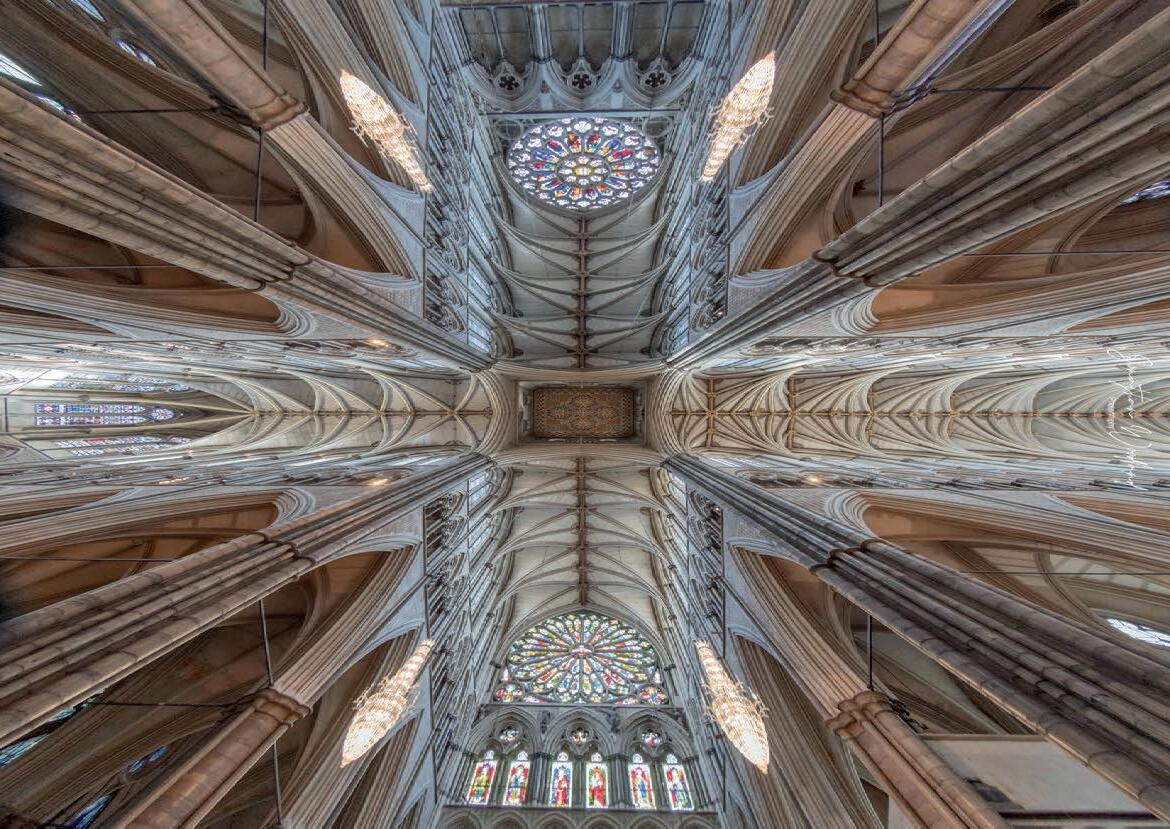CATHEDRAL MUSIC



Not only do we supply the best digital organs from four leading organ builders, but we publish our own organ music and carry the largest stock of sheet organ music with over 1,900 volumes on our shelves from a catalogue of over 11,000 titles. Why not visit us in Shaw (OL2 7DE) where you can park for free, browse, have a coffee, play and purchase sheet organ music or use our online shop at www.sheetorganmusic.co.uk.
ChurchOrganWorld … the one stop shop for organists

www.sheetorganmusic.co.uk



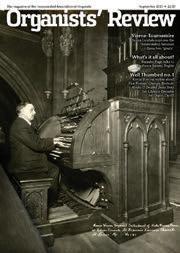

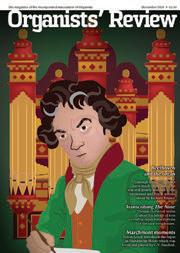

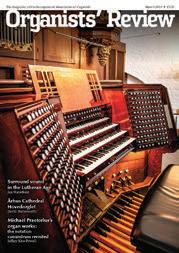





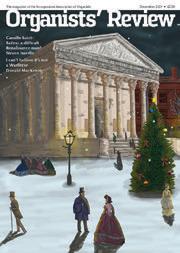

Occasionally I remark on longevity in cathedral music life, not necessarily looking at a life long lived but more at the number of years spent in post. Directors of Music are clearly not just for Christmas; consider James Lancelot at Durham (32), Jonathan Bielby at Wakefield (40), the Gedges at Brecon (40+), David Flood at Canterbury (32) and others. None, however, can trump Francis Jackson’s (mere) 36 years in post at York Minster – because he added to it a further 40 as a composer and recitalist thereafter. Consider his life and works, worthy of all the column inches garnered since his death in January this year, as described with affection and respect by Bret Johnson and Simon Lindley.
I didn’t mention in the list above, but could have, Richard Seal, who spent 29 years at Salisbury, and who was responsible for the introduction of the girls’ choir at the cathedral 30 years ago. Notice that I wisely don’t say ‘the first girls’ choir at a cathedral’ (I don’t want to get into deep water, nor do I want to raise the issue of girls in cathedral choirs again, since thankfully that boat sailed a long time ago). There is no doubt that his brainwave did gently nudge many other cathedrals into following the same route, meaning that now it is positively rare for cathedrals not to have a girls’ choir rather than the opposite. His reminiscences as relayed to Deborah Hooper, previously editor of CM’s sister newsletter Cathedral Voice, make fascinating reading.
Innovations in the cathedral music world can be hard to find. Since the first lockdown, however, musicians everywhere, and in particular choral musicians since singing was deemed a dangerous sport in the early days, have made very good use of the virtual world. Choirs are frequently pictured fragmented on screens, and great success has been made of online concerts by far-sighted groups such as Voces8 and the Gesualdo 6. Cathedral Music Trust is at the vanguard of this incursion with its seminal virtual conference, Joining the Dots, on how to celebrate and utilise collaboration in what is traditionally a somewhat disunified area. Clare Stevens writes cogently on the topics covered and the sessions offered — varied, wideranging and informative — by a host of influential people from an assortment of disciplines, including education, diversity and music. Thanks to hard work and preparation behind
the scenes by the Trust’s staff, the conference went seemingly effortlessly and, should you have missed any part of it, a video recording can be viewed on the website for a very small fee. It was striking to see the way in which music professionals from many different areas (geographic as well as intellectual) came together with a shared purpose — to help children from all backgrounds access the wonderful education that becoming a chorister offers, and how to achieve the best results for them through training and support.
A similar and perhaps unexpected enthusiasm for the chorister life has recently become noticeable in the Netherlands. Hanna Rijken, whose PhD dissertation is entitled ‘My Soul shall Magnify’ and who a few years ago set up a project called ‘Choral Evensong + Pub’ (!), documents the ways in which choral evensong has become popular in Dutch society and strives to ascertain the reason why — is it the beauty of the buildings? The glorious music? The venerable and mystical language (BCP 1662 is mainly used) — or something else? Read her article and see what you think.
Regular readers of the magazine will remember articles written by composer Phillip Cook over the last few years, most recently in CM 2/21 on Cecilia McDowall. Now you can go behind the scenes a little to find out about his own compositional and musical life as told to Jonathan Clinch, Lecturer in Academic Studies at the RAM; you can also, if you follow the links at the end of the article, read his fascinating blog (‘Composing is hard!’), which is well worth a visit, as is the rest of his website, where much of his music is available for download.
Another two composers are featured here — Philip Wilby, who writes not only on his own compositions but also more particularly on Matthew Owens, adviser to this magazine and DoM at Belfast Cathedral, who has championed new compositions of cathedral music over a number of years (his very successful programme ‘new music wells’ has been running since 2008 to great acclaim). Second is Alison Willis, whose competition-winning canticles were premiered at Derby’s October gathering last year. For obvious reasons these were not able to be performed until 2021. She gives fascinating insight into her compositional processes and musical background.
And finally… very sadly, the November issue of CM is likely to be my last. I have thoroughly enjoyed my 10+ years (decidedly falling short in comparison to most DoMs) as Editor of the magazine, and this is my 22nd issue – but it’s time for another body to fly the flag.
Sooty AsquithWE ARE STRONGER
Join our community of Friends and unlock a host of benefits while helping to support cathedrals and choral foundations across the UK.
More reasons to become a Friend
• Enjoy invitations to our Gatherings as part of our events programme
• Receive our acclaimed magazine Cathedral Music twice a year
• Delve deeper into the heart of cathedral music with our Friends newsletters and journals
• Help us nurture the next generation of cathedral musicians and enrich more lives through the power of music
To enjoy a year’s worth of insights and Friendship, visit www.cathedralmusictrust.org.uk or call 020 3151 6096
We ask for a suggested subscription of £25 per year to be a Friend of Cathedral Music, and all Friends are asked to consider donating over and above this to assist us in developing our work and increasing the funds we have available to award as grants to choral foundations.
Bret Johnson looks at choral and organ works by Dr Francis Jackson CBE (2 October 1917-10 January 2022), while Dr Simon Lindley offers some personal recollections.
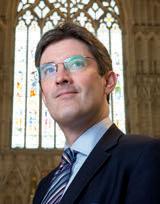

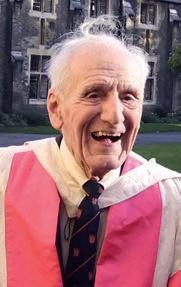
The heading is a slightly corny descant, you may think, on the title of Francis Jackson’s 2013 autobiography Music for a Long While (York Publications).1 To mastermind the production of a 400-page volume of memoirs at the age of 95, whilst still giving public organ recitals, fulfilling commissions for new anthems and organ pieces, as well as answering correspondence from his many admirers, surely bears witness to the life and example of one of the most enduring musicians this country has ever seen. Just a few months before, in 2012, he had been honoured by the award of a Lambeth doctorate of music, granted by the Archbishop of Canterbury to those who have given an exceptional lifetime of service to cathedral and church music.
What came across most strongly in Francis Jackson’s professional and personal life was his humility and reverence for the tradition and figures which had the most influence on him. A special place is reserved, of course, for Sir Edward Bairstow, his immediate predecessor at York Minster, with whom he worked and studied for many years, first as chorister and then as Assistant Organist, until Bairstow’s death in 1946. By many of the accounts I have read, Bairstow was a difficult, crusty and plain-speaking character. But if anyone has captured the essence of his music it is Jackson, right from the brilliant organ Impromptu he wrote as a 70th birthday present to his mentor in 1944 whilst on war service in Italy. Bairstow was in many ways ahead of his time as a composer: he would suddenly resort to diabolical harmonic chords (as in the 1937 E flat Organ Sonata) and growling bass figurations (as in the anthem Though I speak with the tongues of men). Jackson’s biography of Bairstow Blessed City 2 is a deeply sympathetic tribute to a musician whose memory he honoured throughout his life, and many of Jackson’s 160 or so published compositions acknowledge to some degree the continuing presence of this profound early influence.
FJ’s 100th birthday in October 2017 was marked by many celebrations, including a dinner attended by his two successors as Master of Music at York Minster, Philip Moore and Robert Sharpe, and on the occasion of his 104th birthday in October 2021 his former assistant at the Minster, John Scott Whiteley, compiled and uploaded an hour-long video of recent performances of several Jackson organ works and part songs.
Jackson’s fantastic organ technique ensured his international renown as a concert organist, and his many recordings so testify: for me, the most extraordinary of all is the 1964 Great Cathedral Organ series LP he made on the Minster organ which included several dramatic performances, especially the Introduction, Passacaglia and Fugue by his great friend Dr Healey Willan (1880-1968), the amazing Tuba Tune by Norman Cocker (both pieces make spectacular use of the Minster organ’s Tuba Mirabilis), and Jackson’s own Diversion for Mixtures, a spellbindingly virtuosic concert étude. How wonderful that in 2017 the whole Great Cathedral series was remastered and is now available on a 14-CD box set.3 Jackson dedicated another fine organ piece, the 1955 Toccata, Chorale and Fugue, to Healey Willan. In a recording of it he made in
the 1960s he said in the sleeve note that ‘its influences are mainly French, [featuring] the highly coloured harmonic language reminiscent of Cesar Franck’…. always conscious of his role in drawing on and in continuing a school or tradition. The Diversion for Mixtures mentioned above probably evokes Langlais and Dupré as well as Bairstow.
Like Herbert Howells before him, Francis Jackson composed extensively for choir and for organ. There are many musical parallels: both Howells and Jackson have a distinctive ceremonial style. I hear Howells (maybe the Sarabande for the Morning of Easter or the Paean) in Jackson’s Procession, Arabesque and Pageant (Three pieces for organ, 1955), not as an imitation but as an elaboration, extension and celebration. And in Jackson’s little-known but superbly evocative set of Evening Canticles in G minor, written for Leytonstone Parish Church in 1958, there are distinctive echoes of Howells’ Gloucester Service

Jackson’s organ works are brilliantly encapsulated in a set of recordings he made himself in the 1990s on the organs of Lincoln, York and Blackburn Cathedral, issued as a 4-CD set by Priory Records.4 This is a most comprehensive survey, featuring nearly 50 works including the first four sonatas. His six organ sonatas are the most notable British examples of the format since Mendelssohn (even Stanford only wrote five!). Each one has a most individual character: the first written for the new Walker organ in Blackburn Cathedral in 1970 evokes the 19th century and the spirit of Rheinberger in the opening movement, in the favoured key of G minor. The second, Sonata Giocosa from 1972, marked the restoration work at York Minster, and the disunity and uncertainty of the first two movements recall the deeply emotional Howells of the Psalm Preludes, whereas the final Gagliarda celebrates the joyous completion of the rebuild. Most appropriately, the spirit of hope is evoked at the height of the uncertainty in the form of a triumphant statement of the hymn tune ‘York’. The Third Sonata is transparent and neo-classical, leaning
towards Hindemith in flowing pastoral lines. The extended Fourth Sonata is one of the most remarkable and diverse of his organ pieces: Bairstow comes to mind in the perverse tritonic harmonies and frowning dissonances and maybe another great organist/composer, the American Leo Sowerby. Imposing edifices of symphonic and rhapsodic thought yield to passages of gentle impressionism (he acknowledges Ravel and Debussy as profound influences). We must not forget Vaughan Williams, of whom Jackson was a great admirer: the finale of his Five Preludes on English Hymn Tunes (1984) is based on VW’s ‘Sine nomine’ which we know, of course, as ‘For all the Saints’.
I remember hearing Dr Jackson play several times when I was a student: on the Walker organ in the Whitworth Hall at Manchester University and in Liverpool Anglican Cathedral when he gave the first performance of Prelude on an American Folk Hymn ‘Lonesome Valley’. That he was equally at home as a miniaturist is evident in his anthologies (the Hovingham Sketches for example) and other collections of shorter compositions.
There were also several part-songs, and a cantata, Daniel in Babylon, as well as two extended works for orchestra including his Symphony in D minor (1957), submitted for the Durham DMus, which so far has only been performed semi-professionally, and a Concerto for Organ Strings, Timpani and Celesta (Op. 64, 1984). The latter was broadcast by the BBC and has been recorded on Amphion Records with the composer as soloist. 5 It is a splendid work and one of a host of 20th-century British organ concertos which are deserving of revival (and commercial recording). The Jackson is scored for identical forces as the Poulenc Organ Concerto, and is a worthy companion.
Many of the choral works have been classics in choral repertoires for decades: the Evening Service in G, the Communion Service in G, the Benedicite in G, and the Hereford
Evening Canticles in F sharp. This latter was a 1961 commission, originally in a two-part setting (soprano/tenor and alto/bass) but so skilfully wrought that apparently when Sir John Dykes Bower (Organist of St Paul’s Cathedral) heard it he thought it was in four parts! (The composer did later arrange it for four voices.)
notable example of the triumphant Jackson choral style, and with a rare climactic conclusion.
Of the later choral pieces, special mention is due of the Missa Matris Dei (1988), one of ten settings of the Mass, written for Nicholas Danby and the Church of the Immaculate Conception, Farm Street in Mayfair. The Gloria has an ecstatic quality not only for voices but also in the dramatic organ accompaniment (so vital a part of much Jackson choral music) and the Evening Service ‘Homage to Thomas Weelkes’ in B flat (2005). This extended setting is in five parts and is notable for the incandescent Gloria to the Magnificat and especially the Amen, where the thrilling and triumphant cadence seems to hang in the air for ever. Of Three Carols for Advent (1989), Gabriel’s Message is a simple hymn melody, effectively elaborated in each succeeding verse.
A distinguished teacher may beget fame in his pupils and one such composition student was John Barry, whose long career as a film composer included such hits as Dances with Wolves and of course, the unforgettable James Bond scores.
I have often wondered how cathedral organists find time to compose and play recitals amidst all their administrative duties and the daily task of producing music for choral services. Jackson toured extensively as a recitalist in Europe and the UK and Australasia and in North America seven times (his early 1950s’ friendship with Healey Willan was especially productive in this respect). Dr Jackson stood down from Minster duties in 1982 after 36 years as Master of Music and his life as a musician simply carried on… but with even greater intensity! During his ‘retirement’ he composed and published over 90 works.
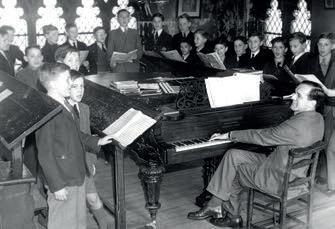
A good selection of the music he composed during those busy Minster years was featured in an 80th birthday tribute recording by Priory Records in 1997.6 Some truly remarkable music appears on this disc, including several extended anthems. Worthy of special mention are Sing a New Song to the Lord (1970), and especially Blow ye the trumpet in Zion, originally written for the Church of the Holy Sepulchre in Holborn in 1963 and later chosen by John Betjeman in his BBC series England’s Cathedrals and their Music (the whole of this recording can be found on the Archive of Recorded Church Music on YouTube). It is one of his most dramatic anthems from this period, nearly 10 minutes long, with repetitive trumpet fanfares and sustained high tessitura treble incantations. The dense harmonies recall not only the Howells of God is gone up and Exultate but also Flor Peeters, especially his five-part Missa Festiva. Also Remember for Good, O Father (1956) written, like so much of Jackson’s music at this time, at the instigation of the Dean of York, the Very Revd Edward Milner-White, for the dedication of an astronomical clock in the Minster in memory of the fallen of the RAF during the War. The long, plaintive phrases (including a solo quartet) and hushed harmonics could not be in greater contrast to Blow ye the trumpet. And Audi, filia, sung at its composer’s wedding in 1950 and dedicated to his bride Priscilla, sets words from Psalm 45; its distinctly tender, feminine character is immediately attractive. Of the shorter pieces also presented is a punchy Jubilate written for the 1964 Leeds Festival, for which he also wrote a Te Deum. Another Te Deum, in D, composed for St Mary’s Episcopal Cathedral in Edinburgh’s centenary in 1979, is yet another
Both the Bairstow biography and Jackson’s own autobiography make for most absorbing reading. His open, easy style of writing throws a warm light on the countless aspects of his musical life, as well as generous accounts of early family experiences, his marriage to Priscilla and his children as well as kindly tributes to fellow musicians, countless anecdotes and the occasional gentle ribbing! There is a good discography and list of works at the end, and many photographic plates, several in full colour. An index would have provided a helpful directory of people and places and if that could be included in a future edition it would enhance enjoyment yet further.
I can only conclude with the final words of Dr Jackson’s autobiography: ‘It has been a good innings and far better than I could have imagined’. Amen to that… and we rejoice in a very long life well lived, one that has enriched our heritage and will continue to do so for many years to come.
NOTES
1 Music for a Long While (York Publications: www.yps-publishing.co.uk)
2 Blessed City: The Life and Music of Edward Bairstow (www.prestomusic.com)

3 Warner Classics 50999 0 85295 2 7
4 Priory Records PRCD 930
5 Amphion Recordings PHI CD 155 (www.amphion-recordings.com)
6 Priory Records PRCD 611
The modest self-description of a truly great man as ‘a lad from the Wolds’ has featured in recent coverage of Francis Jackson, who died on 10 January 2022 at the venerable age of 104.

Venerable, most certainly he must be accounted to have been – highly esteemed, respected and greatly loved by a vast public, quite clearly. The number present in York Minster, as well as a huge tally of viewers to the Minster’s YouTube channel during and following his obsequies attest to this.
The service included a scripture reading from Francis’s Minster successor, Dr Philip Moore, two hymns [‘God, that madest earth and heaven’ and ‘How shall I sing that majesty’ to Francis’s own melody, East Acklam, originally composed for Heber’s and Whatley’s verses and Ken Naylor’s Coe Fen], extracts from Croft’s memorable Burial Sentences, Psalm 91 to a chant by E J Hopkins – each exquisitely rendered –and anthems by S S Wesley – from the central portion of his extended doctoral exercise, O Lord, Thou art my God came music from his mentor Sir Edward Bairstow – the highly characteristic setting of music by Orlando Gibbons [Song 13] to a translation of a Latin text by Sir H W Baker, Jesu grant me this, I pray. The present-day Minster choir delivered Francis’s choice of music of the highest calibre and standard under inspirational direction from Robert Sharpe.
Ben Morris played brilliantly throughout – the restored Harrison featuring spectacularly in the hymns and the thrilling S S Wesley anthem, with music before the service including FJ’s own Prelude on ‘East Acklam’ and the Bach St Anne fugue at the end. During the postlude FJ was borne from the Minster on the start of his final journey. As the Bach drew to its close, Precentor Canon Victoria Johnson accompanied the extensive number of family members recessing from the eastern end of the nave to the west door.
Still in office at the Minster as Organist Emeritus at the time of his death – a title held for 40 years consecutively following his 36 as Master of the Music from 1946 in succession to his mentor, Sir Edward Bairstow – the events of Francis’s busy and lengthy ‘retirement’ evinced much concern with, and for, the personal and professional relationships he had sustained with such commitment for so very long.
The ‘good doctor’ had a rare and wholly unconditional gift for friendship. His gentle demeanour, inimitable vocal timbre, raised eyebrows and masterly use of written and spoken English all came as seemingly naturally and effortlessly as did his prodigious musical and artistic gifts.
By his own calculations (recounted in the autobiography Music for a long while published in 2013), the tally of his solo organ
concerts numbered 2,016. Among the last events he played in public were a memorable summer evening Minster recital and a lunchtime concert in the early autumn at Bradford Cathedral. The concluding piece was Bairstow’s Prelude in C as that latter’s ‘swan-song’.
The number of recitals after leaving full-time work at the Minster was very extensive; no less so was an astonishing Indian summer of composition, with many works emanating from the pen of this ‘ready writer’, to quote a memorably apt phrase from the psalmist, mostly commissioned by friends and colleagues old and new ‘in quires and places where they sing’.
In terms of texts for sacred choral works, it seems that his canticle and other liturgical service settings date from the prototype Benedicite in G just post-war – an early project encouraged by Eric Milner-White, Dean of York from 1943 to 1968. This corpus has achieved rather greater public prominence than the far greater (numerically speaking) 100+ anthems following on from a hymn anthem Ave, Maria, blessed Maid published in the late 1940s by the Faith Press
The ‘anthem’ category includes a number of carols and settings of music for Benediction. His compositional catalogue also reminds one of just about a ‘baker’s dozen’ of beautifully crafted solo songs with secular texts and exquisite piano accompaniments, of which perhaps the finest is a setting of Robert Frost’s evocative stanzas Tree at my window written in 1943. There are also works for organ and solo instruments, a concerto and a symphony as well as a great number of pieces for solo organ.
Dr Jackson’s long friendship with actor-dramatist John Stuart Anderson produced two spectacular works bearing the
intriguing title of Monodrama with Music – Daniel in Babylon for the 1962 festival arranged to celebrate the opening of Coventry Cathedral and, a little later, A Time of Fire [originally Tyndale – A comedy of sorts] for the Norwich Festival. The former included inter-scene Motets, mostly but not all unaccompanied, while the latter has rather more throughcomposed material for choir throughout. Interestingly, William, the elder of Francis’s two sons, bears both Tyndale and Procter as middle names – Tyndale Procter, prominent as a member of the York Society of Friends, being his maternal grandfather.
Continuing briefly on family matters, both Jackson boys were choristers at St George’s Chapel Windsor, under Sidney Campbell, while no fewer than three Jackson grandchildren (Sam, Grace and Thomas) were each Minster choristers.
The memorable address at the Doctor’s funeral, delivered extempore in affectionate terms by Bishop Glyn Webster, for long a Chapter clerical colleague, contained a nice touch: a reference to the arrival of the latest great-grandchild, Edward, via a misquotation from scripture: ‘in the midst of death we are in life’. (Sam and his wife’s latest offspring had arrived between his great-grandfather’s passing and the funeral.)
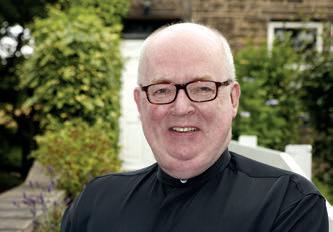
The Fanfare for Francis produced by the Finzi Trust for Dr Jackson’s 90th birthday serves as proof positive of the returned affection and regard of professional as well as personal friends, and some contributions have achieved later embellishment and enlargement.
Honours unexpected, yet richly deserved and received very late in life, included an honorary doctorate in music from the Archbishop of Canterbury and that of honorary patron of the Burgon Society for the study of academic dress among them. Musicians with long memories will recall the brown dullness of the hues half a century back of the Royal College of Organists’ diploma hoods which were banished on Francis’s enthusiastic and expert advice in favour of the richer tones of rose-pink and gold now well in evidence today.
With that epoch-changing specification, this personal recollection comes, visually, full circle as it were, recalling a very great individual. Memory eternal.
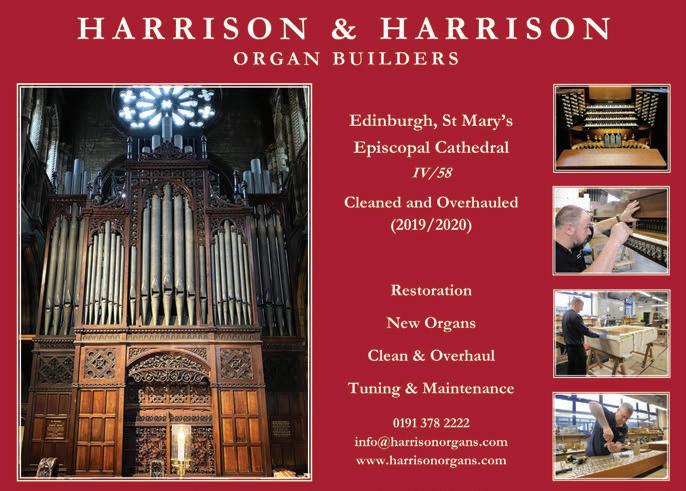


There is no history of music-making in my family, although my grandfather (who I never met), allegedly used to play what was fondly referred to as You WILL Buy My Pretty Flowers with great force and determination on a Saturday evening. Fortunately, my mother decided that I should have piano lessons with Mrs Parish, one of the two piano teachers in the village, and I benefited from a very solid ABRSM musical upbringing, a grade a year, aural training, Grade V Theory (utterly incomprehensible, who remembers the little red Rudiments of Theory book?) in order to progress to Grade VI and for this I remain profoundly grateful.
My own choir, Great St Mary’s, was of an excellent standard. We had a very good choral director and sang a wide range of music. I quickly became chief page-turner for the voluntaries and was soon offered lessons. Our organist, Michael Cubbage, was an outstanding musician – indeed, had the war not intervened I think he would have been a cathedral organist. Our parish church was treated to an extraordinary feast of music at his hands (and feet). Particular highlights for me were Alain’s Litanies, Franck’s Pièce héroïque and Bach’s Passacaglia and Fugue in C Minor. As (by far) the youngest member of the Harlow Organ Club I had the opportunity, usually arranged by Michael, to play several cathedral organs, a privilege I took rather for granted at the time. Through these experiences I gained a solid grounding in the English choral tradition and the great organ repertoire. I did not fully appreciate at the time what a lasting impact this would have on my future work.
I had composition lessons with Paul Burrell whilst at school after winning the Harlow Chorus Carol Competition (another surprise for my mother, who didn’t know I wrote music), then continued my composition studies with tutorials from Sir George Benjamin at RCM, briefly at RNCM then at Colchester with Alan Bullard. The choral singing and organ-playing fell rather by the wayside as I focused on composition and piano, having pieces workshopped and performed by ensembles including Gemini, the London Sinfonietta and the LSO.
There was also no history of churchgoing in my family, so my parents were probably slightly perplexed when as a teenager I joined the church choir in the village. As a family we had recently holidayed in Somerset and, having admired the excellent fan-vaulting in the chapter house at Wells, I clearly remember hearing the cathedral choir rehearsing. I had never heard anything so beautiful, and this was a defining moment for me as a musician.

I then met my husband and had several children in very quick succession and, although I continued to compose, they turned out to be quite time-consuming. The work I produced when they were (rarely) all asleep at the same time may not have been my best; however, as the children grew, I found more time to write properly, rediscovered my love of choir and organ music and started receiving commissions and performances again. I like to call this my own personal and compositional renaissance. Most of my recent compositional output is for choir and organ or piano, but I also enjoy writing for solo voice and for instrumental ensembles. My music has been described as ‘beautiful yet pragmatic’, and as a singer

and multi-instrumentalist I make it a policy to sing or play everything I write where possible.
There are three main influences on my choral writing: the chants and texts of the medieval era, re-voicing women through forgotten texts/narratives, and English folk music, specifically unaccompanied song. Much of my choral writing is rooted in plainchant with a penchant for non-pitch-specific chants such as those of Old Hispanic Office celebrated in medieval Iberia that escaped the liturgical unification of the late eighth century. In 2017 I was one of three choral composers invited to develop new works for Bristol Cathedral choir and Christ Church Cathedral choir, re-imagining elements of the Old Hispanic Office as part of a European Research Councilfunded composition residency in Bristol led by Dr Emma Hornby. This resulted in the Vespers, Inspired by the Medieval Old Hispanic Office that includes three anthems and a set of Preces and Responses. The nature of non-pitch-specific chant is that, whilst the neumes (the early musical notation indicated above the Latin text) give an indication of the direction of the line and possible cadence points, these are, as the name suggests, not at specific pitches. As a composer this gave me the chance to experiment with the impact of different modes on the chant. To me, these modes imbue a different ‘colour’ to the sound and create interesting possibilities for dissonance and false relations.

I find that the raised fourth of the Lydian mode is light and bright, whereas the opening minor second of the Phrygian is dark. At Derby this raised the question of whether I think of music in colour, a phenomenon known as synaesthesia. For me, E minor is and always has been green, A major is red, D major is blue and so on. These are not conscious allocations; at no point did I decide what colour each key was, but these ‘colours’ certainly have an impact on the key in which I choose to write – so maybe I am a synaesthete after all!
Another musical influence of my research into the Old Hispanic Rite is the ‘jubilus’ (the long melisma placed on the final syllable of the ‘alleluia’ in Gregorian chant). Dr Hornby, in her exploration of the impact on these chants by Spanish cleric and scholar Isidore of Seville (c.560636), suggests that ‘Textless melody on “alleluia” and other praising words was understood in medieval Iberia as joining the devout with the angels.’1 This relates back to my teenage moment of enlightenment at Wells, was very much part of my inspiration for the Vespers and is also reflected in subsequent pieces including A rose hath borne a lily white and Salve Deus, rex judaeorum (Hail, Lord, King of the Jews). I am also drawn to medieval texts, especially carols such as I sing of a maiden and There is no rose, both for the beauty and rhythm of the language and the colour of the imagery and narrative where I find there is a real crossover with the English folk tradition in terms of structure, narrative and modality.
The second main influence on my work is re-voicing women. By this I do not mean reintroducing the work of largely forgotten women composers, although this is vital work currently being championed by organisations including Multitude of Voyces with their three-volume Anthology of Sacred Music by Women Composers and the Illuminate series of concerts curated by Dr Angela Slater. Rather, it is breathing life into texts written by women and narratives about them that have been lost in history. One part of this is my interest in Marian
texts which encompass the afore-mentioned carols, prayers, antiphons and of course the Magnificat. I have just completed a substantial new commissioned piece, The Canticle of Mary, combining little-known medieval carol texts for SATB choir and organ with a new poem by Charles Anthony Silvestri, set for solo soprano commenting on the nativity from Mary’s perspective. Sadly, the piece has not yet been performed due to Covid-19. Salve Deus, rex judaeorum, (written for Hampshire choir Luminosa, organ, soprano solo and optional bell) was another casualty of the pandemic, being originally scheduled for premiere on 28th March 2020… timing, they say, is everything! I am delighted that it will now receive its premiere two years later in April this year.
Salve Deus, rex judaeorum sets parts of the text by the same name published as the central part of a book of poems in 1611 by Aemilia Lanyer, the first woman to have a book of poems published under her own name. The poem tells the Passion story through the eyes of Pilate’s wife, a solo soprano in my setting, and Lanyer’s words are beautiful, including phrases such as ‘The sun grew darke and scorned to give them light, the moon and stares did hide themselves for shame’. It is important to me as a composer to shine a light on these forgotten texts and narratives, and I have also recently set texts such as Gold and Spices by Christina Rossetti and the intensely moving secular poem Non omnis moriar written by the Polish poet Zuzanna Ginczanka, who was executed as a Jew in 1945, premiered by the BBC Singers in 2019.
The third significant influence on my work is English folk music. When I was a lapsed choral singer and organist at music college I discovered English folk music, joining a band as third guitarist before remembering I had spent my life savings on a piano accordion when I was eight before abandoning it to a cupboard as I had no idea how to play it or to find someone who could teach me. I retrieved it and haven’t looked back since! Whilst I enjoy playing the tunes from the UK and beyond, especially those of England, my especial passion is the unaccompanied song of our English tradition. To some extent this combines many of the elements discussed above. Most folk song is modal, and unaccompanied singing gives the freedom to vary tempi, placement of words and even tonality in order to convey the narrative in the most colourful way to the listeners in any given rendition, the tune again being ‘the handmaid’ of the text. My Anglican choral upbringing included chanting the psalms, and this collocation between the freedom of rhythm in unaccompanied folksong and the speech rhythms of the pointed psalms is something that I use extensively in my writing. I am prepared to admit that sometimes my scores look as if they will be complicated to
My music has been described as ‘beautiful yet pragmatic’, and as a singer and multiinstrumentalist I make it a policy to sing or play everything I write where possible.
sing – due to frequently changing or irregular time signatures – but these are only ever there to serve the text and make it audible and understandable; indeed, music is ‘the handmaid of the liturgy’ as written by Dr Victoria Johnson in CM 2/21! It is true to say that the most frequent comment I hear about my choral work is how very ‘singable’ it is. As already mentioned, I do sing every line I write and if I can’t pitch it or make sense of the rhythm, I don’t feel I can ask anyone else to.

Returning to women’s voices, when it comes to setting a Magnificat I find I have two different approaches. The first and more traditional is celebratory, with Mary, on receiving the news that she is to be the mother of the Christ Child, overcome with joy. The second approach, one that I explore in my Magnificat and Nunc Dimittis in Db and further in The Canticle of Mary, is more reflective. Mary, a young girl betrothed to a much older man, finds she is expecting a child that is clearly not her future husband’s. He, understandably, may not initially be thrilled at this prospect and sends her away to her cousin Elizabeth – as Tony Silvestri says: ‘To my cousin in the hills of Judah I went away, sent away, to hide my husband’s shame’. Indeed, in the 15th-century Cherry Tree Carol Joseph challenges his young wife, saying,
‘O then bespoke Joseph with words so unkind, ‘Let him pluck thee a cherry that brought thee with child.’2
although once the angel reassures him that the child is the child of God, all is well. This ‘Song of Mary’ can therefore be set in different ways and my commitment to re-voicing women means I like to consider both approaches. I also find my passion for unaccompanied song impacts on the way I set these words, so unusual for being spoken first person by a female. The Nunc Dimittis is one of my favourite of all liturgical texts. Evensong and its sense of deep reflective peace were the bedrock of my choral experience. I also find the shape of the text deeply satisfying, with its gentle start building to exaltation and glory in the doxology.
The Magnificat of the Derby Service takes the celebratory approach. It opens at a sprightly tempo in bright D major with an organ ostinato featuring major sevenths in the harmony over a dominant pedal of A. This ‘Song of Mary’ starts with upper voices, sopranos who then divide before being joined by the altos, telling Mary’s cousin Elizabeth of her joyous news, with the rest of the choir not joining until the words ‘For he that is mighty’. The word ‘holy’ takes the divisi sopranos to the top of their range with an overlapping Lydian descending scale motif redolent of Isidore of Seville’s ‘jubilus’ before the colour changes. The organ picks up the raised fourth in ostinato, suggesting the hope of the words ‘and his mercy’ whilst the flattened seventh, in this case an A, darkens the sound, maybe reflecting the alternate more questioning approach discussed earlier with a deliberate dissonance on the word ‘fear’. There is a flurry of imitative movement at ‘He hath scattered the proud’, a good example of writing that looks complicated due to its changing time signatures but makes perfect sense of the words when sung. Upper and lower voices alternate as the organ ostinato motif continues and develops before coming together and building up to full harmony as we reach the word ‘Abraham’, leading back to the opening organ motif in the original key for the doxology. Unison voices sing the line from the opening of the Magnificat, flowering into increasingly full harmony at ‘As it
was in the beginning’ and concluding with a blaze of glory on the repeated ‘Amens’, set to an A major triad with the raised fourth from the Lydian mode used earlier, an added second and some crunchy dissonant lines from the pedals (which must be credited to Alexander Binns, Director of Music at Derby and Tim Rogers of Encore Publications; many thanks, gentlemen, a huge improvement!)
As one would expect, the Nunc Dimittis is very different in character, although it does share significant musical material with the Magnificat. It opens with gentle creeping cluster chords with a suggested soft 8’ on Swell and 16’ Pedal. Again, initial impressions may be that this is difficult to play but I wrote this while at the organ and find it quite enjoyable myself… despite the sub-zero temperatures the day I wrote it! The sopranos and altos enter in unison with a floating reflective line which opens into SATB harmony on ‘For mine eyes…’. The words ‘which thou hast prepared’ borrow material from the Magnificat, also echoing the build in texture before an explosion of sound, again related to the concept of the ‘jubilus’ on the word ‘light’, leading to repeated ‘Glorys’
based on the ‘Amen’ chords. The doxology returns to the quietness of the opening with all voices in unison until ‘As it was…’, which starts the build-up to the final ‘Amens’. These share the chords and pedal lines of the Magnificat but this time become quieter on each repetition and fade back into the peace of the evening light.
The Derby Service is in many ways a synthesis of the elements that influence my writing, the Marian text, the modal influences combined with occasional dissonance and the strong narrative melodic lines that create the different colours within the text. My heartfelt thanks go to Alexander Binns, the choir of Derby Cathedral, organist Edward Turner, Tim Rogers at Encore Publications and all at Cathedral Music Trust for such a wonderful first performance and for making me so welcome at the Derby Gathering. I think we all hope that The Derby Service will find its place in church music for many years to come.
Alison Willis (b.1971) is an award-winning composer whose works have been performed and broadcast internationally. Her music has been described as ‘stunning’, and ‘intensely moving’. She finds particular inspiration in historical sources and events, and enjoys working collaboratively with both young people and adults. She is an experienced pianist, organist, folk musician and musical director, enjoys composing music for theatre, and is a trustee of the Martin Read Foundation, which supports young composers. For more information visit www.alisonwillis.com or Alison’s YouTube channel, Alison Willis Composer.
Links to a performance of the Derby Canticles sung by Derby Cathedral choir
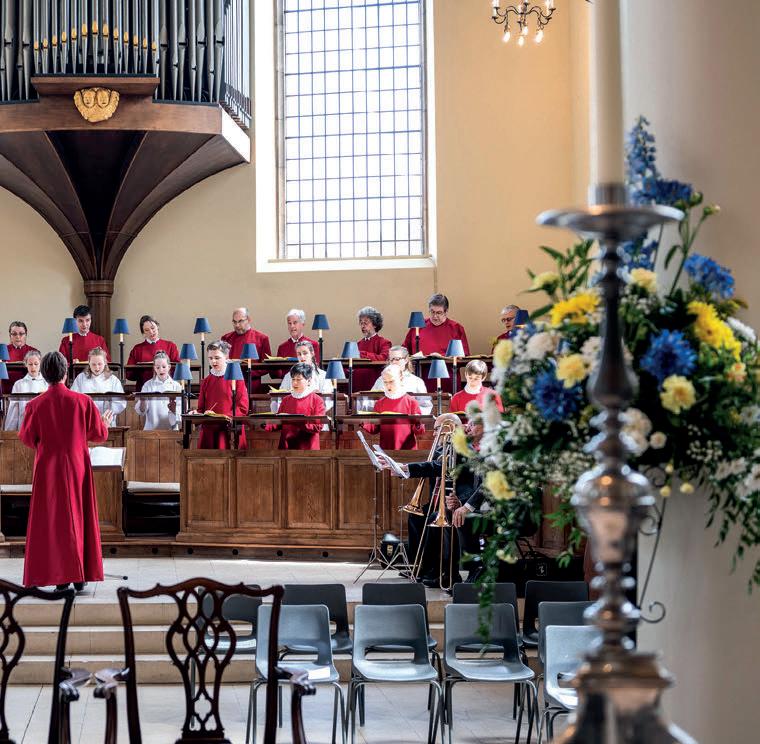
www.youtube.com/watch?v=YhVFvmvcxEU
www.youtube.com/watch?v=HagN3BI3EOM
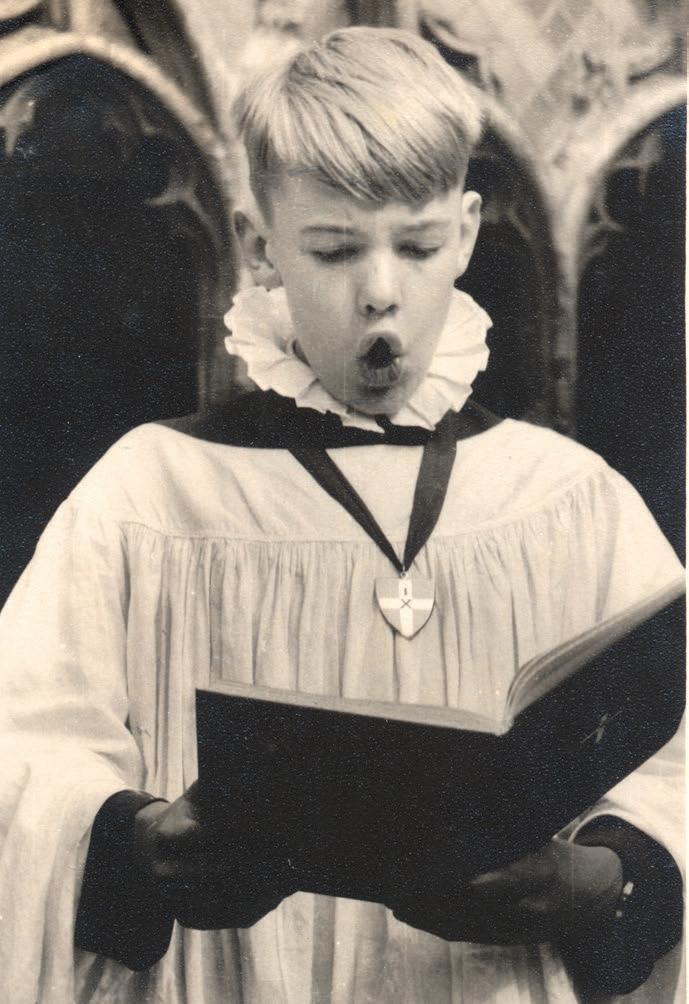

Some readers may remember my father, Maxwell Menzies, who was organist at St Michael’s College, Tenbury and subsequently at Portsmouth Cathedral. He introduced me to Gerald Knight of RSCM fame who was organist when I first went to Canterbury in 1951.
My main influence was Clive Pare, the headmaster of the choir school. He had a fine alto voice as a former King’s College choral scholar. He originally inspired my strong Christian faith in preparing me for confirmation.
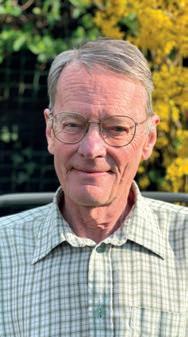
My musical memories start with singing Christian music and especially the daily psalms, which have remained very important to me. Because of the size of the choir we didn’t sing every day; only the senior 16 boys sang on Saturdays and Sundays.
The music we sang in those days was very conventional, mostly 19th and early 20th-century. I do recall 16th and 17th-century service settings and anthems, but I can’t remember many first performances of 20th-century pieces.
My five years as a chorister finished when Sidney Campbell arrived at Canterbury in my final term when I was senior chorister. Sidney was, as many readers will recall, a fine organist and choir trainer. We did start singing some more up-to-date music at that point.
One of the highlights of my time at Canterbury was singing in The Man from Tuscany at the Royal Festival Hall. This was a domestic operetta about J S Bach and his sons by Antony Hopkins, of Talking about Music fame. The libretto was by Christopher Hassall who was, by coincidence, educated at St Michael’s. I wonder if any readers have come across it being performed again.
My time at Canterbury helped me greatly in my future life. The discipline and teamwork in the choir contributed positively to my future legal career. Musically, I became a semi-professional flautist and a choral scholar at Christ Church Oxford. I met my future wife in a Christian choir. In the early 1980s I helped to found the Berkshire Young Musicians Trust (now known as Berkshire Maestros), which still provides high quality music opportunities and education in schools and centres across the county.
On the lighter side, I can remember many Dinky Car races in the long choir-school passages, model trains at Christmas, lots of marble and Monopoly games as well as rubbers of bridge with the headmaster. I recall many cinema visits and going to see The Mousetrap in London in 1955. We also visited Glyndebourne on a number of occasions to listen to afternoon rehearsals.
I do hope readers of this short article who have had a similar background will enjoy recounting treasured memories of their own.
If there were any doubts about the Friends of Cathedral Music’s recent reinvention of its public profile as a component part of the Cathedral Music Trust, and its investment in recruiting a dynamic new team of professional staff, these should have been thoroughly dispelled by the success of its first virtual conference, Joining the Dots, held online on 18 and 19 January.

Thorough planning, efficient delivery and engaging presentation were testimony to the wisdom of the new approach. The organisation was able to communicate very effectively with a wide audience, at minimal cost to delegates. For a registration fee of just £10 they could experience, to quote a tweet from The Sixteen, ‘Two days of wonderful webinars, discussions, and opportunities to pause, think and refresh’ their perspectives, without having to pay for travel or accommodation or schedule any more time into their diaries than it took to watch the relevant sessions.
‘Joining the Dots’ certainly did what it said on the tin, connecting musicians, teachers and clergy from churches, schools and the world of concert performance, not to mention funding bodies and individual supporters. More than anything, perhaps, it blurred the boundaries between those categories in a way that is sometimes difficult to do in daily life. One of the strongest messages that came out of the conference was an appeal to everyone involved in church music to try to rid themselves of the ‘silo mentality’ that comes from focusing
solely on one’s own essential tasks, and to see colleagues in other departments or institutions as collaborative partners. As the sessions unfolded, delegates were given many inspiring illustrations of how that can be achieved.
The conference began on a wonderfully positive note, with a keynote presentation by Simon Toyne, Executive Director of Music of the David Ross Education Trust (DRET). In his current role he is responsible for the development of a music programme for over 13,000 children across 34 state primary and secondary schools in the East Midlands, and his work in that capacity has included establishing the award-winning Singing Schools programme for primary schools, developing a Trust-wide primary and secondary music curriculum, and, most relevantly for this conference, fostering a network of partner organisations, including Gabrieli Roar, Nevill Holt Opera, Sing Up, the Royal Opera House and the Voices Foundation, enabling young people in the region to benefit from the skills of a wide range of professional performers and teachers.
Toyne is himself a former chorister of Exeter Cathedral, music scholar of Eton College, organ scholar of University College Oxford, and Director of Music at both Kingston Parish Church and Tiffin School. For 24 years he was Director of the Tiffin Boys’ Choir, famous for its appearances on the opera and concert stage with some of the world’s leading conductors, so he is well placed to facilitate connections between different branches of music and music education.
The liturgy has been there for hundreds of years, the music has been written for children like you to sing – it’s hard, but you can do it – you have a responsibility for carrying that tradition forward. (Simon Toyne)
His presentation touched on the forthcoming National Plan for Music Education in England and the role of music education hubs, making the point that church musicians do need to be aware of such initiatives and how they affect their choristers, or at least those educated in the state system, and can provide opportunities for collaboration. (The devolved nations of course have their own music education policies, and Wales in particular is currently in the process of changing its approach, giving greater emphasis to the arts.)
Developing a more rhapsodic theme, however, Toyne identified himself as a product of the scholarship system and reminded delegates of the impact upon a child or teenager of singing and learning in extraordinary cathedral, church and school buildings; being surrounded by beauty every day, in architecture, words and music; and how that can shape them for life; not to mention the importance of the sense of being part of a community and a tradition engendered by the chorister experience:
Acknowledging that the sense of wonder the public often experiences when hearing church music brilliantly performed at Christmas or on television at a royal wedding can also create an impenetrable barrier between them and what feels like another world, Toyne said it was up to everyone involved in music for worship to help break down those barriers. As proof that this can be done, he introduced Lufuno Ndou, a professional singer recently graduated from the Royal Birmingham Conservatoire, who eloquently explained how she owes her choice of career entirely to being invited by a schoolfriend to join a choir rehearsal at St Matthew’s, Northampton. “I fell in love instantly,” she declared. “Until then I had only heard that sort of music in films. I had thought, ‘I could never do that’ – but suddenly there I was, in the middle of it.
“Looking back, I realise that was unprecedented. Children would normally discover church music through a ‘Chorister for a Day’ session or something and an audition, but there I was in the middle of it. I come from an African culture where people sing all the time, but not like that.”
Ndou’s account of how she joined the choir, learned to sightread by osmosis and went on to music college followed
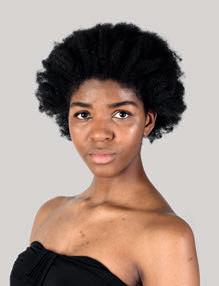
by a year as alto choral scholar teaching choristers at Truro Cathedral deserves an article to itself. Pre-empting some of the conference’s later sessions on diversity, she was very frank and eloquent about the issues, and the need to confront them head-on, both when encouraging young people from diverse backgrounds try something new, and when introducing music by historically under-represented and marginalised composers.
This packed session also included a conversation with Bridget Whyte, chief executive of Music Mark, formed in 2012/13 as a merger between The Federation of Music Services (FMS) and the National Association of Music Educators (NAME).
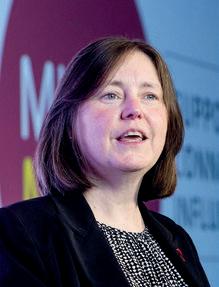
The main topic was how cathedrals and choir schools can contribute to the work of hubs and music services, which fall within Music Mark’s remit, but Whyte’s many previous roles in music education have included close involvement with the Sing Up initiative, at a time when that included the launch of the Chorister Outreach Programme. This latter has now closed, but leaves a strong legacy; Sing Up carries on, and of course many cathedrals continue their own outreach projects. Whyte provided valuable insights as a result of her background knowledge, but also spoke movingly of her own personal experience, brought up as an instrumentalist through the youth orchestra system, of attending services at Guildford Cathedral as a student because she knew people in the choir: “I didn’t come from a Christian family but I loved it and ended up being baptised and confirmed. Then I worked on Sing Up and two strands of my life came together, choristers and their music, and music in schools.”
Paul McCreesh, founder and artistic director of the Gabrieli Consort & Players, also does not come from a church music background, but he passionately believes that all children have a right to experience the great sacred works of the choral and orchestral repertoire for themselves, not just as listeners but as participants. His ‘Gabrieli Roar’ project involves inviting them to learn the music of oratorios such as Mendelssohn’s Elijah, Britten’s War Requiem or, currently, Haydn’s Creation in their own school or independent choirs and then rehearse and perform these pieces with Gabrieli’s professional singers and orchestra.

McCreesh shared some short films of a Roar performance and of Martin Howarth, Head of Music at Egglescliffe School on Teesside, talking about what the project offers to his pupils that went far beyond what even a well-resourced state school like his, where music is valued, can provide. Emphasising that he has high expectations of the participants, McCreesh said, “Children like hard work”, quoting one recalcitrant teenager who looked at the score he was given, assumed it was going to be ‘160 pages of hell’, but admitted after four days of very hard work that he had just experienced ‘160 pages of heaven’.
He also believes that performing in huge, awe-inspiring churches such as Romsey Abbey or Ely Cathedral is an essential part of the Roar experience. “There is something special about the world of religion and the beauty of these heartlifting buildings. They are designed for you to walk through the west door and get that sense of uplift. Most children don’t ever have a chance to do that, but it gives them a sense of history that is important and relevant for atheists as well as for religious people. They can sing a piece of plainsong that may be older than the medieval cathedral they are standing in and feel a connection with the past. It is a cultural experience they can’t have in a classroom, and they shouldn’t be excluded from it.”

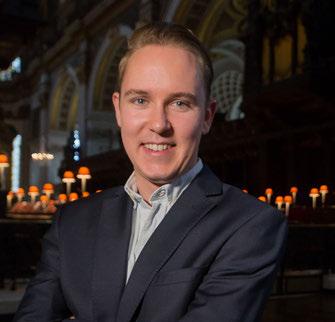
Pedagogy experts Don Gillthorpe and Catherine Beddison took an in-depth look at the chorister’s learning journey and explored ways to create the most effective learning environment, in their session on The Whole Chorister. Gillthorpe is assistant principal at Ripley St Thomas Church of England Academy in Lancaster, and Director of Music at Lancaster Priory; Beddison is Deputy Head (Operational) at Cranleigh Preparatory School, Surrey, where she also conducts the choir and the choral society. Both are involved with the Sing for Pleasure organisation, and although they are based at opposite ends of England and work in very different schools, their friendship dates from attending the Morland Camp together as choristers.
Important points to come out of their session included the need to understand the different ways in which children develop their musicianship and related skills at school, where they are usually taught in a very focused, stage-by-stage way, and at church, where they often learn by osmosis how to find their way round a hymn book or a piece of sheet music, as well as absorbing a huge repertoire by ear as they gradually learn to read the score for themselves. Choir-school pupils have to negotiate the relationship between cathedral and school; choristers who don’t attend choir schools may find that their musical ability goes unnoticed or underestimated by teachers who know nothing about church music and do not realise that their pupils’ knowledge of some repertoire and even their understanding of musical theory may well outstrip their own.
“Children like responsibility and challenges,” said Beddison, “but sometimes they have to deal with conflicting or overwhelming expectations from parents, teachers, and choir directors; it is the job of the adults to help them deal with that.”
Gillthorpe underlined the fact that children recognise quality and don’t want to be patronised; they know whether they have performed well or not, and they may be more proud of themselves for performing well or singing something

unusual in a normal evensong than they are when they do a commercial recording. He also pointed out the value of the repetitive liturgical cycle as a learning tool; seasonal repertoire comes round again and again, and becomes more familiar each time to choristers as they progress through the choir hierarchy.
There was a lot of very useful signposting in this session, both to pedagogical theory with which musicians without professional teaching qualifications may not be familiar, and to helpful professional organisations such as the Music Teachers’ Association (of which Gillthorpe is the current President), Sing for Pleasure, the RSCM and the Association of British Choral Directors.
A more objective perspective from someone outside the choral music sector came from Rob Adediran, a graduate of the Royal Academy of Music who has worked with concert halls and orchestras as well as leading an inclusion-focused music education charity in London for several years before broadening his horizons to work more generally as a consultant on diversity.

He introduced his session by pointing out that people make many assumptions about a person from the moment of meeting, unconsciously treating people differently because of height (or lack of it), colour of skin, the wearing of glasses (signifies cleverness!). However, he also drew on his experience of belatedly discovering his ability as a rugby player at a school where his team-mates quickly sized up his strengths and weaknesses, and worked together to compensate for his weakness at catching, while giving him space to assert his speed and strength. The result was a successful team where he felt at ease. But when he tried to build on this by joining a rugby club, he discovered that the other players were not prepared to give and take in the same way, so there was no place for him in that team. He was too modest to hammer home the point, but that meant the club didn’t benefit from his proven skills.
Adediran’s central point was that equality, diversity and inclusion need to be at the heart of any organisation, not just because that is morally right, but because it inculcates in everyone a sense of belonging, and that in turn leads to high performance.
The second day of ‘Joining the Dots’ began with a session entitled ‘Shaping your cathedral music eco-system in a postCovid world’. It was chaired by Tansy Castledine, Director of Music at Peterborough Cathedral, with Christopher Gray, Director of Music at Truro, Dr Victoria Johnson, Precentor at York Minster, Hugh Morris, Director of the RSCM, Natasha Morris, Development Director at Cathedral Music Trust and Stephen Moore, Director of Music at Llandaff Cathedral. They looked back at their own experiences of the pandemic, and how they and their colleagues responded to the unprecedented challenges to cathedral music departments. The intention was for them to review how the sector has weathered the storm, evaluate what we have all learned through the experience and look forward, exploring how musicians and clergy can make courageous choices to ensure a sustainable and vibrant future.
That was exactly what they did, but the session is difficult to summarise, as every contribution was so vivid and valuable. It was both distressing and cathartic, I suspect for speakers and listeners alike, to be taken back to those weeks in March 2020 when, as Moore said, the rhythm of cathedral life drew to ‘a shuddering halt’; to be reminded of how many senior boy and girl choristers were sent home supposedly for a few weeks, but as it turned out would never sing in their stalls as trebles again. They would leave with landmark repertoire unsung and none of the normal farewell rituals.
There were many positives, of course, not least the opportunity to step off the treadmill and think about how things are done, to spend time living as non-church musicians do – to discover weekends, albeit with many restrictions! – and most of all, perhaps, the revelation that communications technology can be such a phenomenal resource, which had never been fully exploited.
A real-time example of this was provided by Tom Daggett, conductor, organist and educator based at St Paul’s Cathedral, where he leads a nationally acclaimed musical partnership programme, supported by the Order of the British Empire. He co-presented a session from one of the schools where he works, then contributed to the final discussion from another, having crossed London while the rest of us were having (very quick!) lunch breaks. He was joined by Tom Leech, Director of the internationally acclaimed Schools Singing
Programme run by the Roman Catholic Diocese of Leeds, for a presentation on outreach and partnership.
One of the first things the two Toms did was to interrogate the use of the word ‘outreach’, which can carry a patronising implication that the cathedral or church choir as the centre of excellence is offering charity to its less fortunate neighbours. Leech and Daggett prefer to focus on the mutuality of relationships between music foundations and schools or independent choirs, where the aim is to give more children the opportunity to sing and to develop a high level of musical skill; if this leads to new recruits for the cathedral choir, that is just one of many welcome results.
They went on to offer many practical and inspiring suggestions for how such relationships can be developed, reminding watchers that it is much better to offer to help, for example, to plug skills gaps in schools that are struggling to provide a music curriculum that they have been asked to deliver than to present a package that has not been designed with individual schools in mind.
Which brings us neatly to the concluding session, in which Cathedral Music Trust’s chair Peter Allwood asked, ‘Where next for cathedral music?’ Discussion was primarily focused on the work of the Trust itself; Allwood reflected that since the 1970s FCM had viewed ‘support’ mainly in terms of grants, especially to help foundations at times of crisis; now, “We are seeing it in a much wider way: advice, advocacy, educational matters, communications, challenging establishment norms, increasing diversity, commissioning new music, supporting best practice, or calling out less good practice.”
Simon Toyne took the opportunity to remind everyone that the UK’s global reputation for church music is well deserved, and that we should be proud of it and spread the word widely: “The impact of that reputation is that people want to experience it for themselves. Cathedrals must not downplay the impact of what they do or undersell the complete experience of hearing centuries’ worth of glorious music well performed in a stunning building.”
As I was sitting down to write this conference report, I found myself drawn to watching the livestreamed Farewell Eucharist for Celia Thomson, Canon Chancellor of Gloucester Cathedral, who was retiring after 19 years on the cathedral chapter. The choir included two female lay clerks and two black choristers and was conducted on this occasion not by Director of Music Adrian Partington, but by the cathedral’s singing development leader, Nia Llewelyn-Jones. Canon Celia referred in her sermon to a service of Evensong the previous week when she and her colleague Canon Nikki Arthy had led the worship and Ms Llewelyn-Jones had conducted the girl choristers: an all-female team which would have been unimaginable 20 years previously.
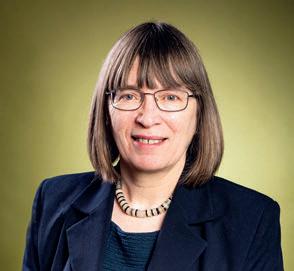
She went on to quote St Augustine’s maxim that ‘All in the end is Alleluia’ … and that, Canon Celia said, “is the light in which we should live through change”. Alleluia indeed.
Follow this link to access the recording of the conference on the Cathedral Music Trust website: www.cathedralmusictrust.org.uk/ joining-the-dots.
Clare Stevens is a freelance writer, editor and publicist, specialising in classical music, church music and music education. Her career has included full-time posts as editor of Music Teacher magazine and marketing manager for the Three Choirs Festival. Born and brought up in Belfast, Clare graduated from St Andrew’s University in Scotland and lived in London for 30 years, but is now based in the Welsh Marches. She has been an amateur singer since her schooldays, and her varied choral experience includes membership of the chorus of Chelsea Opera Group, the Choir of St Barnabas, Dulwich, the Three Choirs Festival Chorus and Hereford Choral Society.
Sponsored by
John Rutter’s
JOHN RUTTER will conduct Guildford Cathedral Choir singing the Gift of Life.
They will also sing Veni Creator Spiritus by Philip Moore, a piece specially commissioned for the Choir.

SATURDAY 21 MAY 7.30pm
TICKETS
Audience with John Rutter and concert: £35
Concert only: £5 • £15 • £22.50
www.guildford-cathedral.org
MUSIC
Join our community of over 3,000 Friends, and unlock a host of benefits while helping us support choral foundations across the UK.
More reasons to become a Friend...
Enjoy invitations to our local and national Gatherings as part of our vibrant events programme
Delve deeper into the heart of cathedral music with our regular printed and online publications
Help us nurture the next generation of cathedral musicians and enrich more lives through the power of music

To enjoy a year's worth of insight and Friendship, visit cathedralmusictrust.org.uk or call 020 3151 6096
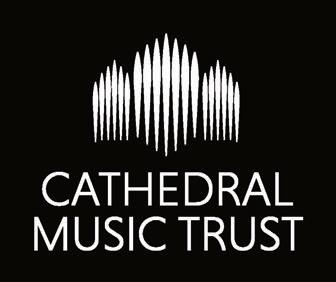 Image: Jason Bryant
Image: Jason Bryant
Matthew Owens was Organ Scholar at The Queen’s College Oxford, and Organist and Master of the Music at St Mary’s Episcopal Cathedral, Edinburgh from 1999-2004. From there he moved to Wells Cathedral (January 2005–August 2019), and now is Director of Music at Belfast Cathedral. In addition to his many musical accomplishments as performer and conductor, Matthew leads the way as a commissioning agent for church music that attracts admiration from all quarters.
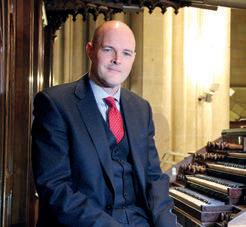
How many of us involved in writing new music for the English church look back to a golden age when musicians were expected to perform, compose and train others to follow in their footsteps? Tudor composers of the Chapel Royal and the later generation that surrounded the Restoration created new pieces of high fashion and immense quality that still form the bedrock of the classical canon widely performed today. By contrast, in 21st-century Britain, composers tend to be specialists who work in very different social situations to those enjoyed by previous generations. Whereas royal expectations for new music were part of the everyday life of church musicians in Purcell’s day, the growth of publishing and the publication of Boyce’s ground-breaking Cathedral Music (three volumes of church music collected in England after the Restoration and the first ones to be printed in score) in 1760 quickly led to the current museum culture for church repertoire, where the work of earlier composers is given precedence over new music (which mirrors the fashions and preoccupations of its time). To speak in the broadest sense, anyone who chooses can look at a cathedral’s music list from 1920 and find the same institution offering something similar 100 years later. Of course, the quality of the old music is supremely suited to the worship; but with the continued use of that music today’s composers have found other outlets for their spiritual music. Concert programmes and publishers’
catalogues are well supplied with excellent choral repertoire, but church commissions have become increasingly rare.
There are, of course, significant exceptions to this, and the excellent work of All Saints’ Northampton, starting with Britten’s Rejoice in the Lamb in 1943 and continuing to the present day, is remarkable. Michael Nicholas, organist at All Saints (1965-71), moved on from there to Norwich Cathedral and for 15 years kept up the tradition with a series of new music festivals and conferences. My own Vox Dei, subsequently sung at the installation of Justin Welby as Archbishop of Canterbury, was written for just such an occasion in 1993.
Matthew Owens is another exception. My first encounter with him dates from his years in Edinburgh, when he commissioned a setting of the Advent Processional for St Mary’s. When he moved to Wells he continued to commission new music and, remarkably, solved the two most significant issues surrounding music commissions: finance and public support.
Matthew’s innovations were Cathedral Commissions, a scheme which enables the cathedral choir to commission new works from eminent British composers, and New Music Wells, a festival which is a retrospective of the last 40 years of music and which also features many premieres. Members
of the community are invited to contribute a small annual grant towards the Cathedral Commissions scheme for which, in return, they have an opportunity to attend rehearsals and performances (often during New Music Wells), meet the composers and, when appropriate, receive a signed copy of the score. The success of Owens’s innovation is remarkable. In festival week, the cathedral is full at evensong, and the annual Palm Sunday Passion performances (see below) are events not to be missed. Wells is justifiably proud of its choir. In 2011 an international jury for Gramophone magazine named Wells Cathedral Choir, under Owens’s leadership, as the best choir in the world with children, and the sixth greatest overall.
During Matthew’s time at Wells, he commissioned and premiered over 120 new works from Sir James MacMillan
to Sir Peter Maxwell Davies, Jonathan Dove, Judith Weir, Judith Bingham, Howard Skempton, Michael Berkeley and a host of others. Young composers from Wells Cathedral School, such as Owain Park and Rebecca Farthing, also cut their teeth on the festival. My own contributions included an anthem, Ascension, written for a BBC Radio 3 broadcast, and a setting of the evening canticles for men’s voices and organ. In 2017, Matthew also launched a very wide-ranging plan to commission new settings of all 88 of Cranmer’s Collects from the Book of Common Prayer. The first, by Francis Jackson, was premiered shortly after the composer’s 100th birthday.
Out of this wealth of material, two projects of mine stand out: the organ suite Organ Hours, premiered in 2017, and An English Passion, published by the RSCM in 2019.
Matthew had enthused about the Dutch organ-builders Henk and Niels Klop for some years, and eventually was able to take delivery of a house organ. With mechanical action over two manuals and pedals, and encompassing a precise but small registration, Klop organs are renowned for their beautiful vocal quality – so when Matthew asked me to compose a set of short fugues for his new toy, I was delighted to accept. Writing for a small instrument was a new challenge and proved to be very refreshing. Wells Cathedral is home to one of the oldest clocks in England, and I happily turned to it for inspiration for my small collection of contrapuntal exercises. Organ clocks were very popular in 18th-century Austria, and we have surviving music by Haydn, Mozart and Beethoven for these instruments. Indeed, Mozart’s three compositions for ‘Orgeluhr’ count as some of the finest pieces of his last years.
In my piece there are four separate sections.
has two faces. The outer face tells the world’s time to those passing by, whereas the celestial imagery of the inner clock face is more fascinating. Placing Earth at the centre, it portrays the sun, moon, and stars in circular motion over three concentric dials. I have used a short ground bass to provide a musical equivalent to Lightfoot’s vision of the heavens.
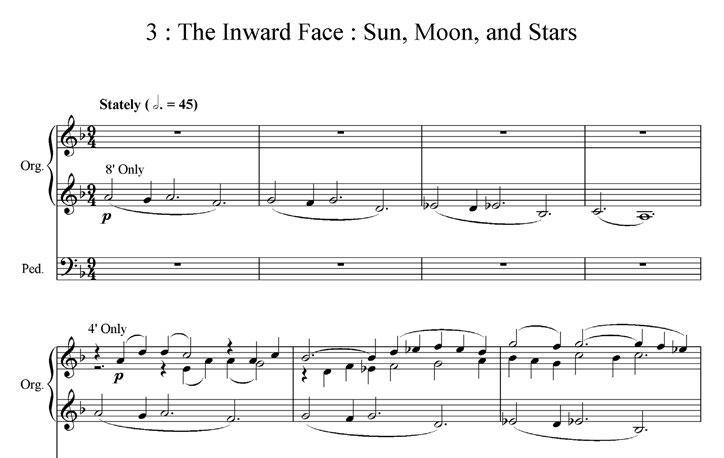
3. Lightfoot’s

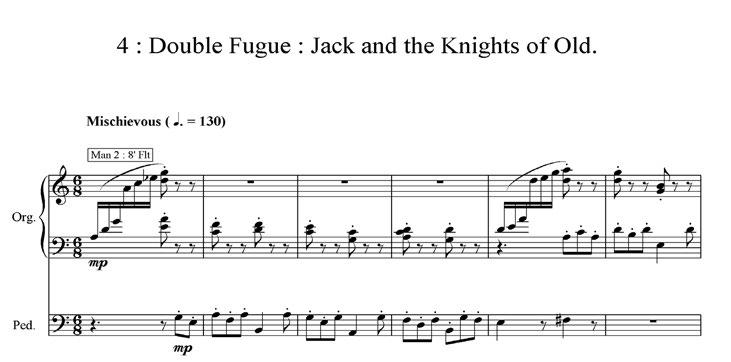
4. The bell mechanism of the clock contains a pair of automata. ‘Jack Blandifer’ is a humorous figure, who acts as ‘QuarterJack’ and strikes two bells every 15 minutes. His rustic humour is reinforced on the hour with a sudden appearance of jousting knights. My double fugue portrays both personalities and combines them at the movement’s close with a flourish of climactic sound.
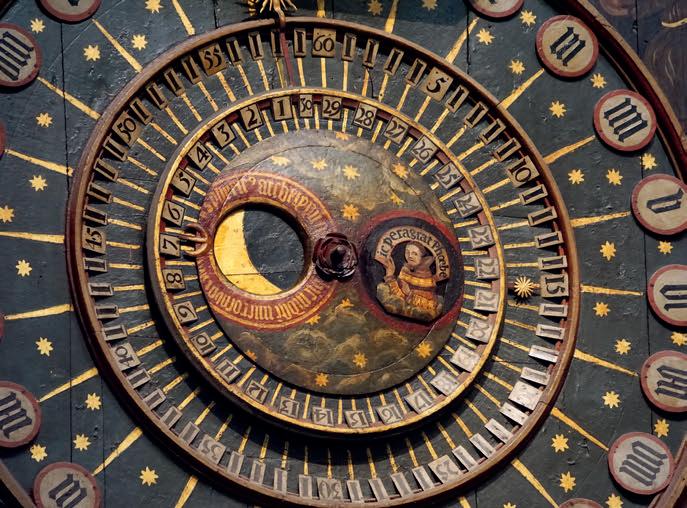
5. The final fugue is the most pictorial of the set. Against the sound of the ticking clock, this last movement imagines the sound of the clock in the cathedral at night. The music’s trajectory begins in the organ’s highest register.
Published by Fagus Music of Banchory, performances on larger instruments have now become standard. Margaret Phillips, who attended Matthew’s first performance on the main organ in Wells, has played the piece on a variety of instruments, including historic examples, and various enormous organs in northern town halls. Such performances effectively use dynamic marks as a guide to registration. The set is due for a CD recording with Simon Leach on the Frobenius organ in Edinburgh’s Canongate Kirk when the pandemic subsides.
For me the crowning glory of the Wells commissions was the request to set the four Gospel Passion texts. These were performed on Palm Sunday over a six-year period from 2013 to 2019. The first composer to accept this most daunting of challenges was Bob Chilcott, whose St John Passion laid down a pattern for subsequent works to follow. John Joubert’s St Mark Passion came next and was written in the composer’s 90th year. Philip Moore followed in 2018 with a setting of St Luke, and my own English Passion according to St Matthew was premiered in 2019. It was published by the RSCM the following year, just before the pandemic hit all church performances, and was recorded by Resonus Classics in March 2022. The brief was that the work should fit into a service of an hour’s length; it must tell the narrative clearly, involve the listeners emotionally, and provide them with the opportunity to respond physically with congregational hymns.
Setting a Passion narrative to music is a daunting task. The core values of the music and composer are truly tested, and, of course, there are several well-known predecessors to be considered. Stainer’s Crucifixion, written in 1887, owes something to Bach’s great examples from the 1720s. Stainer’s two soloists, representing the Evangelist (tenor) and Christus (bass), are surrounded by choral drama and congregational hymnody. Equally, there are earlier examples, notably by Buxtehude and Schütz, which stand in a similar tradition, although many of these lesser-known works, notably Schütz’s Seven Last Words (1645), set the evangelist’s words for various voices.
My own setting chooses to follow that 17th-century model, representing Jesus with a tenor voice, and sharing Matthew’s narrative between four other soloists (soprano, alto, baritone and bass). The choral music is written for double choir, and there are two organ parts, contrasting the high drama of the main organ with a chamber organ for accompanying recitative.
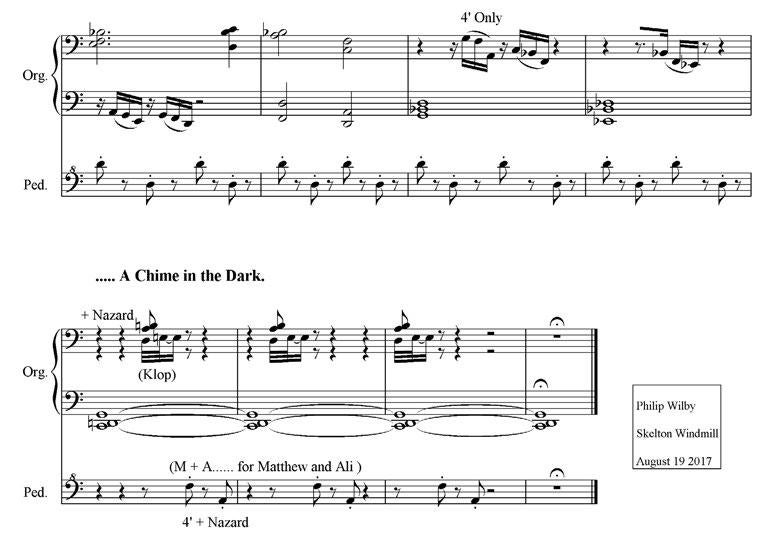

For the hymns, I sought the help of Canon Richard Cooper from Ripon Cathedral. In conversation, and later more extensive collaboration, Richard and I decided that our work should reflect our own experience. It would be ‘An English Passion’, rather as Renaissance painters evolved a tradition of setting devotional images against natural landscapes. The famous religious paintings of Stanley Spencer have achieved a similar relevance, and our setting of St Matthew’s text is counterpointed against the natural background of the English countryside. Accordingly, the melodies of the congregational hymns are taken from the collection of English tunes published in the English Hymnal of 1906. Richard echoed the words of Vaughan Williams, who said, ‘Where there is congregational singing it is important that familiar melodies should be employed.’
He went on: ‘This Passion is intended to be a devotional work and not simply a choral performance. The hymns punctuate the narrative with a recapitulation of the story and call the listener to contemplate their own involvement in the unfolding drama. They are not poetry, nor do they have literary merit in themselves, they are there to do a job: to support Matthew’s Passion narrative.’
The scene is set with the Collect for Palm Sunday (sung off stage). The Palm Sunday procession begins with the familiar opening words of ‘All glory, laud, and honour to thee, Redeemer King’, set to the tune ‘Kingsfold’ as collected by Vaughan Williams. This was later chosen for inclusion at the composer’s memorial service in Westminster Abbey.
There are two other features of the score that it would be good to highlight:
In common with Bach’s St John Passion (1724) and Buxtehude’s Membra Jesu Nostri (1680), I have included a pair of cross-shaped or chiastic musical designs in my piece. The larger of these concerns the five hymns, which are arranged symmetrically. 1-5, 2-4, with the third, the hymn of the Silent Saviour, standing alone. A striking feature of St Matthew’s telling of the Passion is his use of dramatic silences. Silences may seem to be empty, as an absence of content; not so the silences of St Matthew, which act as springboards for our own thoughts and reactions.




Speaking of the bond between Hymns 2 and 4, Vaughan Williams himself pointed out that the second hymn (‘The Truth from Above’) and the fourth (‘Waly Waly’) share a remarkable similarity, rising a third, sinking a fourth, rising a fifth and so on.
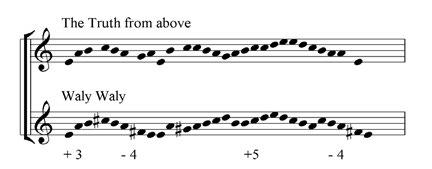
Thus the large chiasmus may be represented thus.
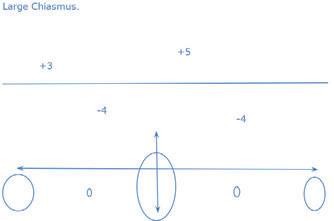
The central chiasmus, where music plays backwards and forwards like the symmetrical arms of Christ’s cross, surrounds Peter’s denial and Jesus’s repeated refusal to answer the questions of his interrogators. The pedal solo is represented by a small chiasmus, viz:


This most recent of Matthew Owens’s commissions from my pen has, not surprisingly, turned out to be the most extensive and the most demanding. The music, which requires full participation from its hearers, is designed to involve rather than impress, and may be seen by some as more suited to performance within a liturgical context. However, as many other greater settings of the Passion readily demonstrate, concert performances also have an evangelical outreach that few can deny. The Gospel text transcends any musical composition, just as Christ’s Passion transports its witnesses to an internal space of contemplation, reaching out to those who share a common humanity, of all faiths and none.
Encouraged to take up composition by Herbert Howells, Philip Wilby studied at Keble College Oxford, and was made Professor of Composition at Leeds University in 2002. Until recently he lived in Bristol, where his wife Wendy has been serving as Canon Precentor at the cathedral. In 2008, he was granted a Dutch Government BUMA award for his innovative works for brass band, and in 2009 an honorary fellowship by the RSCM. He is proud to have served as the musical associate of the Black Dyke Band for 30 years; his recent CD, Pilgrim’s Progress, is recorded by them.


On 9 October 2021, the 30th anniversary of the founding of the Salisbury Cathedral girls’ choir was marked by a splendid concert in the cathedral in which the current girls were joined by some 80 ex-(girl) choristers. In her introduction in the concert programme, the Countess of Chichester, chair of the girls’ choir trustees and the driving force behind the concert, spoke of how the event came about, and how ‘our beloved Richard Seal, Director of Music, Organist and Master of the Choristers here for 29 years, was inspired to found a girls’ cathedral choir.’
The story of Richard Seal’s putting together a plan for the choir on the train back to Salisbury following a meeting in Church House in October 1989 has already been told (most recently in Cathedral Voice in February this year), but of course this does not stand alone. Richard’s career as a chorister, an organist and a director of music is a window on the world of cathedral music in the second half of the last century, populated by the great and the good. His has also, it struck me, been a life marked by moments of serendipity – for Dr
Seal could, had events conspired differently, have become a soldier or a teacher instead of a director of cathedral music.
Richard Seal was born in 1935 in Banstead in Surrey. His family was musical, his maternal grandfather having been a conductor for silent film orchestras in Sheffield. Richard remembers his mother, who occasionally would join her father, playing violin on the back desk of the seconds, speaking of her distress when the talkies came in and many of her fellow musicians lost their livelihoods, “overnight, it seemed”, with some being reduced to begging. Richard’s father, meanwhile, played the organ at his Christian Science church in Sutton right up until the end of his life. The musical potential of young Richard was consequently fostered, and in due course this led to an audition at New College Oxford. Richard can still recall the day clearly – the Senior Common Room crowded with parents and boys, and a curious-looking, staccato-voiced man in pink trousers and blue shirt who popped in and out, calling boys in for audition. This, it transpired, was Lord David Cecil, whom Richard subsequently got to know well. Once in

the practice room, Richard was greeted by “the great man himself”, Dr Herbert Kennedy Andrews, who was sitting at the piano smoking his pipe, while another man, who “looked very old indeed”, sat in a corner eating his sandwiches. This was the eminent organist Professor Sir Hugh Allen.
His years as a chorister were happy ones for Richard, and he says he owes enormous gratitude to Ken Andrews for instilling in him the love of cathedral music that has been with him ever since. He also remembers moments of kindness to a homesick chorister, such as Ken Andrews taking the boys out for cream buns at Woodstock and bringing him a book about birds (for – forgive me – as well as being an expert on Byrd, Andrews also knew a lot about the feathered variety) when he was in hospital with appendicitis.
After five years, Richard went to Cranleigh on a music scholarship and hence to Christ’s College Cambridge as an organ scholar. “They were all rowers at Christ’s,” he says, “but I had a very enjoyable time.” A year spent studying organ at the Royal College of Music, during which time he served as Assistant Organist at the Kingsway Hall, was followed by National Service. Much to his astonishment, Richard’s music degree qualified him to join the Army Education Corps and he spent a very happy couple of years with the First Battalion of the Third East Anglian Regiment, first in England and then in Malaya. His duties were not arduous – members of the teaching corps had little to do with front-line action – but his particular musical skills made him sought after for troop entertainments, and he remembers being persuaded to give an organ recital in Ipoh, although as there was no organ music to be had locally, it had to be posted to him from the cathedral in Singapore!
As with most things he has done (for this is a man with a refreshingly positive attitude), Richard enjoyed his time in the Army – so much so, indeed, that he seriously considered signing up after National Service. However, having reflected that his military experience was unlikely to be representative, he remained in education, spending a period teaching technical drawing in a secondary modern school, while keeping his musical life alive as Assistant Organist at St Bartholomew-the-Great in Smithfield. As with his New College audition, Richard has a clear memory of how he came to get this post, of his meeting with “a little man who looked just like Arthur Askey” in a London café. This was the St Bartholomew’s Organist and Director of Music, Paul Steinitz, the leading authority on the music of J S Bach, founder of the London Bach Society and the man responsible for the first performance in Britain of the St Matthew Passion in its complete and original German form. Consequently, Richard’s time at St Bart’s was full of Bach, with frequent cantatas at Evensong, often with a scratch orchestra of Steinitz’s pupils from Goldsmiths’ College.

When his time at St Bartholomew’s came to an end, Richard wasn’t sure what to do next. He was living with his parents in the village of Nork, near Banstead, when out of the blue he got a postcard from his old choirmaster telling him that the position of Assistant Organist at Chichester Cathedral had become vacant. Fortuitous in its timing, this postcard was all the more surprising since Richard hadn’t heard from Ken Andrews since he left New College. Serendipity, luck or simply the fact that the cathedral music world is a small one? However
one looks at it, this postcard led Richard to Chichester (by way of another notable audition, marked by his mother being pulled over and fined by the police on the drive there) and to devoting the rest of his career to cathedral music.
Richard confesses to starting out at Chichester feeling rather complacent. “I thought I knew it all,” he says, “but I soon discovered there was a lot more to learn.” John Birch, to whom he was assistant, ran a very good choir, he says, and he considers himself very lucky to have served with him. “He knew what the beauty of sound was, and the trebles in his day always made a beautiful sound, maybe a little ‘fruity’ sometimes, but a wonderful sound nonetheless.” Remembering with pleasure the firm friendships made with the men of the choir as well as their considerable musicality, Richard also credits John Birch with teaching him about discipline – and how, if one is to be the boss, some of the pleasures of being one of the lads must be forgone!
The moment to be the boss came in 1968, when, after seven years in Chichester, Richard was appointed Director of Music at Salisbury Cathedral. In another coincidence, the outgoing director was Christopher Dearnley, whom Richard had known as a boy, the garden of the Seals’ house adjoining that of the vicarage of St Paul’s in Nork where Christopher’s father was the incumbent. Richard knew the family well and he and Christopher often used to go on cycle rides together round the Surrey countryside. Delighted to have got the job – although characteristically self-deprecating about it (“I expect Chris put in a good word for me”), Richard wonders, nonetheless, how happy the Dearnleys – who loved the Wiltshire countryside –were to exchange it for the prestigious, but undeniably urban, milieu of St Paul’s in London.
Richard already knew a little of Salisbury through the Southern Cathedrals Festival (SCF), an event with which he has continued to be involved. (Indeed, a short video –available on YouTube – made for last year’s festival, tells the story of his collection of programmes. He possesses an almost complete set of SCF programmes from 1960 onwards – only two, those from 1979 and 2008, are missing!)
Of course, any discussion of Richard Seal’s time at Salisbury must include reference to the girls’ choir, and another clear picture he retains is of the rehearsal for their first Evensong in September 1991. Having ascertained from a teacher colleague at Salisbury Cathedral School that the girls would not take kindly to being addressed by their surnames
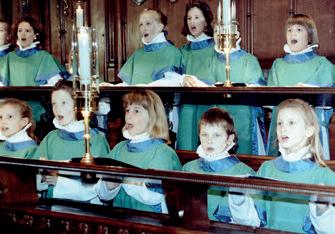
(as was then the practice with the boys), Richard was then somewhat flummoxed to find himself with no fewer than two Jessicas and three Amys in his new cohort as they gathered to rehearse – but he managed. And of the music: “We tried a bit of everything in that first rehearsal,” he says. “I suggested we start with a hymn – they chose some pop hymn I scarcely knew – and then I proposed we practise a psalm. Most of them didn’t know what I was talking about, but they did their best.” For the girls’ first Evensong, Richard had chosen And didst thou travel light, Dear Lord as the anthem. Written by his great friend and former Salisbury Cathedral choir alto Richard Shephard, to words by Geoffrey Dearmer, this remains one of his favourite anthems, and sits today among the music on his piano. Richard particularly likes the top line, and felt it was a good choice for the novice choristers. During the rehearsal of the anthem, Richard stopped the girls after the first verse to ask them if they knew what the words meant. The ensuing rather long silence was broken by a solitary chorister. “I think it is to do with our Lord carrying the burden of our sins,” she declared – here, evidently, was a child who did know what this was all about! Richard remembers these first choristers – now in their late thirties and early forties – with great affection, and was delighted to see so many of them at the 30th anniversary concert.
In 1992, Richard Seal was awarded the Lambeth degree of Doctor of Music in recognition of his services to English cathedral music. He retired as Director of Music of Salisbury Cathedral in 1998, but he and his wife Sarah continue to live locally (in another instance of the planets being aligned, a house opposite Sarah’s parents came up for sale just as the couple began searching for their next home). Richard still plays the organ at his local church and he and Sarah are very much involved with the musical life of the city.
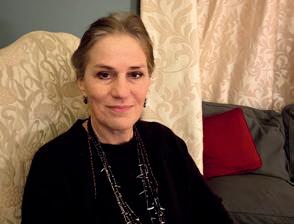
Richard is modest about being the first person to establish a girls’ choir in an English cathedral. “It would have happened anyway, sooner or later,” he says, “and, in Salisbury, the pipe-dream would never have come true if it had not been for the wholehearted support of the cathedral chapter, so enthusiastically led by the Dean, the Very Revd Hugh Dickinson.” Be that as it may, the fact remains that it was he who instigated the process, and there are many, many current and past girl choristers up and down the country who owe him a huge debt of gratitude, my own daughter (sadly at Salisbury post the Seal era) among them.
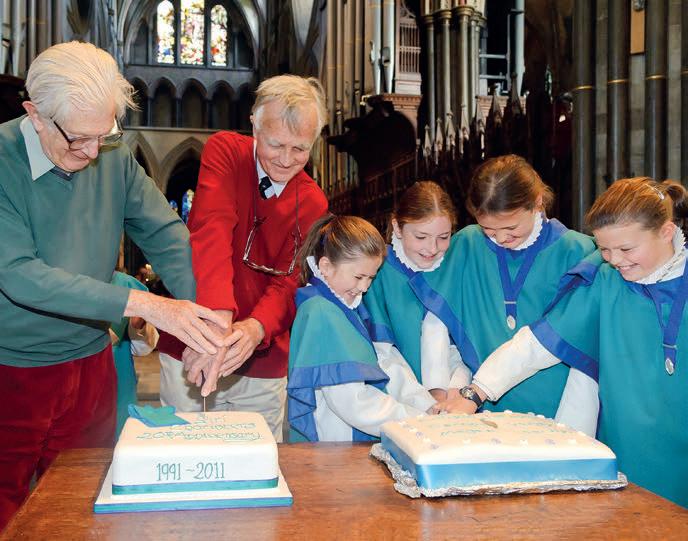
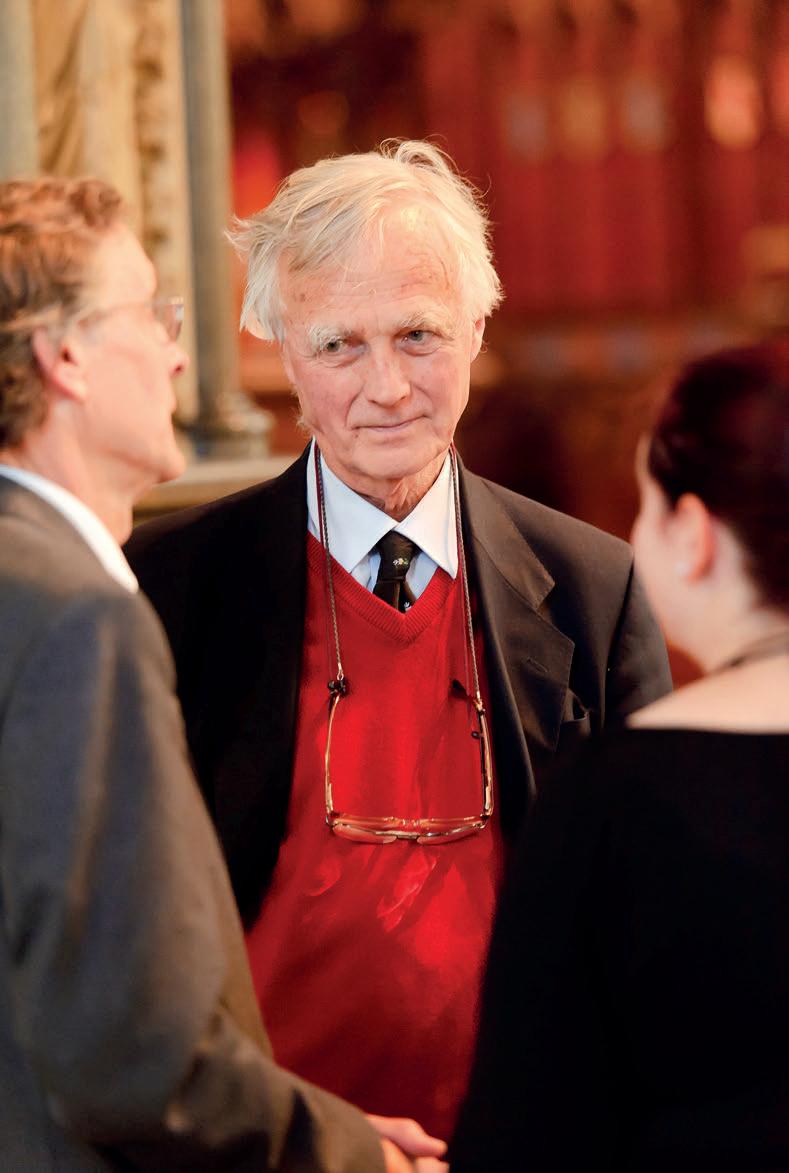
development of the young people (involved) … Katherine embraced these aims fully and especially encouraged those with young broken voices to move to the back row and join the adult singers. In fact, Katherine really took this to another level; we had 10 teenagers in the gentlemen’s choir at one point! Some of these went on to choral scholarships at various universities.
‘Katherine also spent a huge amount of time developing the girls’ choir, which went from strength to strength under her inspiring leadership, and here too, many girls went on to choral scholarships and other musical scholarships. Another much appreciated aspect of Katherine’s leadership and style was her ability to impart confidence and a love of singing, including occasional light-heartedness, such as when she taught the choir Ralph Allwood’s dearly loved Jingle Bells arrangement. Pieces such as this would often be performed at dinners and other events throughout Warwick, a good way of taking the choirs out to the community and demonstrating their flexibility and breadth of compass.’
If early careers plans had been pursued, the first female appointed to direct the music at an Anglican cathedral could instead by now have been head of modern languages in a New Zealand secondary school or a senior civil servant.

Instead, Katherine Dienes Williams chose her equally strong musical talents over her language skills and is now the longstanding organist of Guildford Cathedral, navigating it through the second decade of the 21st century including, most recently, Covid. The cathedral being consecrated in 1961, she is only the fifth holder of the post, taking over from Stephen Farr in January 2008.
Born and educated in Wellington, New Zealand, she studied for a BA in Modern Languages and a BMus at Victoria University, Wellington. She was organ scholar at Saint Paul’s Cathedral, Wellington from 1988 to 1991 when she was appointed Assistant Organist there. She came to England in 1991 to take up the post of organ scholar at Winchester Cathedral and Assistant Organist at Winchester College. Prior to arriving at Guildford she had been Director of Music at the Collegiate Church of St Mary, Warwick since 2001. Simon Tyldesley, a longstanding member of the Warwick choir, remembers the impact she made: ‘The choir of St Mary’s Warwick has always been focused on encouraging and fostering young talent, caring for as well as nurturing the musical and social
Like many similar groups, the choir was traditionally busy on Christmas Eve, in a schedule that included a one-hour concert in two hotels, boys and men in one and girls in the other. As Simon continues: ‘We then joined forces at Warwick hospital, split into Dec and Can and sang round the wards, all this before Midnight Mass. It was at Warwick Hospital, one very special Christmas Eve, that we sang on the maternity ward to Katherine and her newly born daughter Hannah.’
Given her strong track record, it was no surprise when Katherine was appointed to Guildford. She applied because, as she says, she wanted ‘the opportunity to lead a music department in a cathedral … The profile of the cathedral sounded like a good fit and I had a really good audition and interview. Also, I knew of Stevie Farr’s excellent musicianship and his work with the choir and that there were both boy and girl choristers, which appealed.’ Her appointment caused ripples in the musical world but, to her, being the first female cathedral musical director didn’t seem like pioneering because of her seven years at Warwick. ‘However, the smashing of the glass ceiling did feel like a huge, vastly important moment at the time and was utterly thrilling – and so important for the future. But for me it was a case not of “Why?” but rather of “Why not?”’
There have been many musical highlights in the intervening years. Among the ones that Katherine picked out when I contacted her were big occasions such as Christmas concerts with the Royal Philharmonic Orchestra and John Rutter, and a tour to the USA in 2014 with ‘Sublime performances of the four Poulenc Lenten motets, Byrd’s Ne irascaris, Howells’ Take him, earth, for cherishing and the Duruflé Requiem.’ She also highlighted CD recordings, ‘Especially the one I hope will come out soon of Darke world premières and Duruflé’s
Requiem’. But as well as those more expected choices she also selected ‘Watching a probationer be made up to full chorister’ and ‘Watching a child excel by overcoming a vocal issue or singing their first solo or giving an outstanding performance’. And when asked for other highlights of her time at Guildford she used phrases such as, ‘Working in harmony with a fantastic team of musicians and people’, ‘An amazing team of people who are super committed’, ‘Our wonderful ability to manage and thrive in a crisis’, ‘Lots and lots of laughter and love’ and ‘When other people come in to work with the choir and I feel so proud of them’.
It is clear that Katherine is an outstanding coach, team builder and team leader, motivated to help others succeed. Her daughter, Hannah, who was serenaded by the Warwick choir soon after emerging into the world, went on to be a key member of Guildford Cathedral choir until 2020 when she left to take up a place at Cambridge. She has a unique perspective on her mother’s abilities, and her assessment is that ‘She is consistently positive, dynamic and articulate in her rehearsing and conducting ... She is encouraging yet firm to both girl and boy choristers, allowing them each to flourish as musical individuals. She is holistically caring towards all her choristers, she puts an unparalleled amount of effort into teaching them the life skills which naturally stem from being a chorister, such as leadership, self-confidence, the ability to listen, teamwork and commitment to constantly being your best self .... Despite her busy schedule at Guildford, she still finds time to be a sought-after international recitalist, a choral director on international RSCM choir courses, and an organ teacher, as well as a compassionate wife, mother and friend to many.’
At times in the last 12 years Katherine has needed all these qualities as Guildford has given her some big challenges, the biggest obviously being Covid, which stopped all cathedral choirs in their tracks for several months. The last choral service was sung in the cathedral on Monday 16 March 2020 by the choirmen. It was a poignant moment as Katherine explains: ‘On Sunday 15 March, a deputy singer, Tim Pride, former countertenor lay clerk at Winchester, sang with us, and soon after that he died – his autopsy gave the cause of death as Covid 19.’ Through lockdown the choristers were rehearsed online whilst the choirmen, organ scholar and Liturgy and Music Department secretary were furloughed. Like many others, the choir only re-emerged in late September 2020 and then featured in the second (post-pandemic) live BBC Radio 3 Choral Evensong on 30 September in a programme postponed from Easter. Probably rarely has Howells’ St Paul’s Service or James MacMillan’s Christus vincit been sung so brilliantly, passionately or movingly.
Back in 2008, the Christmas carol service was delayed by a week as there was a shooting on the cathedral site. As
Katherine again recalls: ‘A man was shot by police on the south side whilst I was in the building practising together with my then sub-organist colleague, David Davies. There was an independent inquiry which found that the police had acted lawfully but of course it was a traumatic time and the grounds were blessed and reconsecrated. We only just managed to stop choristers and choir men from coming up the hill, some of them were already en route, and one or two of them were turned away by police stationed at the bottom of the hill.’
And in the summer of 2013 there was a small fall of asbestos from the choir roof, as the acoustic plaster which contained asbestos had become unstable. The building was immediately closed for cleaning. It also led to the cessation of fundraising towards ongoing needs and all fundraising and expenditure was directed towards a large-scale project to remove the acoustic plaster from the roof throughout all areas of the building. This had a huge financial impact and also led to various areas of the building being variously out of use and / or very cold. The organ was also removed for safety purposes and cleaned, and a digital instrument was installed and used. As a result of this work the cathedral’s acoustic has been transformed from what the choir’s founder, Barry Rose, used to describe as ‘blotting paper’ to something much more reverberant.
But despite all this, and 12 years in, Katherine still has a passion and a big vision for Guildford Cathedral and its music, as she explains. ‘I think we should have a music and education partnership post working with the education department and the music department to really harness musical partnerships so that eventually we become a centre of musical opportunity and learning for all generations in so much as we can – right from toddler music groups to working in local primary schools (which we have been doing for several years for 250 Year 5 schoolchildren each year) to the cathedral choir to the Guildford Cathedral Singers (adult voluntary choir) to links with our ex-choristers to music for people in care homes / people with special needs – we just need someone to harness this huge volume of work all together.’
Clearly the music at Guildford Cathedral is in safe hands.
Simon Carpenter works part time in the NHS and has recently completed an MA on Herbert Brewer and his pupils at the University of Gloucestershire. This has led to him achieving his dream job of joining the Three Choirs Festival team as a voluntary archivist and historian.


As I write, the media are in a frenzy of discussion about the lockdown activities in Downing Street and what may or may not be in the ‘party-gate’ report of the civil servant, Sue Gray. In the absence of any actual knowledge of the report’s contents, a symphony of speculation has developed on the theme of political integrity. Surrounded by this current noise whilst trying to get to the heart of the composer Phillip Cooke, his own honesty and modesty seems to leap out. “I wish composers were more honest. One of the first things I say to students is, ‘Don’t make myths about composition’. Writing music is hard. It’s difficult because I quite often don’t like writing music. It’s horrible! I wish I did something like build stone walls or plant trees.” The remark seems to echo Malcolm Arnold’s famous desire to ditch music for bus driving. Despite this, Cooke has a catalogue of over 50 choral works, along with some strikingly original works for organ.
He describes himself simply as a ‘British composer’, in a manner which doesn’t seem to do justice to the breadth of his activities and experiences. Born in the Lake District, his student years took him to Durham and Manchester, before moving to Wales for a doctorate in composition at Cardiff University under Anthony Powers. A prestigious junior research fellowship at The Queen’s College Oxford followed, along with a teaching post at Eton College, before he moved

to his current home as a Senior Lecturer at the University of Aberdeen.
I ask him what he’s learnt about ‘British’ music from his travels around the isles. “I’m a Northerner with many interests in the south, and the ‘British’ label links back to a period of music history and cultural thought that was ostensibly British, and that’s a link to a tradition that I feel very comfortable with. As an English person living in Scotland, I do think about it a lot… Living in the Lakes, I always felt the Scottish influences coming down, far more strongly than any southern ones.” This comes through not only in his music, but also in his many writings, as Cooke is as much of a musicologist as a composer, having co-edited a volume of essays, The Music of Herbert Howells, along with a superb monograph on the music of James MacMillan.
“Some of my favourite research moments have come from writing about Scottish history, and it was on my doorstep. So, for example, MacMillan wrote about the disaster on the Piper Alpha oil platform (Tuireadh) and the memorial for that disaster is ten minutes from the university; the witch trial which forms the basis of The Confession of Isobel Gowdie is half an hour up the road, so the sense of being embedded in that research is quite satisfying.”
This desire to feel ‘embedded’ by a sense of place comes through when Cooke talks of his first experience of hearing the music of Herbert Howells. “When I moved to Gloucestershire, I was absolutely intoxicated by the musical links. There just happened to be a concert in the village of Sedbury where I lived. Living there, I was conscious for the first time of what it might mean to be English, especially when I was going into Cardiff and experiencing elements that were anti-English.” This encounter with Howells was crucial as Cooke now sees himself within that English pastoral tradition, albeit with elements of the Lake District as well as Gloucestershire. “It’s an intangible link, I don’t write tone poems, or think about larks or bluebirds, but the tradition element gets me out of bed in the morning. I want to contribute to that.”
More recently, as elements of Scottish culture have become more apparent in Cooke’s music, he reflects: “I’m an onlooker, rather than this being part of my heritage. And I feel the same about church music, and it’s OK to be looking in, from a different viewpoint.” He didn’t set foot inside a cathedral until he was an undergraduate at Durham, but the experience of concerts in that vast space, such as those with the organist Ian Hare and another with the composer Arvo Pärt (in the same week), was ‘an awakening’. Compositionally, however, Cooke was following a much more avantgarde diet from late Stravinsky to a host of living composers including George Benjamin and Oliver Knussen. “That kept me going to the end of my PhD, and then I changed completely. It was not for me.”
So where did this overnight change of direction come from?
“Oxford! Being there, purely from being asked to write pieces for so many choirs. And before I knew it, I had a body of work and a sea-change of aesthetic which fitted with my own interests in Howells and Vaughan Williams and the like. It’s a decision that I’ve never regretted because I’ve had far more of an impact and many, many more performances than I would have had with my initial music. By 2008, 90% of my music was instrumental and orchestral, now it’s 90% choral, organ and song. I’m certainly not yearning to write a violin concerto.
“Looking back at my PhD work, I was clearly desperate to write the music I write now. I was constantly sneaking in ‘ironic’ modal sections and quotations into my pieces. It was so good to break away from that. Now it’s perfectly acceptable to write in a softer, modal way.” He quotes MacMillan talking about tradition as ‘a river running through music’, a thread which binds it all together with a shared cultural outlook, all working within that heritage which continues into the future. “As a composer, I’m certainly not at the end of the journey. Working within a tradition doesn’t mean preserving it, it means adding to it and trying to invigorate it… It would have been great to be a composer working in the 1960s or ’70s with all the funding and such a clear idea of the area you were working in, but actually now, at this moment, I feel we’ve moved beyond that dogmatic era into a more pluralist one where I can recommend diverse listening from, say, Vaughan
Williams,
In the field of choral music, however, we often encounter music that clearly aspires to the modal sound-world of Howells or Vaughan Williams but falls significantly short. How do students avoid this? “I always ask, ‘What is it about this piece that says written in 2022?’ – Contemporary music doesn’t have to sound like anything in particular, but it needs that awareness of what’s happening now and what’s gone before.” That’s a high aspiration, but listening to Cooke’s recent work, it’s clear that he’s carved out a very distinctive voice of his own.

His motet for The Sixteen, Ave Maria, mater Dei (2017), is a response to William Cornysh’s setting in The Eton Choirbook Cooke uses an SATB choir and two off-stage sopranos to create ethereal echoing to the main choir’s chant-like phrases, along with resonant humming effects and rhythmically independent elements. The motet certainly sits in the same ecstatic visionary tradition of unaccompanied Howells or Holst, but there are elements of spiritual minimalism and the elemental power of Henryk Górecki, John Tavener or the work’s dedicatee, James MacMillan. Listening to the choir of King’s College, Aberdeen, in the magical opening of O lux beata Trinitas (2013), it’s clear that Cooke has a highly developed ear for sonority. These are not just the ubiquitous cluster-chords upon which so much contemporary choral writing depends, but harmonic units where the voice-leading drives the seemingly static music forward. This sense of forward motion pervades the glorious secular anthem The World on Fire, commissioned by the choir of The Queen’s College Oxford for their recording A New Heaven, which sets remarkable diary fragments from Jackie Stedall, former university lecturer in the history of mathematics and fellow of Queen’s – ‘The world on fire, not the fire of destruction, but of energy, creation, love. Burning in every moment.’
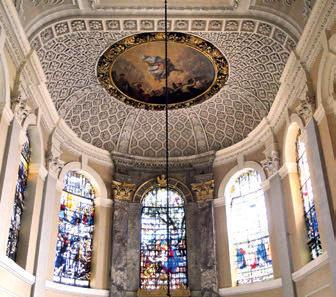
In 2013 the chapel choir of Selwyn College in Cambridge under Sarah MacDonald recorded a CD on Regent Records which gives a wonderfully immersive experience of Cooke’s writing, from the morning and evening services to the substantial secular work, The Hazel Wood (2012), which sets W B Yeats’s famous poem The Song of Wandering Aengus from his 1899 collection The Wind Among Reeds. “I was taken by the inherent drama in Yeats’s verse, from the passion and obsession of the opening lines (‘a fire was in my head’), the years of searching, the revealing of the girl and then the final nostalgic reminiscences – it felt like a grand narrative, a story that had to be told, and one that would benefit from music.” Certainly the addition of a brass quintet to choir and organ makes for a very dramatic setting of over 12 minutes.
Cooke’s largest work is the 2015 oratorio Noah’s Fire, which was commissioned by the Chester Music Society for their 70th anniversary. Having written two earlier works for their youth choir (Jabberwocky, 2010 and Far-Away Music, 2012), this was a natural succession, and Cooke consciously saw the musical mystery play in the ‘British oratorio tradition’ as heard in works by Elgar, Walton and Britten.
Although fewer in number, Cooke’s compositions for solo organ also capture this flare for sonority, harmonic colour and dramatic form. They include the Elegy (2003), Prelude & Lament (2012), Praeludium (2013), and In modo elegiaco (2014, rev. 2020). His recent Hymn Tune Prelude on ‘Rhosymedre’ (2019) is clearly a nod to Ralph Vaughan Williams, but with a more modern voice. My favourites would have to be Exsultet and the Epitaph (both from 2014). The brilliant ringing of super-imposed major triads gives Exsultet the triumphant energy of Kenneth Leighton’s music as it evokes the lighting of the paschal candle during the Easter Vigil. In contrast, the elegiac Epitaph achieves a remarkable stillness as it explores a particular minor-ninth sonority, touching upon the works of the dedicatee, fellow composer John Tavener. Cooke writes: ‘Although Epitaph has few similarities with his work, there is something of the deep benevolence of his music that informs mine’.
His most recent works include a ten-minute Fantasia for organ – ‘a transfiguration of a motet of mine, Veni Sancte Spiritus (2012)’ – and a choral motet Canticum Mariae virginis (2021)

for the Marian Consort, which will be recorded in 2022 for a new CD release. Beyond the world of choirs and organs, readers may also enjoy his recent piano arrangement of The Turtle Dove, written during the Covid lockdown for the pianist Duncan Honeybourne.
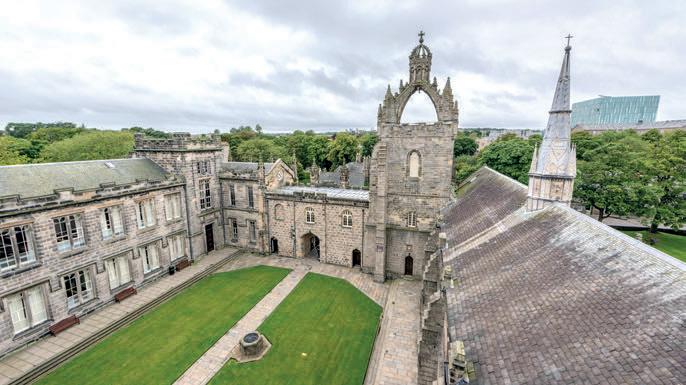
For those wanting to explore further, his website (www. PhillipCooke.com) is a gift. Not only has he made the majority of his works freely available for PDF download, but there are links to recordings and a wealth of programme notes. He also writes a very interesting blog; “I try to give an honest take on it all, to demystify being a composer, to be a voice of normality” – so there are pieces on not getting commissions, not being an organist (or a conductor or a singer), writing in isolation, dealing with creative block, and all sorts of other personal matters, alongside broader reflections on works by other composers. Visitors will be richly rewarded.
Dr Jonathan Clinch is an organist and academic focusing primarily on English music of the last 200 years. He holds the post of Lecturer in Academic Studies at the Royal Academy of Music, having previously been Frank Bridge Research Fellow at the Royal College of Music and OCVE Research Associate at the University of Cambridge. He read music at Keble College Oxford before completing postgraduate degrees at the University of Durham with Dame Gillian Weir and Professor Jeremy Dibble. His recent editions of the music of Herbert Howells, including a completing of Howells’ Cello Concerto and an edited volume of his piano works, have received widespread critical acclaim.

Education details:
I went to Durham School, where I took up the organ at secondary level. I moved to Chetham’s School of Music for sixth form, studied at the Royal Academy of Music, then did a masters at the Royal College of Music. I began as a pianist and a trombonist, but the organ became my main instrument when I was 13 or 14.
I was organ scholar at Guildford Cathedral from 2012-2014. I was fortunate to have a second year, commuting back from London, as it helped embed everything I had learned the previous year, such as the repertoire and – not least – some of the confidence. In London, I held various scholarships including King’s College London, St Michael’s Cornhill, and the London Oratory. I also built up a lot of freelance work before I came to Bradford Cathedral in 2019, where I am Assistant Director of Music.
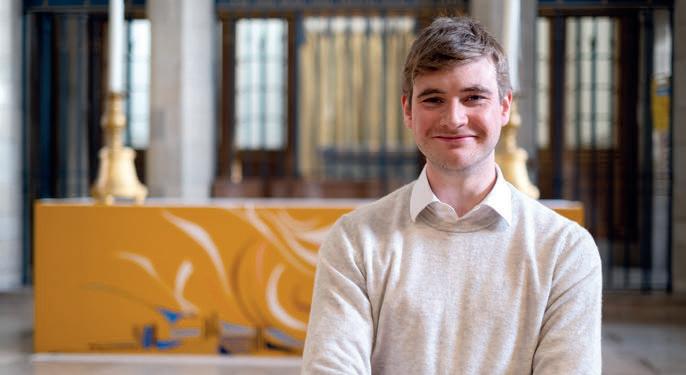
I was given the opportunity to become a chorister at Durham Cathedral when I was aged about 6, but apparently protested so loudly that I never became one. It feels a bit silly now... and it certainly took me a little more time than it might have to pick up the basics of the cathedral repertoire.
I remember sitting at the organ of Ainstable Parish Church, where my grandfather played occasionally, and saw myself sitting in a cathedral organ loft, playing for services. I think from then that I was hooked, although I didn’t start playing the organ for another few years.
What was your thinking behind this?
The Academy was excellent for my undergraduate degree; I studied with Clive Driskill-Smith and Susan Landale, there were regular masterclasses and study tours abroad, and I learnt the harmonium, a useful skill, but more importantly something I really fell in love with. There were a whole host of opportunities, and I met and made really good friends, with many of whom I’m still in touch.
I felt I needed to continue my studies before applying for jobs, but also wanted a change after four years at the Academy. I had friends at the College, the Academy professors spoke highly of the RCM, and I wanted to stay in London. At the College, I studied with David Graham and Andy Dewar, and benefited from their contrasting opinions and teaching methods – often, they would be aiming for the same end result, but would approach it from two different starting points. Reconciling the two taught me a huge amount.
What did your role involve at St Michael’s Cornhill? Did you learn a lot there?
I had so much fun working at St Michael’s! Jonathan (Rennert) is such a character, and a fantastic musician, and the choir is really friendly. I spent two very happy years there. I learnt loads of repertoire, and played many of the Viennese Mass accompaniments, which was fantastic experience in itself. Anyone who has had to play them will know that they are often really fiddly to play, because they are written for strings, so to be able to tick off a number of them all at once has set me up very well. The organ at Cornhill is also extremely special, with pipework that dates from the 17th century. However, it is a true English, Romantic instrument with a warmth to the tone perfectly suited to the repertoire I love. It can also be excitingly (ear-bendingly) loud, which of course is always a bonus!
Were you familiar with Bradford (the cathedral, its environs, the area) before you went there? Have you discovered unexpected corners?
I first visited Bradford Cathedral in 2016 with a visiting choir, and remember enjoying the tonal colours of the organ. I also felt ‘at home’ in the new east-end architecture, which was designed by Edward Maufe, the same man who designed Guildford Cathedral.
I grew up in County Durham, and my dad and his brothers had lived, studied and worked in and around Bradford, so we often visited to see the Media Museum, and have a curry at the Karachi – the story goes that an uncle, in his student accommodation, used a chapati as a lampshade!
Bradford has a poor reputation as a place to live, but actually it belies that, and is very friendly. After a little bit of a dip, it is starting to regenerate, the people are friendly, and the architecture is splendid. I have always been taken with the Industrial Age, and the remnants of the mills fascinate me! I have a lovely old weaver’s cottage, with so much character, and from Bradford you can get out to green spaces very quickly, or simply walk along one of the many canals.
The beer is excellent here, and very cheap, and the choir pub, the Corn Dolly, is one of the best I’ve been to. Within the city itself there is an underground quarter with cellars and vaults which have been transformed into various venues and bars – I had no idea it was there! Going downstairs is like walking into the 19th century.
Apart from life on Zoom, how did your time during 2020/21 in the Bradford Cathedral music dept pan out?
We were fortunate not to be furloughed during the many lockdowns. Of course, we had to work out how to run a cathedral music department entirely online. We felt it vital to keep the choristers engaged, because it is so hard to recruit, and so we took the whole weekly schedule online. One luxury, however, was doing pre-recorded services, meaning we could take both Saturday and Sunday off.
We ran digital rehearsals for the boys, girls and probationers, online singing lessons, a weekly musicianship and theory class exploring all sorts of classical music, we ran online recruitment programmes and voice trials, and a weekly choir pub. We recorded all the music for the services separately – I would record the accompaniments on my piano, then Alex would do his best ‘crooner’ impression in his living room,
and stitch it all together. One bit of fun for me was recording the orchestral accompaniment to Jerusalem on the piano for St George’s Day, for which the choir sang along. I learnt so much about my own playing from recording – it was really useful experience.
Were there any good things that came out of lockdown for you and the music dept?
Running rehearsals online was little fun. You have to put so much of yourself in, without getting anything back. The most fun I had was chaperoning for someone else’s rehearsal and making silly comments in the chat to see who I could get to corpse with laughter on camera...
However, there were some good things that came out of the lockdowns. They helped embed a largely new music department. We worked together so well, and had the time and space to cross off relatively dull tasks like rewriting the chorister handbook. We were able to do lots of pastoral work and the choir was very pleased to have something regular, and for many of the chorister families it was the only regular educational activity for the children.
Alex and I were also able to spend lots of time talking about and thinking about the department and how it could develop in the coming years. This has allowed us to make significant changes, such as modifying the weekly timetable and making plans for the organ, among others.
Coming out of the lockdowns, though, it is a case of rebuilding once again, particularly having lost two years of recruitment. But the choristers are doing fantastic work!
How much do the girls’ and boys’ choirs sing together at Bradford? Is their commitment about equal? How difficult is recruitment?
The commitment is entirely equal for boys and girls at Bradford. They normally sing separately but come together for occasions like concerts, Easter Sunday and choir tours.
We don’t have a choir school and the demographic of inner Bradford is largely of ethnic minority families. This makes it challenging to recruit. We run a huge recruitment programme every year, going into 20-30+ primary schools across Bradford to see Years 2-6 and run singing workshops. We invite children to a big Cathedral Sing! event, from which we draw children into joining ‘Grace Notes’ (the community choir) and into becoming choristers. It’s hard work, but really rewarding when you get a new chorister.
What are the biggest challenges faced by the music dept at Bradford?
Funding is a big challenge, as it is for most churches and cathedrals, and so we work with our fundraising officer, applying for grants every year.
Chorister retention is difficult without a choir school. We offer a free musical education, but the children have many other commitments, and a choristership is time-consuming.
We are also one of the few remaining cathedral choirs with a voluntary back row. We have a very faithful and dedicated group of choir adults, but it is often difficult to get enough singers to cover the ATB parts for every service.
Are organ recitals at the cathedral well attended? Do they happen regularly? Do you enjoy playing to an audience?
The weekly organ recitals have always been popular at Bradford. We offer a buffet lunch which is always well received, and the recitals, as well as being great musical events, are also sociable. We are now rebuilding our audience after Covid and the current series has an average attendance of about 40. We are aiming to at least double that over the coming months.
I enjoy giving recitals – it gives me a target for learning new repertoire, and a reason to do more organ practice!
What organ pieces have you been inspired to take up recently and why? How difficult is it to get time to practise?
I am learning Healey Willan’s Introduction, Passacaglia and Fugue. I love English Romantic repertoire and I was inspired to learn this after hearing Francis Jackson play it at York Minster (flawlessly!) aged 95(!). It’s wonderful!
Fitting enough practice around the day job can be difficult, and I have recently challenged myself to do at least some proper, focused practice every day. You have to make the time to practise! As for time on the cathedral organ, it is fairly easy. There aren’t the same demands on the space as at some of the bigger cathedrals.
How much conducting do you do? Did you receive any training for this, say, at music college? If not, how much of a challenge was it to begin with?
Alex is very good at sharing the conducting, partly for my professional development, and also so that he can get on the organ a little bit more, and to give the children a change. I normally conduct once a week, and obviously cover if Alex is away. I really enjoy taking charge for an evening.
I attended weekly choral conducting classes with Paddy Russill at the Academy, as well as doing an orchestral conducting module. Alex is also very good at giving advice when he watches me direct.
What is your
a) favourite organ to play?
Difficult one! Erm... T C Lewis built fantastic organs e.g. Southwark Cathedral, but one of my favourites has to be a tiny little Wodsworth near Bishop Auckland.
b) favourite building?
Durham Cathedral
c) favourite anthem?
Errr... Purcell Hear my prayer, or Stanford For lo I raise up, or Ireland Greater love... the list goes on. Again, a great preference for the English Romantic repertoire...
d) favourite set of canticles?
Gray in F minor
e) favourite psalm and accompanying chants?
78 in full, as we did at Guildford (I can’t remember all the chants, but Jeremiah Clarke in F minor and Howells in B flat minor were prominent).
f) favourite organ piece?
Reubke Sonata on the 94th Psalm
g) favourite composer? Has to be Bach, but closely followed by Bairstow
Which pieces are you including in your next organ recital?
Healey Willan I, P & F as above, but also Brahms A flat minor fugue, and Chuckerbutty’s The Queen’s Procession
Have you played for an event or recital that stands out as a great moment?
There have been a few at Bradford, including the Dean’s farewell services, carol services that have been broadcast, recently one for BBC Radio Leeds. A really important one was the cathedral’s centenary service not long after I started in 2019.
What led you to become involved with Cathedral Music Trust as an Area Representative?
I was recommended for the job by the previous AR, Sean Montgomery. Since then, the area has increased from Bradford and Huddersfield to the Diocese of Leeds. This gives me a lovely opportunity to engage with my colleagues across the diocese, something that is particularly important in the north. We have a very friendly and supportive set of colleagues in the other cathedrals and parish churches, and making music together is one of the most important things.
I have plans for joint Cathedral Music Trust, RSCM and BOA (Bradford Organists’ Association) events, only possible by working together.
I’m also really excited to have been chosen to be part of the Trust’s Future Leaders Group.
Wednesdays at 7.30 pm
27 April Tom Bell
International Concert Organist
18 May Simon Johnson
Westminster Cathedral
22 June Peter Stevens
Westminster Cathedral
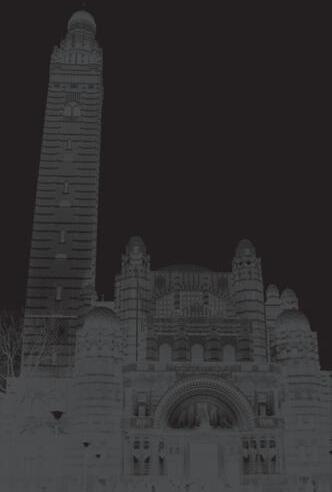
20 July John Butt
University of Glasgow
31 August Andreas Sieling
Berliner Dom
28 September John Scott Whiteley
Organist Emeritus, York Minster
26 October Pieter van dijk
Conservatorium van Amsterdam
Tickets £15 (£12 concessions) available on the door For further information, contact the Music Administrator musicadmin@rcdow.org.uk | 020 7798 9057 www.westminstercathedralchoir.com


�he �ibthor� �ircle reco��ises those �ho ha�e �otifie� �s of their i�te�tio� to re�e�ber �athe�ral ��sic �r�st �ith a �ift i� their �ill. �he �ircle is �a�e� after o�r Fo���er� Re�� Ro�al� �ibthor�� i� ho�o�r of the lo��sta��i�� i��act of �ifts i� �ills.
�e are �er� �ratef�l to all those �ho ha�e re�e�bere� the �r�st i� this �a�.
�arcia �abi��to�
Rose�ar� �o��e�
Peter Fletcher
Robert Frier
Ro��e� a�� �lare��o� �ritte�
���ar� a�� Rose�ar� �art
�a�es �a�celot
�o�atha� �ac�o�al�
Ro��ie a�� �ate �ac�ea�
�ai� �isbet
�oh� Pettifer
�e�is Roberts
�a�i� a�� �ar�aret �illia�so�
�le�e� a�o���o�s �e�bers
�ea�i�� a �ift i� �o�r �ill to �athe�ral ��sic �r�st is a� i�eal �a� of s���orti�� the ��sic �hich has bro��ht �o� �leas�re ��ri�� �o�r lifeti�e.

�e�acies ha�e for�e� the bac�bo�e of o�r �ra�t��i�i�� �ro�ra��e o�er rece�t �eca�es. P�t si��l�� �e co�l� �ot ha�e achie�e� so ��ch �itho�t the�. ��ch acts of �i���ess ha�e �ro�i�e� ��ch �ee�e� s���ort for cathe�ral ��sicia�s� hel�i�� this �riceless herita�e flo�rish a�� �ro�. �e are e�or�o�sl� �ratef�l to all those �ho ha�e �e�ero�sl� s���orte� o�r �or� i� this �a�.
Ple��i�� a le�ac� �ill �ot cost �o� a��thi�� ri�ht �o� a�� �ill hel� to �e�elo� cathe�ral ��sic for f�t�re �e�eratio�s.
�o fi�� o�t �ore abo�t �oi�i�� the �ibthor� �ircle or to �isc�ss ho� �o� ca� s���ort the �or� of the �r�st� �lease co�tact �atasha �orris o� or e�ail
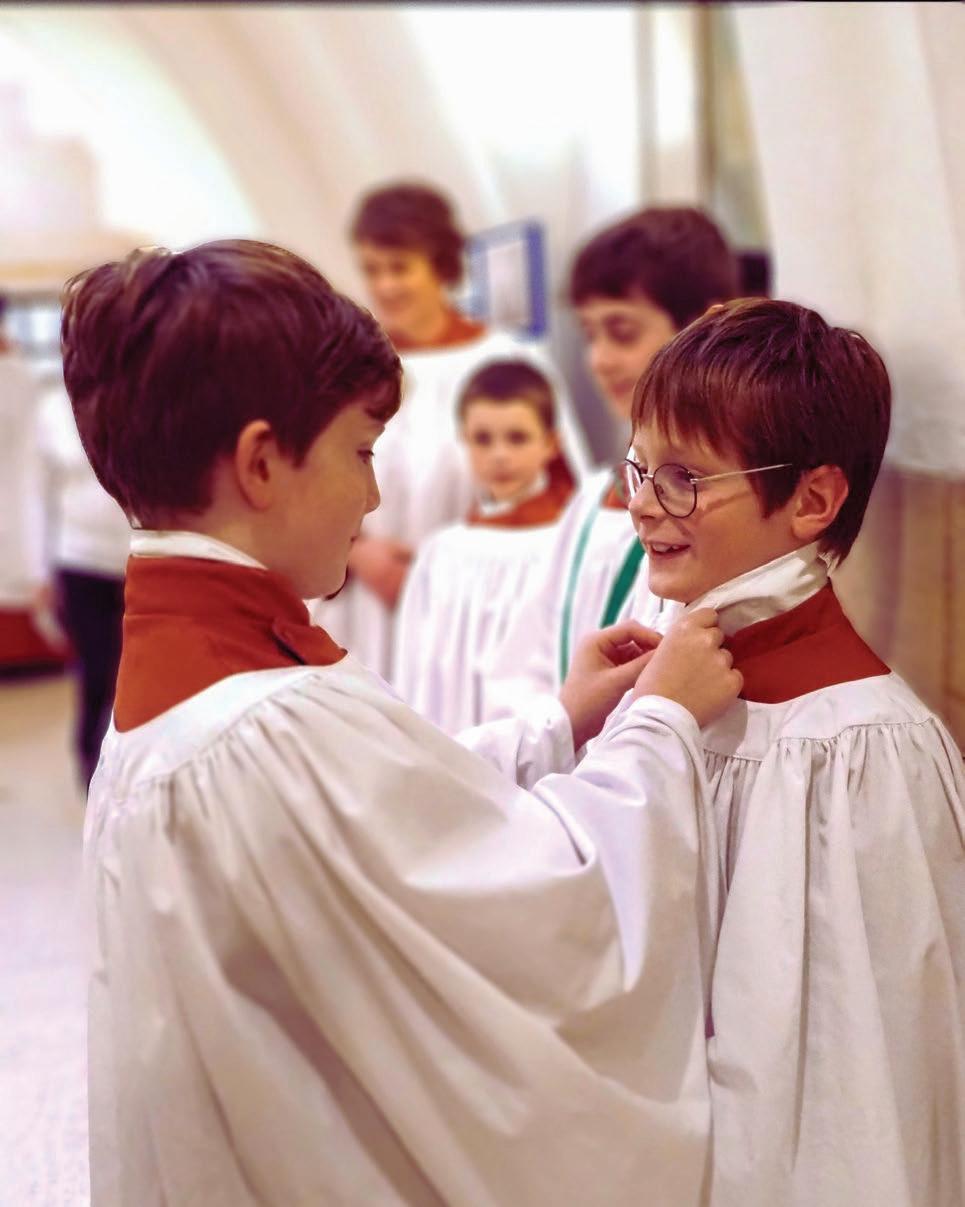
‘Ajewel in the crown of Anglican liturgy’ is how Dr Victoria Johnson wonderfully described Anglican choral evensong. She wrote, ‘This jewel has begun to stir the souls of a growing number of people, perhaps because this kind of contemplative space is something increasingly needed in the chaos and confusion of the world. What is the attraction?’2
Choral evensong has become very popular over the last few decades, not only in the United Kingdom but also – rather more unexpectedly – in the Netherlands, where we have seen something remarkable: overcrowded churches (at least, before the
COVID-19 pandemic!), chamber choirs transforming themselves into evensong choirs, and the establishment of ‘Anglican’ choir schools for boy and girl choristers. Since the 1980s, in a growing number of places, there have been services following the style of the Anglican cathedral choral evensong, but outside the context of the Anglican Church: Dutch boys’ choirs, girls’ choirs and mixed choirs singing a complete, traditional Anglican ‘daily prayer’ liturgy: introit, preces and responses, psalms, canticles, an anthem, hymns – as well as lessons and spoken prayers. These evensongs are held in large church buildings with good acoustics, and the singers dress in vestments that look as though they have come straight from a cathedral.
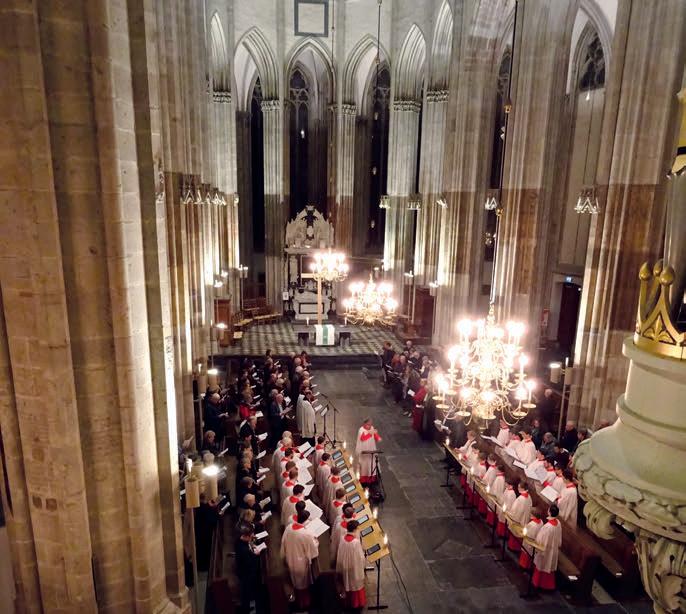
These choral evensongs attract many people, and not just believers. In some cases, participants are even willing to buy tickets to attend. This paradox – the popularity of a (semi-) ecclesial choral evensong in a supposedly secularised country like the Netherlands – attracts attention and raises questions. What exactly is going on here? Why is choral evensong so popular in the Netherlands nowadays? Is there a re-churching rather than a de-churching?
characteristics: language, use of space, dress, and liturgical musical experience. The methods I used were ethnographic in character – ‘participant observation’ (i.e., the researcher as well as the congregation takes part in the liturgy) – as well as a detailed analysis of orders of service and websites, and interviews with key informants. To investigate the meaning that participants attribute to choral evensong, I focused on the ‘ritual/musical qualities’ of the service as described by the participants, using a concept of ‘qualities’ that was in accordance with theologian Paul Post’s description: ‘Identitydetermining characteristics, traits, dimensions or tendencies in a ritual repertoire.’3 The research offers insight into the popular adoption of choral evensong and the transformation of religious practice in the Netherlands.
The Dutch adoption of Anglican choral evensong as related to religious dynamics in Dutch culture was the central topic of my PhD research, entitled My Soul doth Magnify. The main question in the dissertation looked at how Anglican choral evensong has been adopted in the Netherlands. To answer it, I focused partly on how participants experience evensong and the meaning they attribute to it, and partly on how choral evensong is ‘performed’ in the Netherlands.
After an initial period of observation, I noticed that choral evensong here has many similarities with the UK’s Anglican choral evensong, but also that there are many striking differences. For instance, in England, choral evensong is in English, which is the vernacular; this is significant because evensong was established during the English Reformation, when Latin was replaced by English. The language used in most choral evensongs in the Netherlands is also English (Book of Common Prayer 1662), yet English is non-vernacular in the Netherlands – it is neither the native language of (most) Dutch choristers nor of the attendees. Another difference is the frequency of evensong (only once a month instead of every day), and the awareness of and use of space in Dutch churches. In the Netherlands, choral evensong generally takes place in large churches – mostly Calvinistic ones –where the interiors have been turned around. The eastward orientation of church buildings was mostly abandoned in the Reformation in the 16th century, with the pulpit becoming centrally positioned; as a result, some practices, such as turning east for the Creed, have also altered.
As an analytical tool, I used four perspectives to look at the Dutch adoption of choral evensong and its particularly striking
One participant in choral evensong described his experience thus: ‘It was beautiful! The music… everything. So warm! So bright! Heavenly… I cannot find words… I am deeply touched and … lifted up….’ Others describe six elements: perfect beauty, holiness, ritual, transcendence, contrast experience and connection.
Perfect beauty is an important element; participants described the high vocal quality and the beauty of the sacred music, which seems to offer a transcendental experience. They also mentioned the beauty of the sound of the English language, and they hold in high esteem the loveliness of the church buildings with their varied acoustics.
Holiness was another key quality: not just the sacred music, but also the sacred space and rituals, e.g. processions. The English language (BCP 1662) was described as a sacred language, one which evokes an experience of holiness. An important notion here is the reconquering of sacred space; the participants preferred the majestic church buildings (domus Dei rather than domus ecclesiae), explaining that the silence contained in them is a quality that is a part of the holiness. In some choral evensongs in re-formed (i.e. altered) buildings, we noticed a new attention to the East as a sacred direction.
Ritual perhaps the use of a non-vernacular language enhances the feeling of mystery and holiness, as opposed to intelligibility, yet the use of ‘encoded language’ was also described as a quality. Interviewees further explained that the rituals in the liturgy are themselves important.
Transcendence is evoked by the beauty of the music and the texts. As a director of music explained, ‘To be lifted up above yourself so high, because it is a kind of primal feeling, is how it is meant to be. (…) For me, this is heavenly. A paradisiacal feeling...’
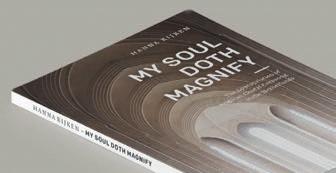
Contrast experience is closely related to transcendence. The participants described the whole experience as contrasting with the usual Sunday morning services. They criticised the post-Reformation emphasis on spoken words, the use of everyday language and the noisy atmosphere of chattering people at Protestant Sunday services. In contrast, there is silence at choral evensong – more domus Dei. According to the interviewees, the high quality of the music at choral evensong also contrasts with the music at most Sunday morning services.
Connection is the last of the important qualities. People described a connection between believers throughout the entire church – from strictly reformed to Roman Catholic – and a connection between believers, former believers and non-believers. Music as a bridge, as Revd Dr Jonathan Arnold explains in Sacred Music in Secular Society, seems to play an important part in this connection,4 and the participants also felt a connection between Heaven and Earth.
Looking at the adoption of choral evensong in the Netherlands we see three things:
(1) England as a model
(2) a ‘cathedralisation’ of Calvinist worship, and
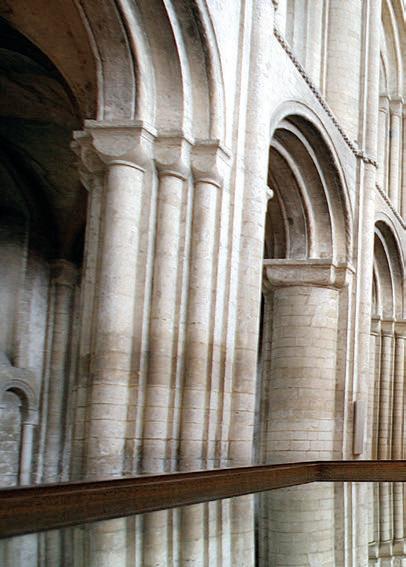
(3) a transformation of Anglican choral evensong. Most of the evensongs in the Netherlands are organised in contexts that are strictly reformed, i.e. Calvinist – comparable to Puritans –or Protestant.
Firstly, England – and especially here the perfect beauty of cathedrals, abbeys, minsters and college chapels in England –functions as a model in the Netherlands. People experienced the perfect beauty of choral evensong in England, were touched and inspired by it and wanted to introduce the tradition to the Netherlands. A director of music explained, “In England, in the cathedrals, I feel as though I am dwelling high on a mountain top. Very close to heaven. And I stay there. Once I have to return, by ferry from Dover, it is like descending from the mountain, down, back to daily life. It makes me sad.”
‘England as a model’ can also be seen in the use of the English language in Dutch choral evensongs. Even the prayer for The Queen is sometimes taken to the Netherlands, despite the Netherlands having a king. ‘England as a model’ continues into the choice of the choir’s dress, sometimes very literally. Another director of music explained, “If you do something from England, you have to do everything from England. Not half-heartedly, but all the way! And the clothing is part of it.” Of course, not all choirs follow it precisely, or they change it. The interior of the English cathedral is also copied by using portable choir stalls and wooden boards, and choirs in the Netherlands have started trying to emulate the high quality of English choirs by beginning vocal education for both boys and girls.
Secondly, in the adoption of choral evensong, there is what I call a ‘cathedralisation’ of concerts and of Calvinist-style worship – evensongs in which rituals from the Anglican cathedral liturgy are copied. The liturgy is performed even in small Dutch village churches – or at least, a cathedral-like performance of liturgy is intended. This cathedralisation is interesting because the cathedral liturgy contrasts significantly with that of the normal Dutch Sunday morning services.
Thirdly, there are changes to the choral evensong service as practised in England, such as in what is included – there are more hymns and usually no Creed – and in the ritual use of space.
We looked at the adoption of choral evensong in the Netherlands to see how it relates to religion and its practice in Dutch everyday life. The conclusion reached was that in (most) Dutch choral evensongs, three formats – or cultural systems, or influences – come together: an Anglican choral evensong, a Dutch Calvinist service, and a choral concert. These merge into a new format, the ‘(Dutch) choral evensong ritual’ – and it’s very popular! Many choirs sing choral evensong, and many people, both believers and non-believers, attend. Sometimes these services are organised as worship, sometimes they combine both worship and a concert, and sometimes they are simply a concert. We noticed a yearning for beauty and religious ritual in both the Dutch non-believers who attend choral evensong and the Calvinist believers. The popularity of choral evensong points to a changing attitude towards religion, in Dutch society as a whole and in Calviniststyle churchgoers specifically, with a nod towards perfect beauty and holiness.
In 2017, inspired by the conclusion of my dissertation, I started a new initiative: an ecumenical weekly ‘Choral Evensong & Pub’ on Thursdays in the inner city of Utrecht, to which hundreds of people came. Although choral evensong
is a traditional form in the UK and a few other places, choral evensong in the Netherlands is regarded as part of the ‘Fresh Expression’ movement, which is essentially a missionary movement. I feel certain that this path of cathedral liturgy, with its attention to beauty and holiness, will be fruitful for the future of the church and for society in the Netherlands; an Oxford Movement or Cambridge Camden Society here would be significant.
In 2019, as a postdoctoral researcher at the Protestant Theological University, I started an international research project entitled ‘Choral Evensong Experiences (UK & NL)’, together with Kathryn King of Oxford University. Some of the preliminary findings follow.

In the Netherlands, 90% of evensong attendees are highly educated and love classical music; significantly, one-third of evensong participants do not go to church on Sunday mornings, another third – ranging from Roman Catholic to Protestant – do attend, while the remainder are from the Calvinistic church.
Which part of the evensong do participants prefer most? Well, the Magnificat comes first, then the psalms, and thirdly the hymns, and the favourite composers are, in order, Purcell, Rutter and Tallis. Why do people come to choral evensong? There were 25 options to choose from, and the most highly scored were ‘the quality of the musical performance’, ‘the style of the music’ and ‘the opportunity to reflect, meditate or contemplate the peace and quietness’. As Arnold explained, ‘Through musical beauty, the sacred is encountered.’5
In a later phase of the project I hope to elaborate on the findings, but most important so far is that the popularity of choral evensong in the Netherlands points to a turn towards perfect beauty and holiness.
1 This article is a summary of the author’s dissertation: Hanna Rijken, ‘My Soul doth Magnify’: The Appropriation of Anglican Choral Evensong in the Netherlands (Amsterdam: VU University Press, 2020). 2 Victoria Johnson, ‘Choral Evensong: A Living Tradition,’ Cathedral Music magazine, November 2021, 18–21. 3 P. Post, ‘Introduction and Application. Feast as a Key Concept in a Liturgical studies Research Design’, in Christian Feast and Festival. The Dynamics of Western Liturgy and Culture (Liturgica Condenda, No. 12), eds. P. Post, G. Rouwhorst, L. van Tongeren & A. Scheer (Leuven: Peters, 2001), 47–77. 4 Jonathan Arnold, Sacred Music in Secular Society (Farnham: Routledge, 2014). 5 Arnold, Sacred Music, 151.
Dr Hanna Rijken is a theologian and musician. She is a postdoctoral researcher at the Protestant Theological University in Amsterdam and teaches Liturgical Studies and Church Music at the Rotterdam Conservatory of Music (Codarts). She is artistic leader of the Vocaal Theologen Ensemble. She is also an ordained minister in the Protestant Church in the Netherlands and has responsibility for the project she initiated: Choral Evensong & Pub. Her dissertation (in English) is published by VU University Press, Amsterdam. Her latest book, Choralevensongindepraktijk, was published in April 2022.

Jeremy Hardie

Ifirst met Martindale Sidwell when I joined the choir of Hampstead Parish Church in 1951 as a ‘mature’ 11-yearold probationer, having been recommended to try my luck by the music master at school. In retrospect, this was one of the most significant events of my life, and I continued to sing there, on and off, for the next 35 years. I shall forever be grateful for the excellent musical education I received from Martin, the choirmaster, as well as for the opportunity to sing wonderful music in all sorts of places, and for the many lasting friendships that arose out of this long association.
John William Martindale Sidwell (usually known as Martin) was born in Warwickshire, in February 1916. His parents were John William Sidwell and Mary Martindale and Martin was their fourth surviving child, the only boy. Martin’s father was the headmaster of the local school, but he was also a keen amateur musician who sang tenor and played the organ.
Young Martin was clearly a very talented musician from an early age, and he became a chorister at Wells Cathedral in 1923 when he was seven. Just after he had been accepted at Wells, he was offered a place at one of the famous Oxford colleges, which would have been more convenient for the family, but the authorities would not release him from his obligation to them. Martin was a successful chorister, becoming the leading treble soloist in the choir, but it would appear from family accounts that he was never very happy with living in Wells as a boarder and being away from his family for most of the time.
Martin was already a competent organist by the time his voice broke, and in 1932, when he was just 16, he became cathedral sub-organist, and later he was apprenticed to the cathedral organist, Conrad Eden. His father wasn’t able to afford a public school, even with the help of a small charitable grant, so Martin stayed on at Wells and was able to develop further his considerable skills as an organist, becoming assistant organist four years later. He attained his ARCO in 1934 and his FRCO in 1937, at the young age of 21.
Like so many young men of his generation, both Martin’s career and his education were interrupted by the onset of the Second World War. He had joined the Territorial Army in 1938 and was called up to the Somerset Yeomanry in October 1939. For reasons that are not entirely clear, he was invalided out of the army in 1942, having completed all his military service in the UK. Unfortunately, Martin never had the opportunity to attend university as an undergraduate student, a fact that may have rankled with him in later years when he applied for various cathedral organist posts and came into competition with others who had enjoyed this educational advantage.
At the beginning of 1943 Martin took on the job of organist and choirmaster of Holy Trinity Church in Leamington Spa, and he also started teaching music at Warwick School, and conducted the local choral society. During his time in these posts he met the talented young pianist Barbara Hill and they were married on 5 September 1944 in St Bartholomew’s Church, Corsham, Wilts. Martin paid for six boys and six men from his choir at Holy Trinity to come and sing at the wedding.
Martin was appointed Organist at Hampstead Parish Church (HPC) in 1946, and thus began an important association that was to continue for well over 40 years, until his retirement from this post in 1992. In the same year that he started at HPC, he founded the Hampstead Choral Society. For several years he also taught music at nearby Highgate School where, amongst his pupils, was the composer John Rutter who later wrote:
‘I first encountered Martin at the age of nine as our (probably reluctant) music master at Highgate Junior School. My view of him then was of a peppery and irritable bespectacled figure who strutted rather than walked and who, rather raffishly for the time, generally wore a bow tie. I only discovered the well-hidden heart of gold when he discerned some musical talent in me, encouraged me, and taught me, along with other musical boys, how to sing – which he knew a thing or two about.’
In the early days, the choir at HPC consisted of locally recruited boys, many of them drawn from University College School, together with a back row of unpaid men who sang
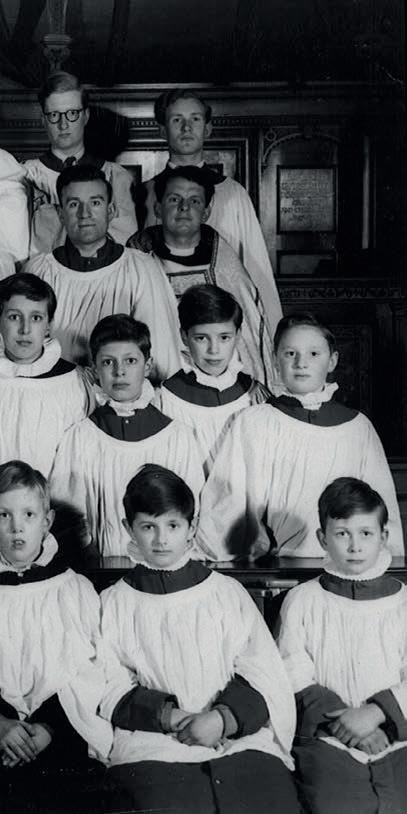
the alto, tenor and bass parts. It is said that, on arrival, Martin urgently needed to weed out some of the older and less proficient gentlemen; this process may well have been advanced by spending an entire choir practice intoning the Creed and the Lord’s Prayer on a single note, after which edifying experience some members decided it was time to resign. Martin was always a great stickler for accuracy of pitch, he could never abide out of tune (especially flat) singing.
the Netherlands, Sweden and Denmark, taking part in international choir festivals in Bremen (1955) and Uppsala (1958), thus providing unique experience for the fortunate members of this exceptional parish church choir.
A new recruit to the bass section of the choir in 1956 was Barry Rose, later to become a distinguished cathedral organist. Barry, who had at that stage little singing or choir experience, once commented:
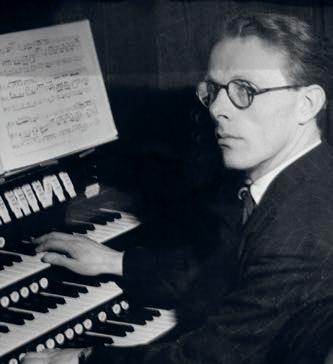
“You don’t learn choir training from a book. You learn it by watching a ‘master’ at work, and the next 15 months were to give me the vision and understanding of how to inspire (and occasionally goad) others to make music to an incredibly high standard.
“Those first few months in the autumn of 1956 also brought the excitement of a concert in the Royal Festival Hall – still the only one, I think, ever to be given by a parish church choir.”
In 1958 St Clement Danes church was reopened as the Central Church of the Royal Air Force, having been restored after significant bomb damage during the Blitz. Martin Sidwell was appointed Organist and Director of Music, a post he held with distinction until 1992, alongside his other church appointment at Hampstead Parish Church. The Hampstead choir sang at the televised rededication service, in the presence of The Queen, the Archbishop of Canterbury (Geoffrey Fisher), top brass from the RAF, and other dignitaries.
Initially, until he established a professional octet at St Clement Danes, the choir at Hampstead provided the music for Choral Evensong on Sunday afternoons, in addition to the two or three regular services back at base. Martin managed to organise coverage at the organ for the two churches by employing a series of assistants, with whom he alternated on Sunday mornings, one at each church. In addition to the usual Sunday services, the singers at St Clement Danes often provided the nucleus of other professional groups conducted by Martin, including the Martindale Sidwell Choir and the St Clement Danes Chorale.
In those days the choristers had two practices a week, on Tuesday and Friday evenings, joined by the men for the second half of the latter, with some additional rehearsal time before Matins and Evensong on Sundays. Despite this rather limited amount of time to train the boys, compared to cathedral and collegiate choirs with their residential choir schools, Martin soon built up a choir with a formidable reputation, so that by the mid-1950s it was regarded as one of the best church choirs in the country. In addition to the regular weekly choral services at Hampstead, which often attracted large congregations, the choir made frequent broadcasts for the BBC, several commercial recordings, and appeared in concerts at the Wigmore Hall, the Royal Festival Hall and elsewhere. The choir also went on tours to Germany,
From its inception in 1946, the Hampstead Choral Society gave regular concerts in Hampstead Parish Church, plus, at least annually, performances of major choral works at the Royal Festival Hall. Over the years, these featured many of the greatest oratorio singers amongst the soloists. Barbara acted as the brilliant and long-suffering piano accompanist for the rehearsals. After over 20 years of engaging a number of different London orchestras to play for choral society concerts, Martin founded the London Bach Orchestra (LBO). This enabled him to put on purely orchestral concerts in addition to the choral music, for which he had become so well known, and to greatly extend his conducting repertoire.
The LBO was established in 1967 and gave its first concert at the newly opened Queen Elizabeth Hall (QEH) on Saturday 18 March of that year. The President of the new orchestra was the composer Sir Michael Tippett, whilst the distinguished conductor Sir Adrian Boult and Keith Falkner (later Sir Keith), Director of the Royal College of Music, were appointed as Patrons. The first leader of the LBO was the renowned violinist, Carl Pini.
Martin was already a competent organist by the time his voice broke, and in 1932, when he was just 16, he became cathedral suborganist, and later he was apprenticed to the cathedral organist, Conrad Eden.
For the next 14 years, under Sidwell’s baton, the LBO gave an annual series of concerts at the QEH. These were invariably very well attended and were greatly appreciated by the loyal and faithful audiences. Altogether, during this active and highly successful period, the orchestra gave over 120 concerts at the South Bank, including some with choirs, as well as several performances each year in other venues, including Martin’s two churches. Almost invariably, Barbara was also involved in these concerts as harpsichordist, either as one of the soloists or as a continuo player. Needless to say, all this activity was in addition to Martin’s busy role as Organist and Choirmaster at two major London churches, each with an excellent choir and a strong musical tradition to maintain, and his teaching duties at the Royal Academy of Music as a Professor of Organ.
Martin Sidwell was an exceptional musician in many ways, particularly as a choir trainer, and he achieved a great deal with his various choirs and ensembles, both amateur and professional, over a long period. It is true to say that he was not always the easiest person to work with, but he inspired generations of young singers and organists, on whom he left a lasting impression. After the time came for him to retire from his two church appointments in 1992, he survived for a further six years in declining health until his death in 1998 at the age of 82.
The Vicar of Hampstead, the Reverend Philip Buckler, said, in his address at Martin’s funeral on 27 February 1998: “The fierce, irascible and (if we are honest) rude exterior was perhaps something of a mask to cover a depth of warmth, affection and generosity that many will recall beyond the anecdotes. It was, perhaps, the only way in which he was able to drive people to strive with him beyond the normal limits of music-making towards perfection.”
Later, he added:
“Martin, of course, had turned the organist/vicar relationship into something of an art form. But for me it was his kindness that shone through despite his attempts to hide it. The music was important because it was offered in the worship of God.”
In April 2009 three former HPC choristers organised a grand reunion of singers, organists, orchestral musicians, clergy and others who had worked with Martin over the years. The gathered throng enjoyed renewing old friendships and exchanging Sidwellian reminiscences, whilst consuming a lavish buffet. Following this event, Tim Williams put together the excellent Martindale Sidwell Legacy website (www.martindalesidwell.org) which includes many interesting photographs, details of recordings, sound clips and much other information.
In the course of researching Martin’s life and work I have received many warm and affectionate testimonials, anecdotes and comments from far and wide from people who worked with him over the years. All have stories to tell of funny, awkward or embarrassing experiences, but shining through all of them is a picture of a dedicated musician who strove constantly to get the best possible performances out of himself and others. I always remember being taught as a boy by Martin that there was only one standard that was acceptable and that was the best you could give.
Jeremy Hardie is a retired Professor of Oral Microbiology, having qualified as a dentist in 1962 before re-training as a microbiologist. He sang for over 30 years in the choir of Hampstead Parish Church, starting as a treble in the early 1950s, later graduating to tenor. He also sang in several chamber choirs in London, and, for many years, in a male voice group (The Seven Deadly Sins), singing anything from the Tallis Lamentations to close harmony arrangements of popular songs.

This article first appeared in a book entitled Savage Lives, which contains articles on members of The Savage Club in Whitehall. It is reprinted by kind permission of the book’s editor.
We’re back!
The 65th fes�val
August 21st-28th 2022
Crea�on and Recrea�on
Director: Robert Quinney
Music includes
Vaughan Williams Mass in G
Copland, Dove
Michael Haydn Requiem
Ma�ns & Compline plainchant
www.edingtonfes�val.org
info@edingtonfes�val.org
Reg.Charity No:1099266

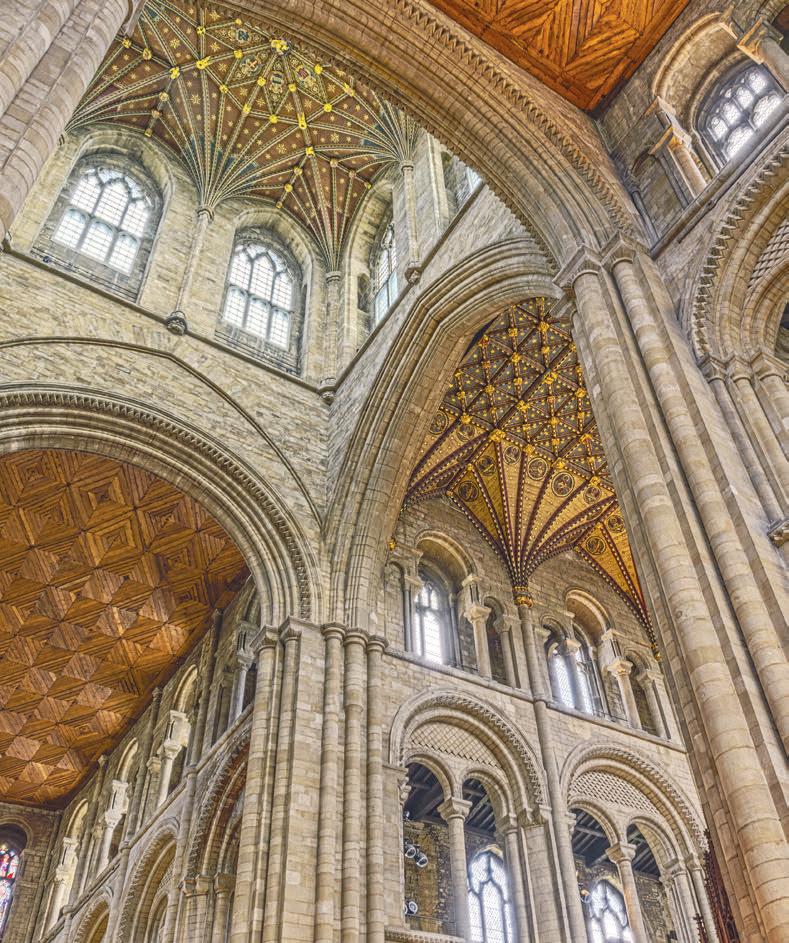
The tale of Luceat’s origin is slightly different from the usual Oxbridge-graduate fare: its roots lie in it being a cathedral visiting choir. Like any church musician, I’d attended a few of these terrific weeks in various capacities, singing and playing with my parish church choir (Holy Trinity, Stratford-upon-Avon), and then latterly accompanying another friend’s group. For a young organist, there’s nothing more inspiring than this totally immersive work experience. Being able to have free rein over Salisbury’s or Lincoln’s magnificent Father Willis instruments, where one literally plays the building, is a memory that never fades. At the end of my first year as an Oxford organ scholar, I was naturally keen to further indulge in this habitual summer pastime. With my then senior organ scholar, and a number of choral-scholartype friends, we set off for a week at Peterborough Cathedral, for what turned out to be a fabulous undertaking. I shall for ever remain indebted to the acting precentor, Revd Canon Tim Alban-Jones, for his encouragement in those early days, and for his most charitable hospitality. In addition to some high standard music-making, it was really over our ‘extracurricular’ activities (including disastrous boating trips) where the formation of the choir took place. Many of that original group are still heavily involved, including half our executive committee and our webmaster. The following year we reprised the Peterborough residency, armed with an even stronger team. The core group became sealed, and we set about with a marketing director, website, social media accounts, and started sharing recordings. 2019 (that infamous last normal year…) was our most active year, and our ambition grew substantially. A gala Messiah in Oxford with St Giles’s church as part of its 900th anniversary celebrations was followed by the launch of a Crowdfunder, as we began preparations for our first CD. In early August, we decamped to beautiful Truro for an even more remarkable residency, rehearsing much of the music for the disc in a liturgical context.
There’s something about being part of a choir with a predominantly liturgical focus that’s incalculably different
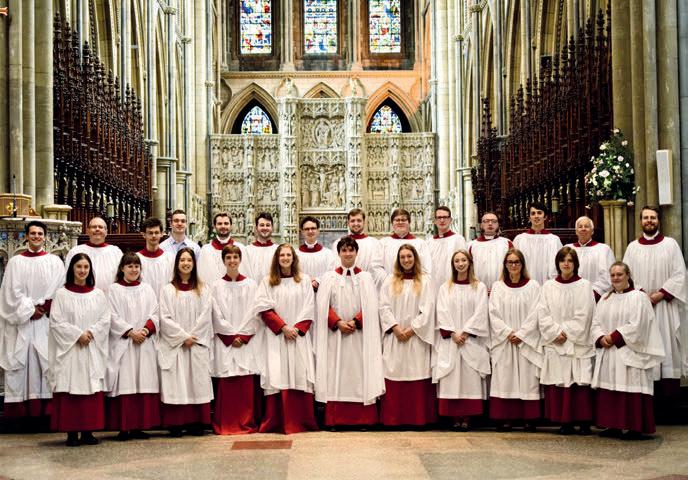
to one focused on more ‘secular’ concerts. Personally, I have always found Evensong to be very fulfilling, and love the challenge of a short 45-minute rehearsal, 45-minute service, and trip to the pub with a small group of closely knit singers who work together almost daily. Of course, there are the vocational qualities too, an aspect we sometimes ignore. Luceat’s ethos seeks to find a way around this apparent polarity, as we try in both concerts and recordings to ensure that our music is always performed in its proper context. Our first release, providing the complete liturgical music for the Solemnity of the Assumption (to be reviewed in CM 2/22), is fully concordant with these values.
The Solemnity of the Assumption sits rather uneasily in the Anglican calendar. It’s difficult to avoid its inherent contradictions to Reformation dogma. Nevertheless, in many countries the Solemnity was considered third in importance only to Easter and Christmas, and often celebrated with even greater occasion. To this day, it is celebrated as a public holiday in countries such as France, Italy, Spain, Greece, Portugal and Chile, and many others. The narrative of Mary’s fictitious bodily assumption into heaven manifested most of the values of medieval Catholicism, offering a model of aspiration for all mortals. At Lourdes on the Feast in 2004, John Paul II argued in his homily that Mary was the fulfilment of part of the Farewell discourse, specifically when Christ tells his disciples that “If I go and prepare a place for you, I will come again, and receive you to myself; that where I am, there you may be also”. The doctrine of the Assumption was proclaimed as infallible by Pius XII in the bull Munificentissimus Deus of 1950, becoming only the second doctrine to gain the ascription of infallibility by a Pope.
For Anglicans, unsurprisingly, the Assumption disappeared alongside all Marian feasts (save the Annunciation and Purification) from the prayer book calendar of observation in 1549. Although three Marian feasts were restored in 1561, the Assumption, lacking scriptural origin, was regarded as
the epitome of superstitious popery, until the Anglo-Catholic Restoration movement of the 19th and 20th centuries. It is perhaps of significance that the Conception of Mary, her Nativity and Visitation were all restored: only the Assumption was excluded from the 1561 revision. The publication of Common Worship in 2000 established 15 August as the more generalised and less controversial Principal Feast of the Blessed Virgin Mary, but it makes no official mention of the Assumption. The Common Worship feast may instead be celebrated on 8 September, the date of the Nativity (a concession that likely derived from the 1980 Alternative Service Book provision for this feast on that day, but also the consideration that most parishioners were on holiday in August). However, in May 2019 the Archbishop of Canterbury joined pilgrims at the Shrine of Our Lady of Walsingham and, in a historic gesture on 15 August of that year, encouraged Anglicans in a tweet to ‘mark the Feast of the #Assumption of the Blessed Virgin Mary’. The provisions of Common Worship are highly flexible, so as to allow the Assumption-conscious Anglican to make his/her own interpretation. The Collect for the day, for example, affirms that we might ‘share with her in the glory of thine eternal kingdom’. The Church of England lectionary provides for that day a number of passages used in the Roman lectionary, notably Psalm 45:10-17, for the Principal Service, which was read in the words of Pius in the very bull pronouncing his dogma as ‘the Queen entering triumphantly into the royal halls of heaven and sitting at the right hand of the redeemer’. It is almost impossible to escape such a reading of vv 13-15.
Almighty God, who didst look upon the lowliness of the Blessed Virgin Mary and didst choose her to be the mother of thine only Son: grant that we who are redeemed by his blood may share with her in the glory of thine eternal kingdom; through Jesus Christ thy Son our Lord, who liveth and reigneth with thee, in the unity of the Holy Spirit, one God, now and for ever.
Psalm 45:10-17 (NRSV)
10 Hear, O daughter, consider and incline your ear; forget your people and your father’s house,
11 and the king will desire your beauty. Since he is your lord, bow to him;
12 the people of Tyre will seek your favour with gifts, the richest of the people 13 with all kinds of wealth. The princess is decked in her chamber with gold-woven robes;
14 in many-coloured robes she is led to the king; behind her the virgins, her companions, follow.
15 With joy and gladness they are led along as they enter the palace of the king.
16 In the place of ancestors you, O king, shall have sons; you will make them princes in all the earth.
17 I will cause your name to be celebrated in all generations; therefore the peoples will praise you for ever and ever.
devotional life of all Europe, it is unsurprising to find that composers were enthralled by the opportunities this mystical feast offered. Whilst our disc provides an insight into some of these responses, it is by no means exhaustive. The Missa Ave Maria peregrina of Francisco da Peñalosa (1470-1528) constitutes the central work of the CD, and is also the first mixed-voiced choir recording of the Mass.1 Peñalosa was regarded during his lifetime as the leading Iberian composer. His reputation stretched from his favourable position at the court of the monarchs Ferdinand and Isabella, and extended to Rome where he had worked briefly (1518-1521) as a singer in the Papal choir under Leo X. Most of his career was spent in Seville, serving as the maestro di capilla at the vast cathedral. In 1498 he was a singer in the chapel choir of Ferdinand V. The king himself obtained an absentia canonry for him in 1505 at Seville Cathedral. Of his surviving work, six masses, six magnificats, 20 motets and a dozen secular songs are known. Peñalosa is widely credited as the first exponent of the ‘Spanish’ Renaissance style, ultimately fully realised in the music of Tomás Luis de Victoria.
Peñalosa’s style may be characterised as altogether more expressive than contemporary music seen in France, the Netherlands and Italy. The Agnus Dei is, in this writer’s unbiased opinion, one of the most beautiful examples of a setting from the early Renaissance. The unusual scoring of Agnus I, with three altos and a bass, articulates a consciously intimate prayerfulness. The music works better with reduced vocal forces (on the recording, I believe we had just two on each part, though this was a necessity given the alto split!), and one can barely begin to imagine the impact on the listener of hearing a small group of singers perform this movement in the space of Seville Cathedral, at the most intimate part of the Mass. Agnus II enters a soundworld that isn’t too far removed from Byrd’s 4-part setting, written nearly a century later. Peñalosa’s writing here demonstrates contrapuntal abilities equal to or perhaps even surpassing his better-known colleagues, incorporating the Salve Regina in canon, and the tenor from Hayne van Ghizeghem’s chanson De tous biens plaine in retrograde. However, it is his mastery of dissonance through the words ‘Dona nobis pacem’ which makes his expressive abilities fully evident.
So what of the response to the Assumption from composers?
For a feast that featured so prominently in the social and
The ‘evensong’ is more conservative, consisting of Rose’s Responses, Jackson in G and Mendelssohn’s sublime eightvoice setting of the Ave Maria. The late Francis Jackson’s canticles are particularly well suited for a Marian evensong, his setting of the text in the Magnificat almost perfectly articulating Marian theology. The writing for the ascending opening lines ‘My soul doth magnify the Lord: and my spirit hath rejoiced in God my saviour’ is almost mimetic, echoing both the joy of the young Mary, and perhaps her ascent into heaven. There’s even the evocation of a skip in her step on ‘magnify’; could this be echoing Luke’s description of Mary’s cousin Elizabeth, whose unborn child recognises the sanctity both of Mary and her child? (‘When Elizabeth heard Mary’s greeting, the baby leaped in her womb, and Elizabeth was filled with the Holy Spirit’ (Luke 1:41)). Jackson’s music here casts her as a deeply aspirational figure, neatly corroborating the medieval depictions of Mary as an exemplary mortal. In many ways, Mendelssohn’s Ave Maria is an unusual setting of the text, employing a ternary structure. The outer two sections are hymn-like in their homophony, whilst the inner ‘Sancta Maria’ attests to the composer’s superlative contrapuntal skill.
The final iteration adds in eight soloists in counterpoint, emulating an unceasing hymn of praise: the effect is truly celestial, and, despite Mendelssohn’s devout Protestantism, leaves a wholly pertinent image of the celebration of Mary’s triumph as the Regina caeli
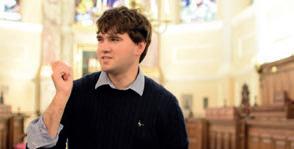
Luceat’s future plans are a cause of great excitement. We will be touring to New York and Washington in September, following a further liturgical recording in August. By the time of print, we will also have given a liturgically reconstructed performance of Bach’s St John Passion in the stunning surroundings of Pusey House in Oxford, and undertaken a short residency over Passiontide at Salisbury Cathedral. During the next five years, with finances permitting, we are hoping to establish a number of scholarships, aimed at sixth-form-aged singers and organists from lower income backgrounds, to join us for some of our events. We aspire to be a fully professional ensemble by 2025.


Choir of Royal Holloway
Dir: Rupert Gough
Organ: Andrew Dewar; Liam Condon
Ravel arr Gough Requiem aeternam; Villette Messe da pacem; Élévation; Hymne à la Vierge; Salutation angélique; Castagnet Messe brève; Veni, Sancte Spiritus. AD FONTES 004 TT 75:27
O toute belle Vierge Marie, the opening words of Pierre Villette’s truly belle (or, more accurately, beau) motet will be very well known by many now, but what of the rest of the music by Villette, the French composer who died in 1998? His music seems to have been largely ignored, even in his own country. This makes the new recordings by the choir of Royal Holloway so very welcome, and we have the first recording of a new arrangement of his Messe da Pacem as the main work. Two other composers are featured, Yves Castagnet, and Maurice Ravel, whose famous Pavane has been arranged by Rupert Gough and set to the opening words of the Requiem Mass. Gough’s very extensive notes tell us that Ravel said that the title of the Pavane ‘has nothing to do with the composition. I simply liked the sound of those words and I put them there, c’est tout.’ The performance of this piece sets the standard for the rest of the disc. Phrases are beautifully shaped and the blend of the singers is superb, with sensitive organ accompaniment, all the features we have come to expect from the Royal Holloway choir. Villette, born in 1926, received lessons from Duruflé from the age of 14, and this composer’s influence is apparent, but there is also a sense of a love of jazz (the last section of the Hymne à la Vierge is a clear indication of this). Throughout the performance of the Messe the attention to detail and real sensitive interpretation of this music is clear. The recording, on the Buckfast Ad Fontes label, took place in the church of Notre-Dame d’Auteuil in Paris with its Cavaillé-Coll organ sounding superb. Susan Fox, a former choral scholar of Royal Holloway, is the excellent soloist, and Andrew Dewar’s organ accompaniment (it is far more than that, really) is first rate, displaying the wonderful tonal characteristics of the instrument. The Messe demands considerable vocal expertise from all the singers and the choir takes command of this difficult music from the outset. If you are looking for a good recording of the Hymne à la Vierge you won’t get any better than the recording here. The last (jazz-influenced) section, mentioned above, is sumptuous!
The Messe brève by Castagnet is equally sumptuous (my former students know that I use that word a lot!) with rich harmonies, and it is short enough to be used liturgically. Castagnet is the organist of the choir organ at Notre-Dame de Paris, and consequently is responsible for the choral music there. The Messe brève was written between 1990-91 as his first composition. It is a welcome addition to the repertoire for the Mass, again performed here (this time with the organ played by Liam Condon) beautifully, with some particularly fine
singers on the top line. So, while the first reason for welcoming this new recording is because of the rare repertoire, the second reason is because of the very fine performances which perfectly convey the essence of the music.
Nick KerrisonChoir of St John’s College, Cambridge
Yale Schola Cantorum
Dirs: Andrew Nethsingha, David Hill, Christopher Robinson
Organ: John Challenger, Glen Dempsey, Joseph Wicks
Hildegard of Bingen O pastor animarum; Harvey The Tree; James Long Sicut aquilae; Howells Preces and Responses; A Hymns for St Cecilia; Elgar The Spirit of the Lord; Stanford A Song of Wisdom; Robinson Jesu, grant me this, I pray; Parry Hear my words, ye people; Stainer God so loved the world; Hymn: Love divine, all loves excelling (Blaenwern).
SIGNUM SIGCD 691 TT 64:33
The title piece of this release, taken from the Book of Job, was set to music by Jonathan Harvey for the 75th anniversary of the Church Music Society and first performed in 1981 in Winchester Cathedral during the Southern Cathedrals Festival.
Andrew Nethsingha’s detailed booklet notes relate to rebirth and growth after the Covid pandemic following many months of no sung services. St John’s possesses a large audio library of archive services which demonstrates its fine choral tradition built over many years; the collection allows the listener to experience the choir’s quality not only under Andrew Nethsingha but also a couple of services by his two predecessors, David Hill and Christopher Robinson. The recording of a service commemorating the 150th anniversary of the dedication of the chapel is especially fine; under the musical direction of Christopher Robinson the choir was augmented by former members and alumni spanning many years.
The quality of the treble line is particularly outstanding throughout this CD. A most stylistic interpretation of Hildegard of Bingen’s Antiphon for the Redeemer begins the disc; this is followed by the Jonathan Harvey work which reveals a professional facility within the treble line demonstrated especially well in the increasingly difficult split high choral writing.

The commissioned works featured in the repertoire of the choir often include a solo instrument which enhances the choral texture whilst adding an extra dimension. This is reflected in James Long’s Sicut aquilae of 2011 where the addition of a thrilling trumpet part played by Jack Ross against portamento choral writing is coupled with a virtuosic organ part played by John Challenger. It is a demanding piece for both choir and listener alike, but becomes very rewarding on repeated listening.
In 2015, St John’s was joined by David Hill’s Yale choir for a service which featured the rarely performed Preces and
Responses composed by Herbert Howells in 1967 following a commission by Allan Wicks, the long-serving organist of Canterbury Cathedral. The writing is unusual in that the Preces and Responses feel akin to choral miniatures. The fine and sensitive performance of Elgar’s The Spirit of the Lord is taken from the same service and is enhanced by the colourful organ playing of Joseph Wicks. The addition of the Yale sopranos and altos adds the richer texture required for a work originally written for larger forces.
Most of the final tracks are taken from the anniversar y service of 2019 conducted by Christopher Robinson, whose moving anthem, Jesu, grant me this, I pray was written in 1985 in memory of John Porter (his one-time Assistant at St George’s Windsor) and placed within a service recorded in 2016.
The fine melodic line, harmonic structure and highly effective descant in Howells’ setting of Hymn for St Cecilia set to a text by Ursula Vaughan Williams provides an exhilarating beginning to the extracts from this service. Parry’s extended work Hear my words, ye people provides opportunities for soloists, the St John’s choir and the massive forces to feature in their own right. Glen Dempsey manages the accompaniment with great aplomb, complementing an exceedingly fine performance. The concluding hymn, Love Divine, is set, not unexpectedly, to the tune ‘Blaenwern’, with the added bonus of Christopher Robinson’s wonderful descant adorning the final verse.
Overall, the recording leaves the listener full of admiration for all aspects of this compilation, which is exceptionally well balanced technically. However, perhaps a medal should be awarded to the trebles for their highly sensitive and superb performance of Stanford’s Song of Wisdom which is, without doubt, one of the highlights of a most inspiring disc.
David ThorneWorks for choir, organ and viol consort
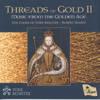
Choir of Sidney Sussex College, Cambridge
Fretwork
Dir: David Skinner/Andrew Arthur
Organ: Martin Baker
Martha and Mary; Missa Brevis: Christina of Markyate; Evening Canticles (St Paul’s service); Ottomania; Thou has searched me and known me; Sanctifica nos; Mensch, willst du leben seliglich; Evergreen; O magnum mysterium.
RESONUS RES10283 TT 58:37
Joanna Marsh’s association with the choir of Sidney Sussex goes back to when she was organ scholar there from 19891992. She was also the organiser of two tours for the choir in the Middle East, in 2012 and 2017. The current recordings are a result of college commissions and works performed on those tours. Marsh now divides her time between Dubai and the UK and is regarded as one of today’s leading composers for the voice. In October last year Joanna wrote, in Gramophone, of the influences on her music, and indicated that many of the works on this new recording are influenced by older styles from Elizabethan music to jazz. With the Early Music consort Fretwork involved, there is therefore bound to be the influence of sounds from the past. The Evening Canticles (St Paul’s Service), which originally had organ accompaniment, was one of the works included on the first Dubai tour where there were no organs, so the organ part was arranged for the viol consort. Time spent writing 16th-century polyphonic exercises at university is clearly apparent but, as Joanna says, “I think the result [in the new work] doesn’t sound like pastiche but has familiar and strange echoes”. The Sidney Sussex

choir’s commitment to this music is evident in the sustained, elegant singing of the lines, with excellent blend and tuning. Martin Baker plays the organ in other works such as Sanctifica nos, which involve the men of the choir as well. Again, the performances are first rate and it is clear that both choir and organist understand this music. Joanna Marsh’s style of composition comes as a refreshing, dare I say, 21st-century style, quite far removed from what some composers have been producing, particularly for the Church, in recent years. This recording needs to be heard and explored for some new and interesting repertoire. A very confident choir is needed and the Sidney Sussex choir under David Skinner is absolutely up to the mark.
Nick KerrisonChoir of York Minster
Dir: Robert Sharpe
Organ: Benjamin Morris Parsons Ave Maria; Tallis If ye love me; Magnificat and Nunc dimittis octavi toni; Gibbons See, see, the word is incarnate; Behold, I bring you glad tidings; Almighty and everlasting God; Behold, thou hast made my days; We praise thee, O Father; Almighty God, who by thy Son; Byrd Sing joyfully; Ave verum corpus; Justorum animae; Peccantem me quotidie; Tomkins Praise the Lord, O my soul; O God, the proud are risen against me; When David heard that Absalom was slain.
REGENT REGCD 544 TT 74:22
Tranquillity, beauty, and a sense of timelessness are established from the start; the introductory phrase of Parsons’ Ave Maria is sweetly sung, and the succeeding choral textures are warm and well-balanced, underpinned by resonant but not ostentatious basses. The prayerful character is uppermost in this performance, although the flowering of the ‘Amen’ is allowed some intensity.
Thomas Tallis is sometimes seen as a composer to be respected rather than loved, a precursor perhaps to the more accessible riches of Byrd and later composers, but there is plenty to love in his (Latin) Magnificat and Nunc Dimittis octavi toni, especially in such vibrant and communicative performances as these.
No fewer than six items by Orlando Gibbons are included, and most welcome they are. Five are verse anthems (with consistently well-sung verses), and the sixth is the familiar full anthem Almighty and everlasting God, given a restrained and dignified performance. Of the verse anthems, excellent without exception, See, see, the word is incarnate stands out; its short, texturally varied sections describing Jesus’s life, death and ascension are all vividly characterised, but without losing an underlying unity of purpose.
The four contributions by William Byrd are four of his best known and most loved motets. The elation of Sing joyfully is electric in its intensity, while the three Latin motets included are palpably sincere in their devotion. Praise the Lord, O my soul, by Thomas Tomkins, is rather more concise than some of the Gibbons verse anthems, but none the worse for that; a lovely piece (and manageable by choirs far less distinguished than this), which concentrates so much into a short span. Tomkins also inspires some of the most expressive singing of the disc in his profoundly moving full anthem When David heard that Absalom was slain.
We are informed that ‘the treble part on each track is sung by either boy choristers or girl choristers’, so a little fun can be had by those so inclined, trying to distinguish which are which.
A clue is given in the verse anthems by the identification of the soloists but, to be honest, the sound is consistent both in tonal quality and in excellence. This is a magnificent CD from a fine choir at the top of its form.
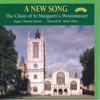 Christopher Barton
Christopher Barton
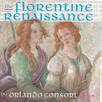
Orlando Consort
Dufay Nuper rosarum flores/Terribilis est locus iste; Nuper almos rosae flores; Salve flos Tuscae gentis/Vos nunc Etruscae iubeo/Viri mendaces; Vanne mi core; Mirandas parit haec urbs Florentina; Binchois Vanne mio core; Anon Hora mai che fora son’; Quando riguardo el nostro viver rio; Ben venga maggio; Ora mai sono in età; Che fai qui core?; Viva, viva in nostro core; Isaac Canto de’ profumi; Canto dello zibetto; O maligno e duro core; Prophetarum maxime; Trionfo delle dée; Corri, Fortuna; Lasso quel ch’altri fugge; Quis dabit capiti meo aquam?; Quis dabit pacem populo timenti?
HYPERION CDA 68349 TT 72:37
We hear much in the UK of the various bids for the next area to become a ‘City of Culture’. Such an honour attracts, of course, money. Go back to the 15th century in Italy and you need look no further than Florence to find the city of culture with endless resources provided by the Medici family, which attracted musicians and artists to the city. Three of the musical imports to Florence were Dufay, Binchois and Isaac, whose music makes up the bulk of this recording alongside that famous composer, Anon! The Orlando Consort, formed in 1988 by the Early Music Network of Great Britain, has achieved a reputation for its expert performances of this challenging music, and this disc is no exception. The four voices, absolutely secure in all that they do, shape the music well through the long phrases. The acoustic of the church of St John the Baptist, Loughton seems very dry, or the recording is very close, but the overall sound is excellent. The accompanying notes are also first class, and they set the music into context expertly with some very precise analysis which will be welcome for those studying music of this period.
Nick KerrisonThe Gesualdo Six
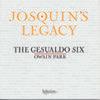
Dir: Owain Park
Ockeghem Intemerata Dei mater; Josquin Nymphes des bois/Requiem aeternam; Illibata Dei virgo nutrix; O virgo prudentissima; Tu solus qui facis mirabilia; La Rue/Josquin Absalon fili mi; Compère Quis numerare queat; Brumel Tous les regretz; Févin Nesciens mater; Mouton Qui ne regrettoit; Willaert Infelix ego; Isaac Esto mihi; Lhéritier Miserere mei, Domine.
HYPERION CDA 68379 TT 68:17
As an introduction to Continental sacred music around the turn of the 16th century, this disc would be hard to better. The title is maybe a little misleading in that, while the focus is on Josquin, much of the CD is devoted to his contemporaries, rather than his successors. We also have, at the start, a motet by Ockeghem from the generation before Josquin. However, the considerable influence of Josquin on his contemporaries is carefully and clearly explored in the excellent notes on the music by Guy James, one of the group’s countertenors. The very distinctive compositional techniques are also explained,
although knowledge of these often complex techniques is not a prerequisite for appreciation of the music.
Ockeghem’s Intemerata Dei mater is followed by Josquin’s Nymphes des bois. This may sound as though it will be a light pastoral chanson or something similar, but it is in fact a profound and deeply moving reflection on Ockeghem’s death. It is an example of wonderful music which is pretty well totally unusable in its original form; the text, ‘Put on your mourning clothes; Josquin, Brumel, La Rue, Compère, and weep heavy tears from your eyes; you have lost your good father,’ has little practical application in a 21st-century Evensong. Maybe some enterprising arranger could fit an alternative sacred text, to allow its greater use; the music surely deserves it.
Another highlight of the disc is another mourning piece, although this time Biblical: de la Rue’s setting of Absalon fili mi. Recorded at the low pitch indicated by the original clef disposition, it is a worthy alternative to the better-known settings of Tomkins and Weelkes, and is here sung with a grave and affecting dignity.
The programme has been carefully selected to provide contrast of textures; most works are polyphonic (though not all imitative), some homophonic, and there are several examples of sparer, two-part textures within some motets. The singing is exquisite; throughout it provides a model of appropriate balance and beautiful blend of the voices. The recorded balance is rather forward, but these singers have nothing to fear from an extremely clear recording; they are superb.
Christopher BartonChoir of St Margaret’s Westminster
Director: Aidan Oliver
Organ: Thomas Trotter
Tomkins O sing unto the Lord a new song; Grier Christ’s Love Song; Anderson
My beloved spake; Byrd Sing joyfully; Chilcott Even such is time; Philips O crux splendidior; Gibbons O clap your hands; R Panufnik O hearken; Treseder Tomorrow shall be my dancing day; Alastair Putt O magnum mysterium; MacMillan A New Song; Martin Vidi aquam; Weelkes Gloria in excelsis Deo; Dove Seek him that maketh the seven stars; Nicholas Maw One foot in Eden still, I stand.
PRIORY PRCD 1239
There is perhaps something of a bitter-sweet ambience to this very fine pre-pandemic recording from the choir of St Margaret’s Westminster under Aidan Oliver with organist Thomas Trotter, made in the fine Islington church of St John the Evangelist, with its splendid acoustic and iconic 1960s instrument.
The choral programme unfolds from Tomkins’ O sing unto the Lord followed immediately by Francis Grier’s Christ’s Love Song – each work setting into admirable relief the best traditions of the 20th century alongside those of an earlier Golden Age, some four centuries previous.
A very particular jewel in the choral programme is presented as a reverent and well-sustained account of Peter Philips’ motet for Holy Cross Day, O Crux spendidior. Here, Oliver and his fine singers present a glorious performance claimed, or considered as, being equal to the famed motet by the same composer in honour of St Francis Assisi, O virum mirabilem.
In 2020, the choral provision at St Margaret’s was subject to strategic reduction and this disc is therefore something of a testimony to the high standards achieved prior to that date. Included are works from two current St Margaret’s singers:
tenors Alistair Putt and Gareth Treseder, worthy companions to the likes of Julian Anderson, Bob Chilcott, Jonathan Dove and Francis Grier.
There are some high octane renderings of contemporary works within a traditional idiom, notably A new song (MacMillan) – fast becoming a modern sacred classic – and Gareth Treseder’s infectious carol-setting, Tomorrow shall be my dancing day. In the former, the Islington organ is given a splendid outing by Thomas Trotter.
Thomas Trotter’s long association with St Margaret’s music-making over pretty nearly 30 years dates from his appointment as Organist there in 1982. His wonderfully idiomatic and ever inventive playing is a major factor in the success of this disc and proves a very real pleasure, as well as a substantial bonus, to this finely conceived and persuasively executed recital.
Your reviewer’s especial highlights include Gibbons’ O clap your hands [his doctoral exercise], Gloria in excelsis Deo [Weelkes] and, from more recent decades, two of the accompanied works stand out in particular: A new song and Seek him that maketh the seven stars (MacMillan and Dove respectively). That said, listeners may be guaranteed immense fulfilment from every single item with Aidan Oliver’s interpretative skill and direction at the helm.
Simon Lindley
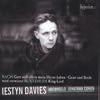
Arcangelo
Dir: Jonathan Cohen
Organ: Tom Foster
Iestyn Davies, Carolyn Sampson, John Mark Ainsley; Neal Davies. Bach Gott soll allein mein Herze haben; Geist und Seele wird verwirret; Schütz Erbarm dich mein, O Herre Gott; Buxtehude Klag-Lied.
HYPERION CDA 68375 TT 65:12
From the very first notes of this recording we know that we are in for something special. Having been awarded an MBE in 2017 for his services to music, and having received a Gramophone Award for the recording of three other Bach cantatas, Iestyn Davies presents two further Bach works alongside music by two of the major influences on his music, Schütz and Buxtehude. Bach’s move to Leipzig in 1723 provided him with the opportunity to achieve his ultimate goal: to conduct ‘a well-regulated church music to the honour of God’. Having considerably better resources at his disposal (although he never stopped complaining!), he started to produce music which would astonish not only the listeners but also, and perhaps more importantly, the people who had to perform it. When listening to the impressive performances of Iestyn Davies and Arcangelo it is quite astonishing to realise that this music would have been sung, more than likely, by a boy of between 14 and 16 years old. When you consider the texts given over to the alto voice in the Passions this would seem to be borne out. Both cantatas not only have challenging music for the alto voice but also a very important role for the organ, here played by Tom Foster. His playing is immaculate, with great attention to articulation, following the lead of the string players just as it should. Much of the music has probably come from pre-existing instrumental concertos, so this is no mere accompaniment to the vocal lines. In fact, there are times when you think it to be the exact opposite. Iestyn Davies’s singing is of course superb, with wonderful attention to the emotions of the texts, both in the Bach and in the music by Schütz and Buxtehude, and the ensemble Arcangelo is first rate under the inspired direction of Jonathan Cohen. Having
listened to this disc, I compared it to another recording of BWV35, the Harmonia Mundi one with Andreas Scholl and Collegium Vocale under Philippe Herreweghe. I find that the new disc has the voice considerably more closely recorded than with Scholl, and I confess to preferring the Harmonia Mundi recording, but only from that perspective. This Hyperion disc is excellent and has the advantage of the extra pieces by the other two composers which are recorded far less frequently.
Nick KerrisonChoir of Jesus College, Cambridge
Britten Sinfonia
Tenor: Ronan Busfield
Director: Richard Pinel
SIGNUM SIGCD 682 TT 42:48
A work of haunting beauty, this Requiem from the pen of Grayston Ives dates from 2008 when it was first heard in Oxford’s Magdalen College chapel, where its creator served as the distinguished Informator Choristarum for nigh on 20 years.

In common with a number of works in the genre, there are two instrumental dispositions – one for harp and organ and the other as here recorded, a sumptuous orchestral texture provided by the acclaimed Britten Sinfonia. In this setting there is a finely crafted harp part, played with the greatest commitment and style by Tomos Xerri. The organ part is in the safe hands of Dewi Rees.
The brief [all too brief] tenor solo comes from Ronan Busfield, a young tenor of immense flexibility possessed of one of the ver y finest natural voices of his generation.
The fabulous fusion of Richard Pinel’s experienced and widely travelled choral forces is a highly welcome feature of this very fine new issue from the Signum label. The more sustained central vocal ranges are well controlled, yet hugely telling, in their impact on the listener throughout. This wholly successful unity of blend between the boy choristers and the soprano choral scholars and the apportionment of segments to the boys alone impresses particularly.
A number of characteristics per vade this lovely music, principally the essentially diatonic nature of the music’s lyrical flow and the effortless ease present right from the outset. The general tessitura for both voices and instrument is in the midst of each range. Where higher ranges and more urgently expressed rhythms are deployed, as in the Sanctus for example, they are made the more effective by their comparative economy of use by the composer, as also in the Cum sanctis tuis which ends the Communio. The Lux aeterna, attached to the Agnus Dei, seems to return to earth following higher registers depicting the ‘eternal light’ of the Latin text.
In contrast to much of the main body of the work, the fer vent Libera me that comprises the penultimate movement uses bolder harmonies and more energised rhythms. Treble voices are used in the expressive and final In Paradisum. Here, the music expands by means of triadic music that proves the more effective in contrast to a single vocal line pervaded by a dewy freshness in the music rarely found elsewhere.
This piece was commissioned by Mark Loveday in commemoration of the 550th anniversary of Magdalen’s founding, celebrated in 2008. The work delights by the sincerity of the musical utterance and a wider use of solely choral textures not found in similar essays. This, alongside a generally prayerful ambience, makes Ives’s expressive fervour all the more telling.
Simon LindleyMusic for Tudor Kings and Queens

Ensemble Pro Victoria
Director: Toby Ward
Magnificat regale; Benedicite! What dremyd I; Alas, for lak of her presens; Most clere of colour; Missa Sponsus amat sponsum (Credo); I love, loved, and loved wolde I be; Sumwhat musyng; Ave lumen gratiae; That was my woo; Salve regina; To complayne me, alas; Maria plena virtute.
DELPHIAN DCD34265 TT 67:07
The great riches here comprise both secular and wellknown sacred compositions from Robert Fayrfax, this duality perhaps presenting the considerable esteem in which he was held during his lifetime. The recital opens with the remarkable Regale Magnificat issued in the mid 20th century in an edition by Dom Anselm Hughes [1889-1974]. For long this version survived in regular liturgical appearances by the St Albans Cathedral choir, with its floridity being more generally favoured at a Saturday afternoon evensong rather than a Sunday liturgy. At St Albans a very short Nunc dimittis arranged by S Royle Shore was normally paired with it, along with a shorter, simpler fauxbourdon, in order to bring Evensong into a more acceptable duration.
For Peter Hur ford’s cathedral boys, the inclusion of so elaborate an essay was something of a point of focus in their termly endeavour, and they undertook its preparation seriously and with, justifiably, more than a mere smidgeon of pride as late 20th-century inheritors of Fayrfax and his long line of successors at the Abbey (now a cathedral). Here on this disc are performances outstanding for both their vocal energy and stylistic élan. Salve, Regina comes wonderfully alive.
Toby Carr’s first-rate lute-playing underpins the setting of the Creed from the Missa Sponsus amat sponsum, but it is the magnificent consort-singing that makes this recorded recital so fulfilling an experience for the listener. Not least among the many joys is the absolutely rock-steady intonation; this, along with the use of precisely etched vocal colour, sets firmly and unequivocally the achievement of the Ensemble Pro Victoria and its enterprising director, Toby Ward, within a class of its own. A real bonus is the excellent and enlightening booklet notes on each work by Magnus Williamson of the University of Newcastle.
Simon LindleyMissa Christ ist erstanden
Cinquecento
Christ ist erstanden (hymn tune); Missa Christ ist erstanden; Rühmbt alle Werck deß Herren; Wann ich nur dich hab; Maria fein, du klarer Schein; Freu dich, du werthe Christenheit (hymn tune); Missa Freu dich, du werthe Christenheit.
HYPERION CDA 68369 TT 64:45
The pan-European choral group Cinquecento, formed in 2004, is renowned as a first-rate ensemble which specialises in the performance of 16th-century music, often by composers who names are unfamiliar. As well as recordings and tours, the singers are the Ensemble in Residence at the church of St Rochus and Sebastian in Vienna, performing a polyphonic Mass setting on a weekly basis.
This is their third recording since 2004 featuring the music of the Flemish composer, Jacob Regnart, born in the middle of the 16th century and one of five musical brothers from a
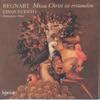
staunch Catholic family. Regnart’s work was highly regarded by Lassus, but he firmly stayed away from the realms of the Lutheran world. In 1582 he had moved from Prague to serve the German Habsburg Court in Innsbruck where he wrote countless mass settings stylistically featuring the contrapuntal density of Gombert alongside compositions where the texture is somewhat clearer and more akin to Lassus.
Perhaps rather surprisingly, the two Easter Mass settings on this disc are based on German hymn tunes. However, Archduke Ferdinand II considered the use of the Lutheran chorale significant as the melodies were familiar.
The polyphonic writing is extremely varied, with both settings making full use of motifs and longer extracts from the chorales, although each is different in character. The Missa Christ ist erstanden for the Easter period is relatively subdued, especially the Agnus Dei, whilst Missa Freu dich, du werthe Christenheit is often more lively and lyrical. Very helpful are the performances of the chorales which precede the settings as they allow the listener to hear the intricacy of Regnart’s writing more clearly.
Inserted between the two larger Mass settings are both shorter religious and secular works. The disc is an excellent example of Regnart’s compositions whilst the performances are complemented by clear and excellent recordings made in the Carthusian monastery on the outskirts of Vienna.
David ThorneRoderick Williams, James Way, Andrew West
Songs of Faith Op. 97; Three Songs of Robert Bridges Op. 43; Four Songs from Shamus
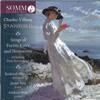
O’Brien Op. 61; Nonsense Rhymes; The Triumph of Love Op. 82.
SOMMCD 0627 TT 78:50
This song recital from baritone Roderick Williams and tenor James Way, accompanied by Andrew West, is a delight. Commendably, almost all the items here are first recordings and they continue the recent resurgence of interest in Stanford’s ‘other’ music, which certainly repays close investigation.
The opening cycle, Songs of Faith (1906), projected by Williams with great conviction, comes across as a significant work, clearly much influenced by Brahms’s Vier ernste Gesänge (1896) (of which more later). One might wish that Tennyson’s poetry in the first three songs of the cycle were slightly more inspired; also, in the latter three songs (words by Walt Whitman), it is slightly disconcerting to hear a different setting of Darest thou now, O Soul, when we all know the Vaughan Williams version (Toward the Unknown Region, dating from the same year) so well, but throughout the six songs and indeed throughout the CD, there is evidence of great musicality and commitment, with crystal clear diction – one really can dispense with the text in the accompanying booklet and just sit back and enjoy the clarity of every word – a rare joy!
The Three Songs of Robert Bridges (1891), also sung by Williams, are in simpler, strophic style, but nevertheless, the final song, Say, O say! saith the music, with its repeating piano ostinato, à la Reynaldo Hahn, is winningly charming.
In comparison, the six songs of The Triumph of Love (1903), sung by James Way, while interesting, perhaps never quite reach the same level of inspiration, thanks to the rather less distinguished poetry of Stanford’s cousin, Edward Gore Alexander Holmes. While not perhaps on the same exalted level as Roderick Williams, James Way invariably displays great
musicality, and is by no means overshadowed by his starry fellow-recitalist, which is saying a lot. Piano accompaniments by Andrew West, often large-scale and almost orchestral in conception, are uniformly excellent.
Stanford wrote as many as ten operas, and they are gradually becoming better known. His first, The Veiled Prophet (1877), had a concert performance at Wexford in 2019, where his Much Ado about Nothing (1900) has also been performed, and in the same year, Somm recorded New Sussex Opera’s performance of his final opera, The Travelling Companion (1916), a significant work, well worth hearing. By far the most successful opera in Stanford’s lifetime was Shamus O’Brian (1895) and four songs from this are divided between the two soloists on this disc. Here we encounter Stanford’s folk-influenced, Irish style of simple phrasing and repeating verses, as in Ochone, when I used to be young – a melancholy jig, if such a thing can be imagined – all utterly charming and highly entertaining. Both singers are great here, but to my ears Williams has the more convincing Irish accent!
The ’Nonsense’ of the CD’s title turns out to be settings of 14 of Edward Lear’s limericks – Nonsense Rhymes – which were songs performed at parties at Stanford’s Kensington home and presumed not to have been written down, until the manuscripts were discovered at Stainer & Bell in 1960 under the pseudonym ‘Karel Drofnatski’ (Stanford!). These are hugely entertaining, mostly comprising pastiches and quotations from a wide range of composers, including quite an extended Handel da capo aria with long semiquaver runs, snatches of Beethoven’s Pastoral and Eroica symphonies and both his and Mendelssohn’s violin concertos, a deliciously queasy mix of Wagner’s Tristan and Tannhäuser, and, significantly, the interval-of-a-third-obsessed Brahms, with his Fourth Symphony, his song Feldeinsamkeit, and yes, the Vier ernste Gesänge, which loomed so large over Stanford’s Songs of Faith Altogether terrific entertainment, wonderfully performed. Very strongly recommended.
Mark BellisMusic by Marco Galvani
Sansara
Dir: Tom Herring
Aleph (Lamentations I and II, Ubi caritas); Beth (Ave sanctissima Maria, Ave maris stella; Alma redemptoris mater); Ghimel (super flumina Babylonis; O sacrum convivium); Daleth.
RESONUS RES 10280 TT 54:47
Marco Galvani is based in London, where he receives commissions from groups and organisations as diverse as the Royal Philharmonic Society to The Sixteen. The information provided in the booklet states that his aim is to reinterpret polyphonic vocal writing for the 21st century while drawing harmonic inspiration from a variety of musical genres. His recent work has explored the integration of this wide-ranging style with electronics.
The sequence is built partly around his setting of the Lamentations commissioned by Jeremy Summerly for the choir of The Queen’s College Oxford in 2013. The complete sequence, featuring a number of contrasting styles combined with highly effective electronic writing, was first performed in the 2016 Passiontide at Merton Festival, though an opportunity to record this only came to fruition in October 2020, the first time the choir had sung together for many months.
The writing is highly distinctive. Combined with the excellent singing of Sansara (a group co-founded and directed
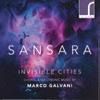
by Tom Herring), it creates a most moving atmosphere at a time when the world was experiencing the crisis of the pandemic.
The potential and more enquiring listener should find this disc most stimulating and much in sympathy with the agonies through which many have lived. Although this is not programme music as such, Galvani’s use of highly inventive contemporary polyphony is both sanguine and stimulating.
 David Thorne
David Thorne
Choir of Westminster Abbey
Dir: James O’Donnell
Organ: Peter Holder
Dove Vast ocean of light; Missa Brevis; They will rise; Weir The true light; His mercy endureth for ever; Truly I tell you; Martin
In the midst of thy temple; The Westminster Service; Sitivit anima mea; O Oriens; Behold now, praise the Lord. HYPERION CDA 68350 TT 70:16
Jonathan Dove (b. 1959) is justly admired for his wonderful anthem Seek Him that maketh the Seven Stars, a work of great mystery and charisma that follows in the footsteps of Arvo Pärt and Henryk Mikolaj Górecki. His hallmarks are endless carillon-like ostinati, joyous (even ecstatic) motifs and festive celebratory moods. This makes his music immediately appealing and exciting. The three works here bear this out, including the very fine Missa Brevis (2009), especially the Gloria, an energetic, surging choral steeplechase. Also, the ethereal They will rise (2018), a commission to mark the centenary of the Royal Air Force, seems itself to take flight, supported by triumphant organ chords and soaring vocal lines. Vast ocean of light (2010) achieves a celestial quality through slowly evolving and complex harmonies and remote tintinnabulations.
Judith Weir (b. 1954), the current Master of the Queen’s Music, adopts a style more closely allied with Howells and Francis Jackson. The true light (2018), another World War I commemoration, is by turns sombre and glowing. His mercy endureth for ever (2015) is also a wartime memorial piece but the mood is more affirmative and upbeat, as is Truly I tell you (2015), which sets several verses from Psalm 8, a celebration of the majesty of creation. The choral writing is strikingly dramatic, with spectacular organ underlinings and interjections. It is good to see the composer’s recent activity in the sphere of cathedral music, after a career devoted largely to opera, and if you admire her early carol Illuminare, Jerusalem (1985) you will not be disappointed with these examples of her mature style.
Nearly half of this CD is devoted to the music of Matthew Martin (b. 1976, and therefore the youngest of the CD’s three composers). He has already had a distinguished career in the world of cathedral music with several significant appointments as organist and choir director. A complete CD of his church music has been released (Opus Arte 9030 D), none of which is duplicated here. He opts for a dramatic style, eclectic to a degree with echoes of Kenneth Leighton, Philip Moore and Francis Grier, but his acute ear has helped fashion an individual voice. Like the composers mentioned earlier, he has a love of ageless tradition. In O Oriens (2012, commissioned by St Paul’s Cathedral) he uses the well-known French melody more familiar to us as ‘O come, O come Emmanuel’ and adapts it with striking originality. Two more commissions, for Westminster Abbey, include The Westminster Service (2013), a work for trebles of great contrast: the energetic and muscular
Magnificat is complemented by an ethereal Nunc Dimittis, the distant-sounding high notes of the boys rocked by a gently chiming organ figure. The large anthem In the midst of thy temple (2019) is notable not only for turbulent interaction between choir and organ but for the inclusion of part of the hymn tune ‘Westminster Abbey’.
This is a superb release of endless variety and interest which deser ves a very high recommendation. The Abbey choir and organ are on top form.
Bret JohnsonAnna Lapwood plays the organ of Ely Cathedral
Ravel Le Tombeau de Couperin; Gowers An Occasional Trumpet Voluntary; Debussy arr Guilmant Andante from String Quartet in G min; K Briggs Light in Darkness; Boulanger Improvisation from Trois Improvisations; Park Images; Britten arr Lapwood

Four Sea Interludes from Peter Grimes; Messiaen arr Lapwood Vocalise-Étude; Frances-Hoad Taking your Leave.
SIGNUM SIGCD 688 TT 68:22
During the first lockdown in 2020, Anna Lapwood regularly ‘tweeted’ videos of practice sessions on her house organ. One of the most memorable was of her playing the Bach Trio Sonatas with a book on her head to encourage better posture! Anna is quickly becoming one of the most prominent exponents of the organ and her encouragement of young people in the exploration of music (in general, not just organ/church music) is to be applauded. This debut album is notable firstly for its programme. No mainstream organ repertoire here but mostly transcriptions of orchestral works. As Anna says in the introduction notes: ‘When selecting the repertoire I was conscious of wanting to choose pieces that showed off a slightly different side to the organ’. Her experience as a harpist in the National Youth Orchestra has clearly influenced her choices: Ravel, Debussy and Britten are the principal composers featured. From the start of the disc the ‘loud and bombastic’ (as she refers to the usual perception of the organ) is replaced by the delicate and intriguing sounds she manages to extract from the organ of Ely Cathedral. Recorded in January 2021, in what must have been a very, very cold building indeed, the performances may well engage a greater audience than many an organ recital. There are original organ pieces, such as Patrick Gowers’ An occasional Trumpet Voluntary and Light in the darkness by Kerensa Briggs, but some of the most fascinating sounds are featured in the transcriptions. The opening of AL’s own transcription of Britten’s Sea Interludes is quite remarkable. On first listening, the organ sounds could be easily mistaken for the orchestral instruments, and the same could be true in Sunday Morning, such is the skill of Anna’s management of the organ. I suspect that actually watching the player would be fascinating, and would further engage a new audience. Perhaps, one day, there will be a video recording! AL details some of the challenges in performing Britten’s orchestral music on the organ and, as she says, ‘It requires quite a lot of gymnastics’. This first disc is to be applauded for its astonishing performances.
Nick Kerrison
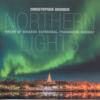
Christopher Herrick plays the organ of Nidaros Cathedral
Mons Leidvin Takle Yes!; Farrington Amazing Grace; Dubois Fiat lux; Christian Praestholm See the golden sun rising from the ocean; The sun is rising in the east; Lord, you give us life and happiness; Percy Fletcher Fountain reverie; Festival toccata; Anders Börjesson Toccata; Hans-André Stamm Toccata giocosa; Gigout Toccata in B min; Brahms Prelude and Fugue in G min; Yon Second concert study ‘Flying feet’; Sverre Eftestøl Wedding March.
HYPERION CDA 68376 TT 71:58
Yes! by Mons Leidvin Takle provides an arresting start to this programme, the emphatic character of the title being fully reflected in the music. The outer sections have a distinctly Spanish flavour, while the central episode is reminiscent of Sousa; maybe the composer’s studies in the US are achieving expression here. Anyway, that doesn’t sound as though it should work, but it does – triumphantly. This is a fabulous piece which any recital audience surely would relish – why is this composer not better known? Iain Farrington’s Amazing Grace, a substantial reflection of nearly eight minutes, is also delightful with its jazz and blues inflections creating an immediate appeal.
It was a good idea to preface the three hymn preludes by Christian Praestholm with the hymn tunes themselves, unfamiliar to most UK ears. Their varied styles are traditional, but none the worse for that – they speak directly and effectively to the listener, especially in these persuasive performances.
In a brave piece of programming there are four consecutive toccatas in the middle of the disc but, such is their variety, the idea works. The pick of them is the light-hearted and tuneful Toccata giocosa of 2009 by the German composer Hans-André Stamm, which has a zestful rhythmic vitality.
Much of the interest of the disc lies in the Scandinavian repertoire, so enjoyable yet so unfamiliar to British audiences, but there are also master ful performances of music by Dubois, Percy Fletcher, and Gigout. Only Brahms’s Prelude and Fugue in G minor fails to maintain the interest but, meaning no disrespect, this is due more to the composer than the performer. Pietro Yon’s Second concert study ‘Flying feet’ surely lives up to its name, and the disc ends by returning to Norway, with the charming and understated Wedding March by Sverre Eftestøl. The large organ (32 pedal stops!) by Steinmeyer (1930) is certainly put through its paces, and it emerges with flying colours, as do performer and engineers.
Christopher BartonTHE FOREST AT DAWN
Organ works by Andrew Downes
Robin Walker plays the organ of Ely Cathedral
Prelude: The Forest at Dawn; Prelude, Fanfare and Postlude for Organ; Introduction and Allegro for Solo Organ; Sonata for Organ.
REGENT REGCD 559 TT 49:22
A very wide range of Andrew Downes’s output for solo organ is essayed by Robin Walker on the kaleidoscopically varied timbres of the Ely Cathedral Harrison instrument, here brilliantly caught by recording engineer Miles Eastwood. The

iconic 1908 instrument has received two major schemes of restoration and refurbishment; during the second, between 1999 and 2001, the Great reeds, the Choir Cremona and the Swell Vox humana were provided with new pipework and the mixture work has been widely re-modelled. The Positive division received attention to enable it to be better drawn into the tonal scheme of the instrument. The result is as stunning to the listener within the building as on this fine and wellbalanced recording.
The eponymous work, The Forest at Dawn, is a traditional tone-picture of persuasive beauty and was commissioned by the Royal College of Organists for their Millennium Organ Book anthology.
The trilogy that follows, written for John Bishop, received its first hearing at Birmingham Cathedral. The initial Prelude continues very much in the same vein as The Forest at Dawn, though proves to be rather more animated. Dotted figures pervade the Fanfare at its outset and a wider tonal focus is explored here in comparison with the initial music on the disc. The opening movement of the 1975 Op. 9 work and the Postlude unfold from a single melodic line in the tenor register, with the latter closing with a magically extended cadence which ends on the softest of undulant string registers.
The Introduction and Allegro is more energised and, as such, is particularly well placed within the programme as a whole. Throughout, the influence of the style of Herbert Howells is ever present. The final work is a sonata dating from 2006 written for American organist Carson Cooman with the organ of Harvard University Memorial Church in mind. Two slower extended movements enclose an Allegro vivace of energy and greater momentum, though at its heart comes a more sustained central passage.
Additional to his influence over a lengthy period as Head of the School of Composition and Creative Studies at Birmingham Conservatoire, Andrew Downes’s compositional portfolio bespeaks his roots in the English musical tradition. The versatility of organist, conductor and teacher Robin Walker has done a signal service in bringing this evocative repertoire, and the tradition it represents, before wider public notice. The quality of the informative inlay book, with informed and helpful contributions by Duncan Honeybourne as well as some from the composer and player, is a real delight, visually as well as aurally.
Simon Lindley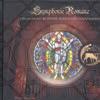
Peter Stevens plays the organ of Buckfast Abbey
Dupré Cortège et Litanie; Deuxième Symphonie; Widor Symphonie Romane; Tournemire Fantaisie-Choral.
Ad Fontes (AF006) TT68:55
Martin Baker gave the inaugural recital on the organ of Buckfast Abbey built by the Italian firm Fratelli Ruffati in March 2018. It is regarded as one of the most prestigious instruments in the south west, consisting of an extensive Quire organ, partly designed to enhance the liturgical aspect of the Abbey’s monastic tradition, and a Grand-Orgue in the West Gallery, built and voiced on the principles of the great French Romantic builder, Aristide Cavaillé-Coll.
This 2020 disc, featuring the fine technique of Peter Stevens and distributed by the Abbey’s in-house Ad Fontes label, concentrates on works mainly composed in the early part of the 20th century French School. Widor’s 10th Symphony, the Symphonie romane, serves also as the title of the disc.
Probably the most well-known and appealing work is Dupré’s Cortège et Litanie, which opens the programme. This performance, although atmospheric, skilfully avoids the temptation to over-milk both its melodic line and the succulent harmonic structure. As in other works on the disc, however, the detail is sometimes blurred and even partially lost in the crescendo towards the end of the work.
Widor’s Symphonie romane is probably less well known to most listeners than movements from his other symphonies. It is built on the motif from the Easter gradual Haec dies, and is regarded as one of his finest works, having been recorded by several leading organists. Although this performance is good, the first three movements feel just a touch laboured and moreover, for diverse reasons, there is a distinct lack of clarity and much of the left-hand passage work in the second movement is lost. It is possible that the organ, despite its versatility and French design, may not be the best instrument on which to hear this work, especially for listeners unfamiliar with it.
In contrast, the Tournemire is arguably one of the most successful tracks on the complete disc, Stevens’ interpretation following both Tournemire’s metronome and registration marks very closely. The Dupré reveals the player’s superb technique, especially taking into account the considerable technical challenges the work presents. Musically, the dramatic interpretation of the Preludio is highly successful, combining the use of the highly effective string section within the softer passages, whilst the Intermezzo catches the cheekier element of the opening theme. The performance of the Toccata is quite dazzling!
Despite some disappointing elements within this recording, the quality of the Ad Fontes label within its own right is extremely fine, ranging from the inclusion of the disc in a hardback book to the excellent essay written by Peter Stevens, complete with impressive photographs.
David ThorneMarkus Kühnis
(All arr. Kühnis) Rossini Overture ‘William Tell’; Bach Sheep may safely graze; Badinerie from Orchestral Suite No. 2; Dvorak Slavonic dance in G minor; Bizet Jeux d’enfants (Petit mari, petite femme; Le bal); Sousa Washington Post; The Stars and Stripes forever; Rimsky-Korsakov Flight of the Bumblebee; Genaro Codina Marcha de Zacatecas; Ponce Intermezzo No. 1; Gavota; Zequinha de Abreu Tico-tico no fubá; Alford/Lefèvre Colonel Bogey and the Gendarmes of St Tropez; Handel Music for the Royal Fireworks; José Pablo Moncayo Huapango; Gottschalk Tournament Galop.
WILLOWHAYNE WHR066 TT 72:13
We are firmly in the realm of the theatre/cinema organ here, with a programme of 18 mostly very brief, highly contrasted ‘lollipops’, all transcribed by the performer, Swiss organist Markus Kühnis, who plays the largest organ in Switzerland, that at Engelberg Abbey – originally by Goll (1876) but much enlarged. There is considerable virtuosity on display here, though some of transcriptions are rather free, for instance the William Tell Overture is subjected to not only fairly drastic cuts (just about acceptable), but additional, new oompah pedal parts and changed harmonies, which sensitive listeners might baulk at.
Surprisingly, some of the five Mexican/Latin American arrangements work very well – Ponce’s delightful Intermezzo No 1 – originally a piano piece – provides a lovely moment of welcome repose between somewhat rowdy renditions of
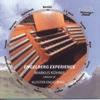
Sousa marches (who knew, incidentally, that The Stars and Stripes forever is used in Germany to advertise a cleaning fluid, Der General ?!). Throughout the CD, occasional slight pauses at the ends of phrases (for changes of registration, one supposes) threaten to become something of a mannerism and sometimes inhibit forward momentum, but there is always an undeniable high-spirited sense of fun. Jose Pablo Moncayo’s Huapango, though repetitive, is catchy and effectively played on this highly colourful, orchestrally-conceived instrument and this disc will certainly recommend itself to aficionados of short, lighter organ arrangements.
Mark Bellis
Stephen Farr plays the organ of St Albans Cathedral
Sonata for Organ; Laudate Dominum; Fanfare de Maris; Pastorale; Impromptu; Variations and Fugue on ‘East Acklam’; Five Sketches on ‘Helmsley’; Soliloquy; Sinfonietta.
RESONUS RES 10284 TT 78:03
Philip Moore (b. 1943) is deservedly recognised as one of the leading musicians in the Anglican church today. His long career as organist and director of music at Guildford Cathedral and York Minster has been complemented by an equally long one as a composer. His output of choral music is now very large, of great variety and consistently high quality. His large-scale pieces include a 50-minute Requiem (2015), an hour-long Passiontide meditation, Via Crucis, for organ (2021), an organ concerto, an oratorio De Profundis and an Ode on St Cecilia’s Day (2010).
His solo organ works are also numerous, and this latest collection explores music written over a period of more than 35 years, commencing with the 1982 Organ Sonata. In an interview in 2009 Moore acknowledged his indebtedness as a composer to Alan Ridout (1934-96), with whom he studied and
later worked when he was Assistant Organist to Allan Wicks at Canterbury Cathedral in the late 1960s. Ridout’s organ music was championed by Dr Wicks, and Moore’s Sonata has some parallels with The Seven Last Words which Wicks recorded in 1969 in the Great Cathedral Organ Series. The Sonata opens with the same sense of urgency and unease, giving way to an open-textured, almost Hindemithian slow movement, and a rondo-type finale. Another work from this period, Five Sketches on ‘Helmsley’, is a complete set of variations in which the well-known hymn tune is skilfully disguised with stretti and other techniques. Many of his pieces are tributes to those he admires, and Soliloquy (1982) is a musical acrostic based on the surname of Dr Francis Jackson, whom he succeeded at York Minster in 1982. Also on the CD is the set of Variations and Fugue on Jackson’s famous hymn-tune ‘East Acklam’, and there is an Impromptu, dedicated to Jackson on his 70th birthday in 1987, mirroring exactly the piece Jackson wrote as a 70th birthday tribute to his predecessor, Edward Bairstow, back in 1944. Both the Impromptu and the Variations reflect and affirm Jackson’s style and technique, but very much in Moore’s own way.
Sinfonietta (2001) is one of Philip Moore’s most austere works, with serialism and other twelve-tone devices in evidence, perhaps again evoking the spirit of Alan Ridout, even Peter Racine Fricker. The threads of continuity run through all these pieces, and the triumphant thread is heard to great effect in two short recent pieces, Laudate Dominum (2014) and Fanfare de Maris (2018), both of which celebrate organ trumpets.
This is a most rewarding CD of organ music of quality and variety by a composer whose name is regularly encountered in the music lists of cathedrals up and down the land. He could not find a finer champion than Stephen Farr, himself a former organist of Guildford Cathedral, whose performances are immaculate. The St Albans organ’s tonal and dynamic range is imaginatively displayed to its fullest effect. Highly recommended.
Bret JohnsonThe composer writes: ‘This recording of some of my choral works was made in the summer of 2021, with a small and expert group of singers and organists. As can be readily imagined in the middle of a worldwide pandemic, the experience was beset by logistical issues: there were problems of travel, accommodation, musical preparation, and venue availability. That it happened at all is surprising. That it has proved to be such a fine record of challenging times is miraculous, and a credit to the energy and expertise of all concerned.’
‘Belfast Cathedral choir is an ensemble of high quality… The choir’s tonal purity and impeccable tuning are a pleasure.’ BBC Music Magazine
The CD will be reviewed in CM 2/22. The Northern Ireland premiere of An English Passion took place in April 2022.
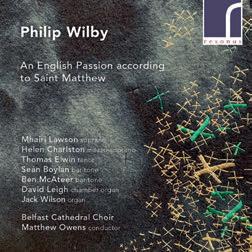

18th March - 22 October




World renowned choir The Sixteen presents a powerful and emotional programme of English choral music centred around Hubert Parry’ s heartfelt Songs of Farewell. For a full list of tour dates and locations visit t thesixteen.com



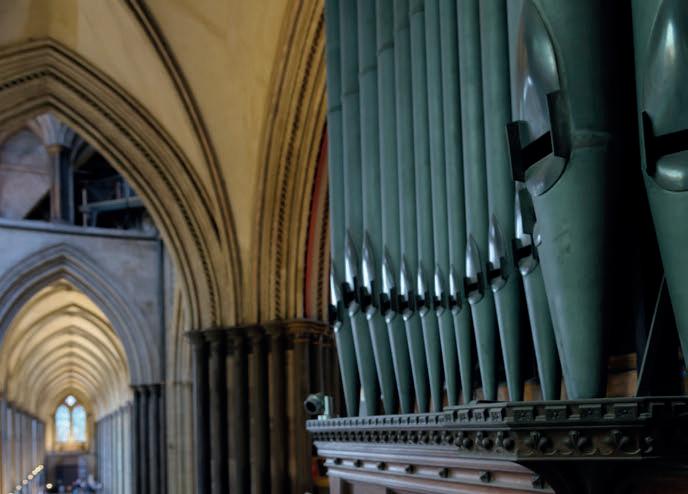



Choral Music by Darke and Duruflé

The Choir of Guildford Cathedral
Chameleon Arts Orchestra directed by Katherine Dienes-Williams
REGCD563
The first recordings of two major works for choir and orchestra by Harold Darke, ‘As the Leaves Fall’ and ‘The Kingdom of God’. These sit alongside the Requiem – in the 1961 version for mezzo-soprano, choir, organ, and small orchestra – by Darke’s slightly younger French contemporary, Maurice Duruflé.
Give thanks for the ministry of clergy and their families during the pandemic at 5pm on 24 May 2022. The cathedral choirs of Liverpool, Southwark and St Paul’s will sing and the Dean of St Paul’s will preach.

Book tickets for the Service (free) and Dinner (£100pp) at www.clergysupport.org.uk/festival
‘There’s a serene, reflective and reverential quality to his writing which conceals an underlying layer of phlegmatic and stolid power… Hard to believe that a piece of music this well conceived has not been recorded before.’ Classical Music Sentinel, January 2022
Thomas Trotter plays the organ of Symphony Hall, Birmingham
REGCD566
Organ music –magical, symphonic, dancing, and jazzy –from one of the world’s great wizards of the organ, Thomas Trotter, performed on the magnificent 2001 Klais organ in Birmingham’s Symphony Hall. The Sorcerer’s Apprentice Dukas arr. Trotter; Symphonie V, Op. 42, No 1 Widor; Five Dances for organ Gardner; Fantaisie in E flat major Saint-Saëns; Serenade, Op. 22 Bourgeois; Dances from Dansereye Susato arr. Trotter; Mozart Changes Zsolt Gárdonyi; Sweelinck Variations, Op. 96 Rachel Laurin
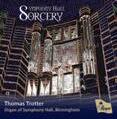
‘... Wurlitzer-like washes of sound in the Jazzy Mozart variations here, you get full-on symphonic assaults in the Widor and Sans-Saëns, fabulous wit and colours in Trotter’s own transcription of the Sorcerer’s apprentice as well.’ Andrew McGregor, BBC Radio 3 Record Review, February 2022
Charles Wood Singers

Philip Scriven (organ) directed by David Hill

REGCD567





Magnificat in B flat; Eternal Father Stanford; Expectans expectavi Wood; It were my soul’s desire Wood arr. Philip Moore; O Thou the central orb; Oculi omnium; Nunc dimittis in B flat Wood; Let this mind be in you; Bonum est confiteri; Deus miseratur; The Canticle of the Sun Amy Beach
REGENT RECORDS, PO Box 528,Wolverhampton, WV3 9YW 01902 424377 www.regentrecords.com (with secure online ordering). Retail distribution by RSK Entertainment Ltd, Tel: 01488 608900, info@rskentertainment.co.uk. Available in the USA from the Organ Historical Society www.ohscatalog.org. Scan QR code to sign up to our mailing list
